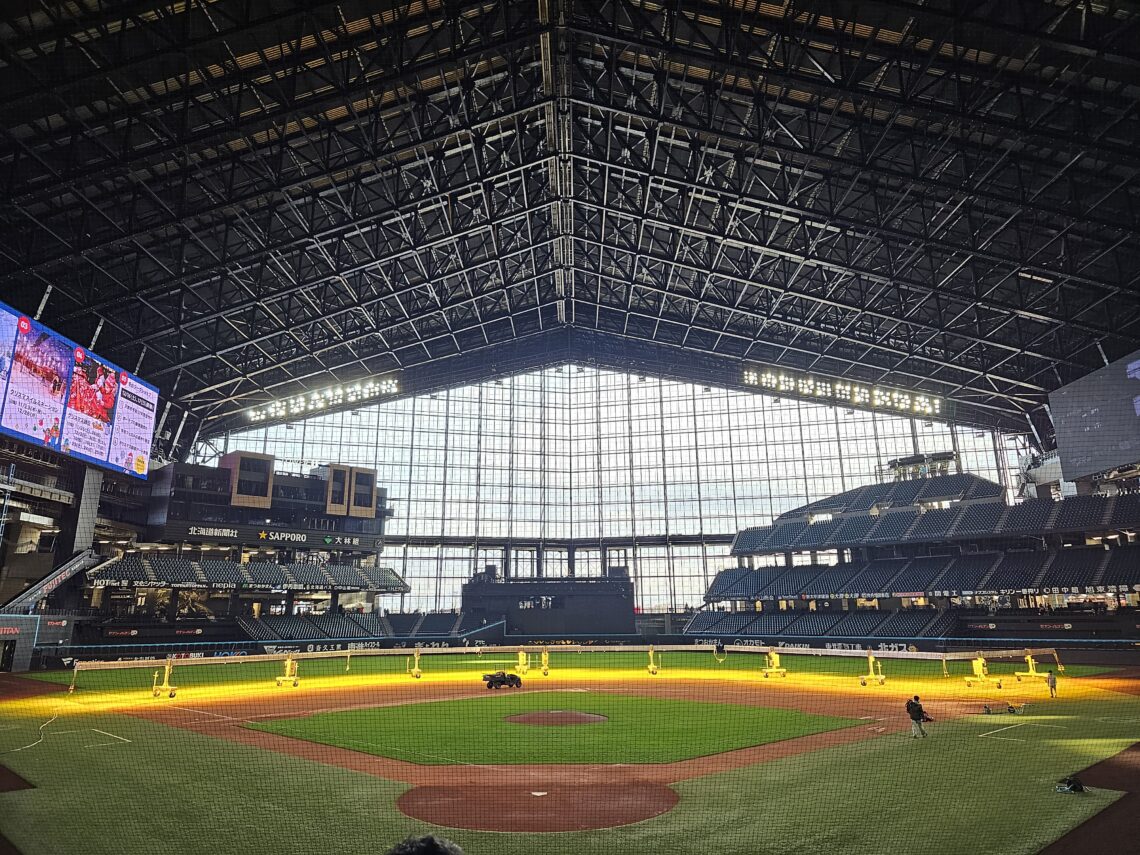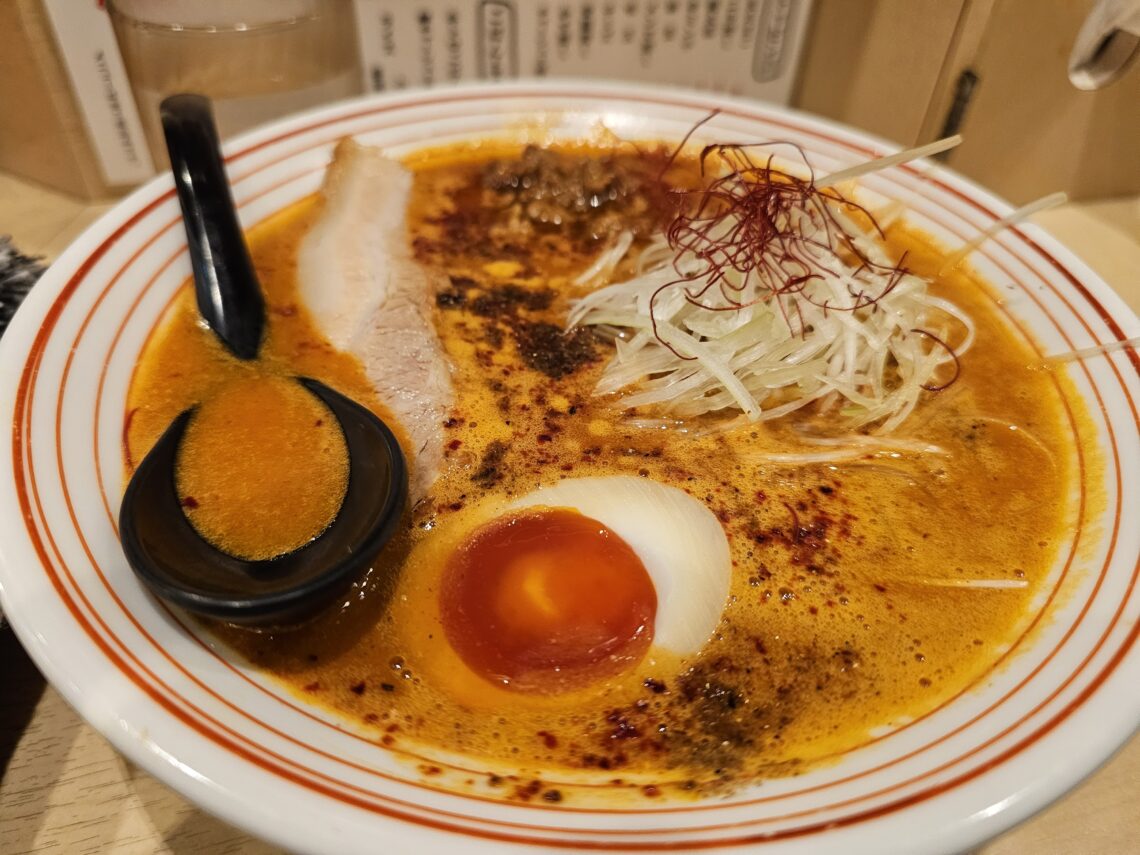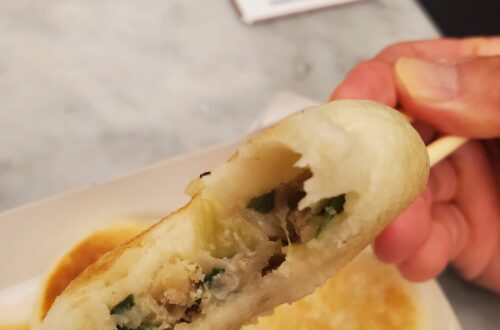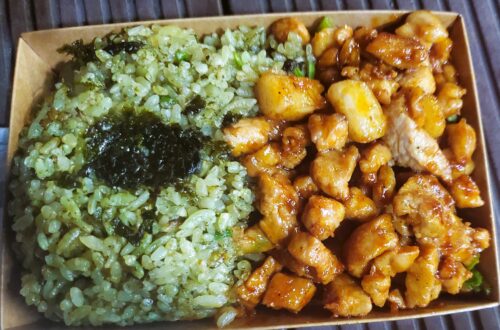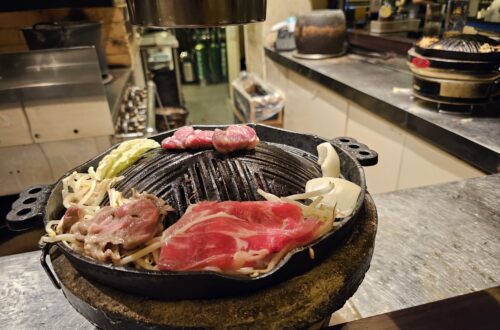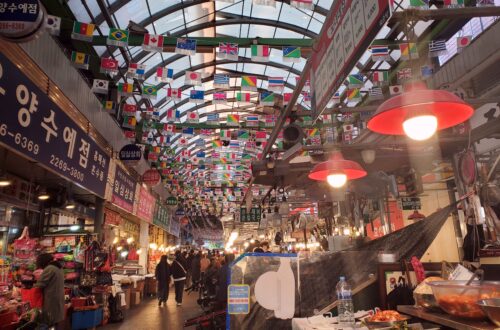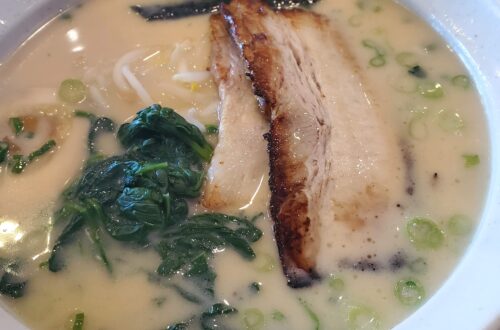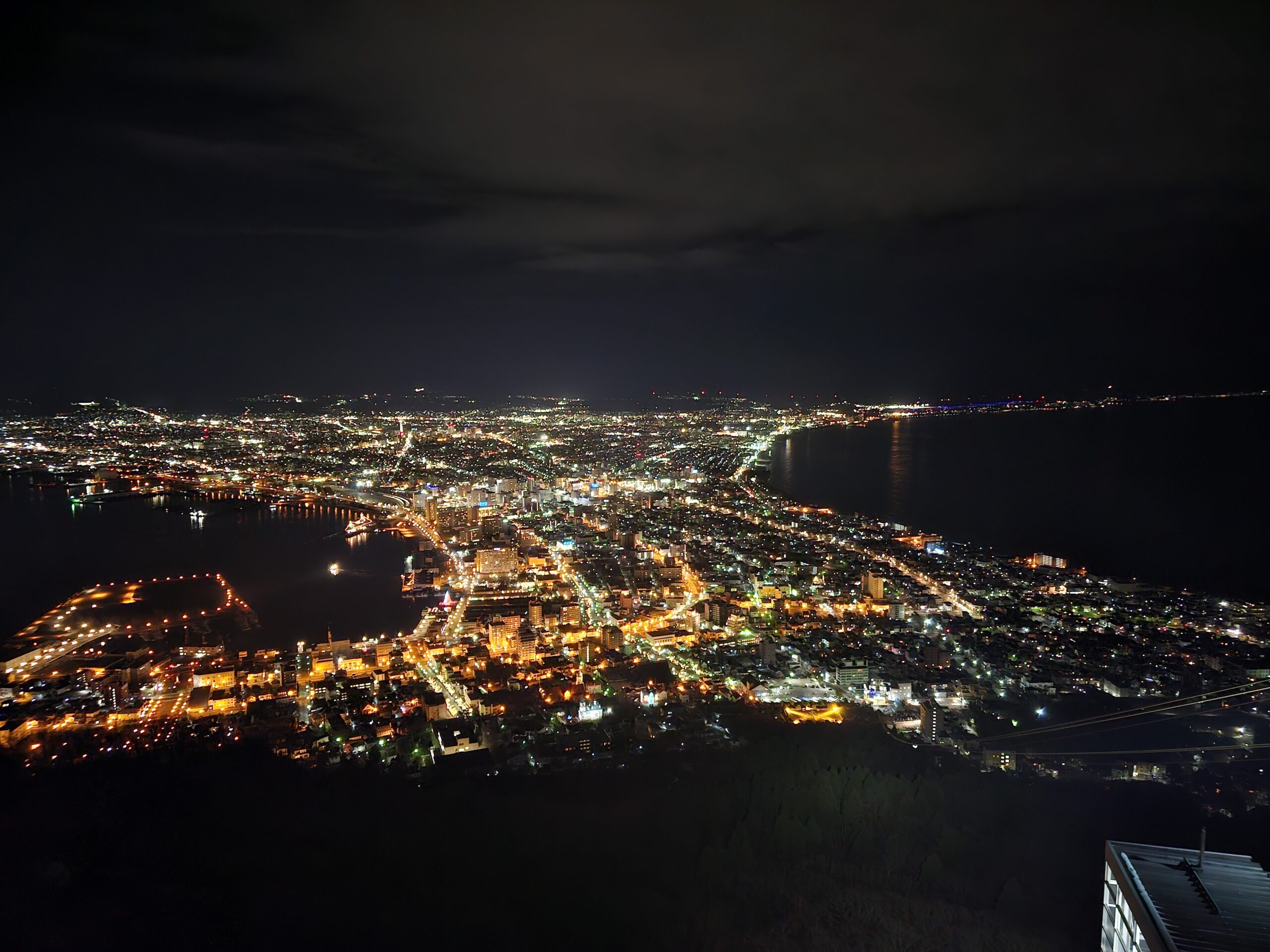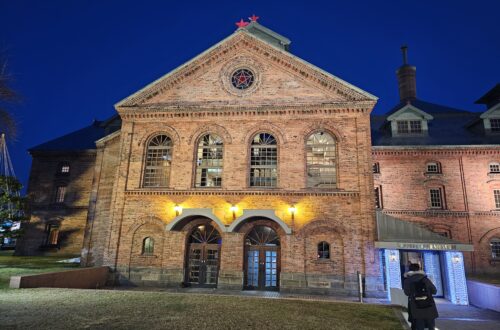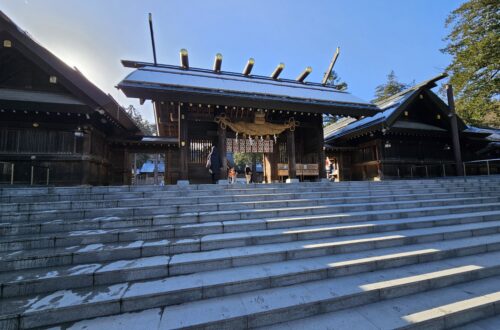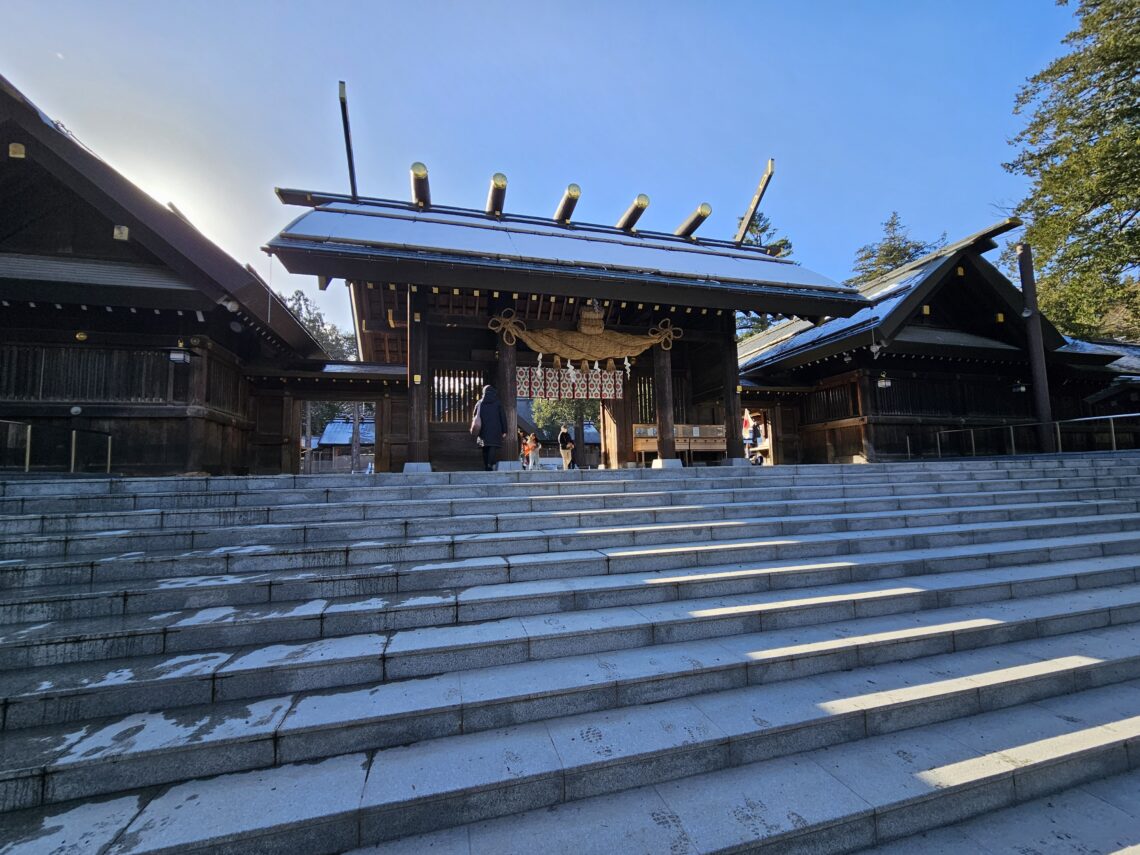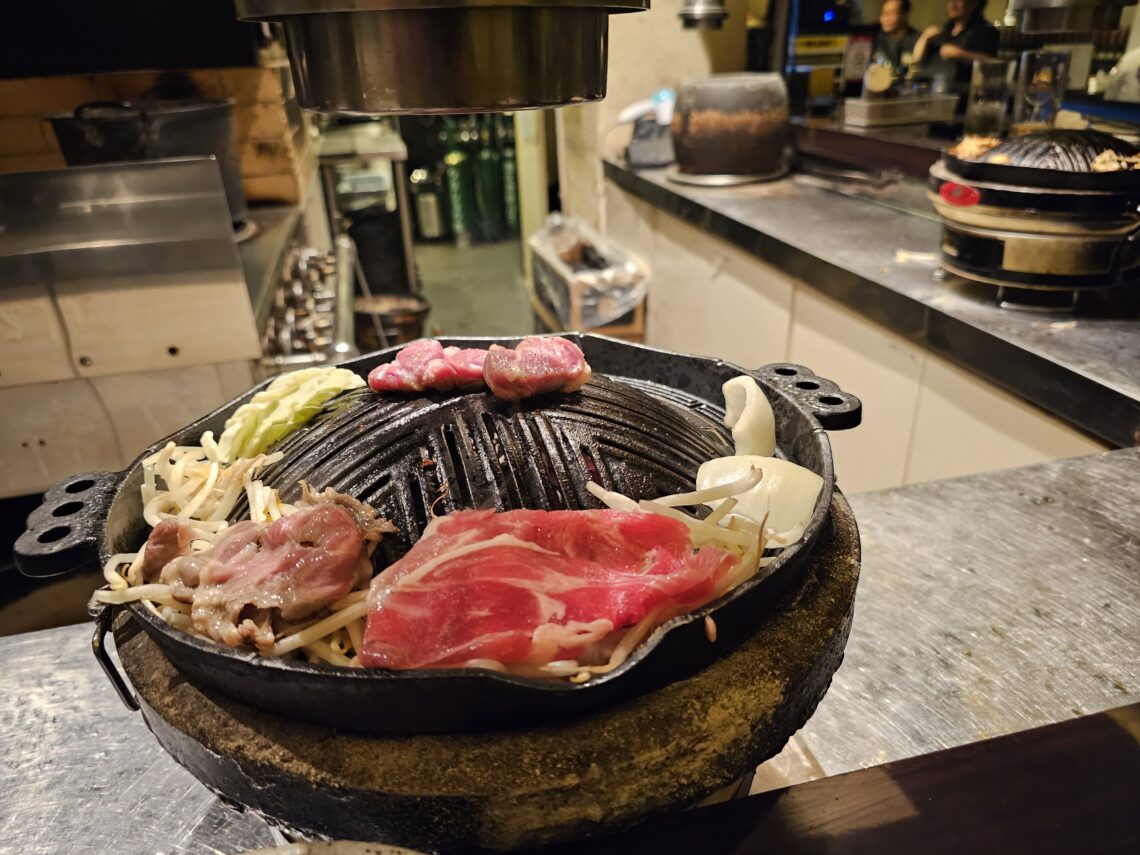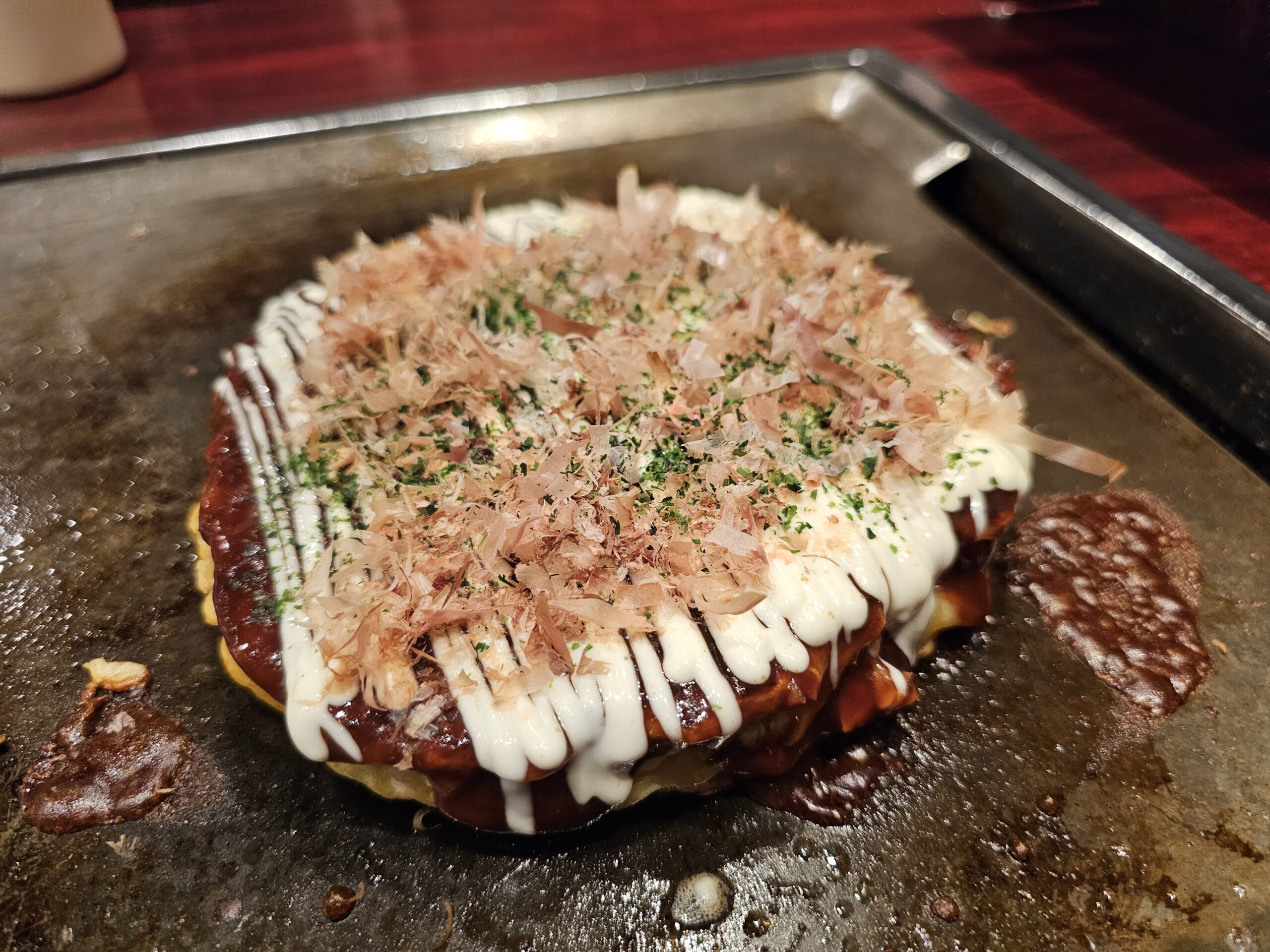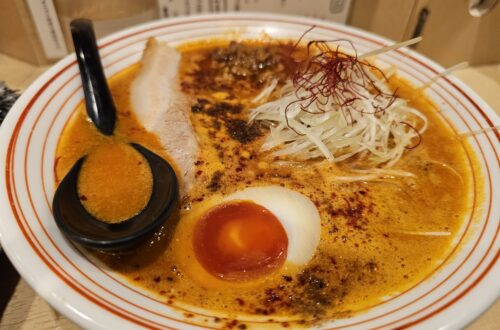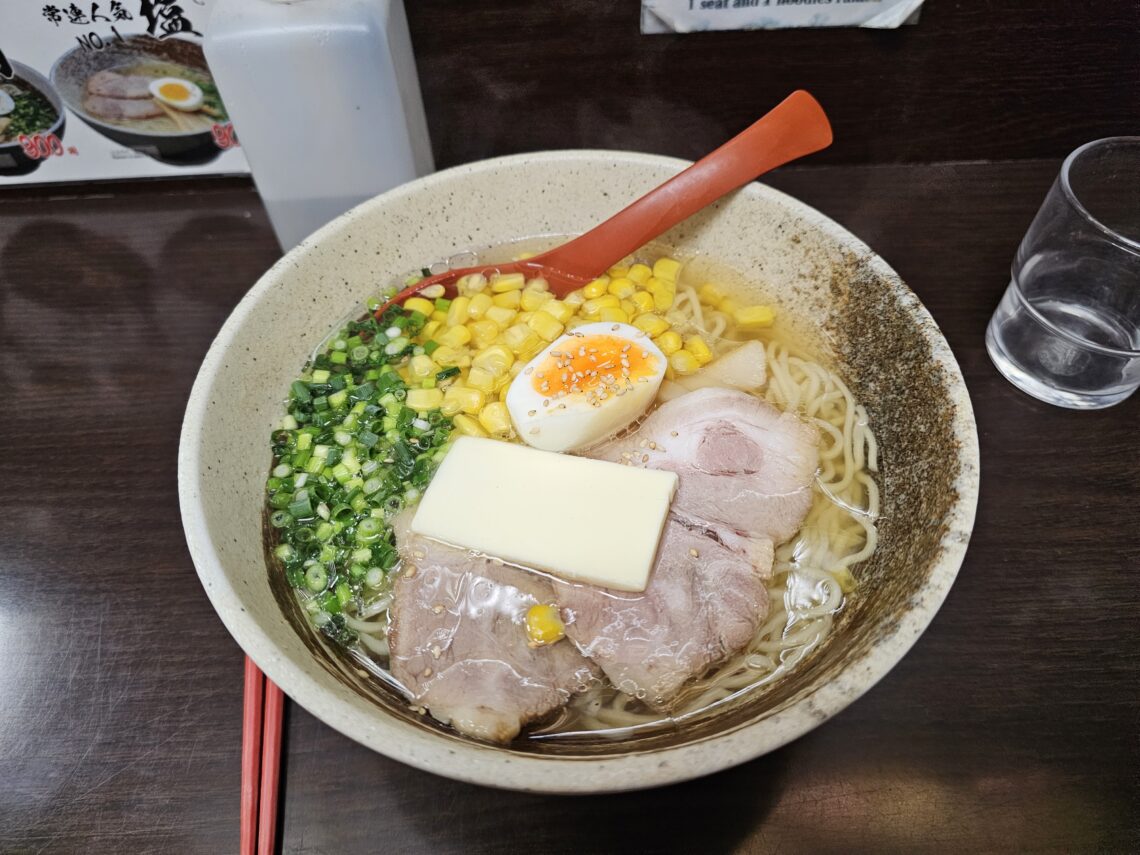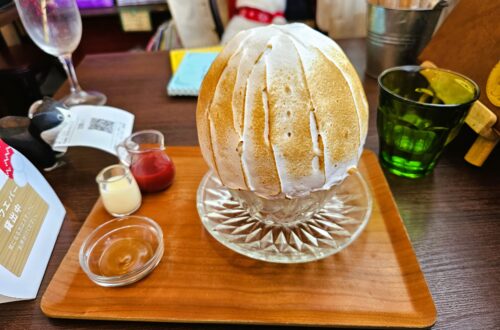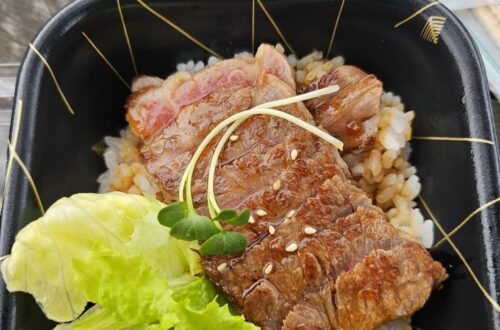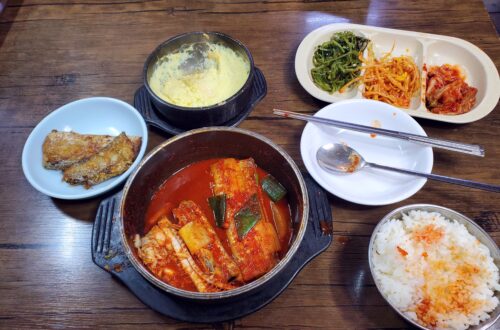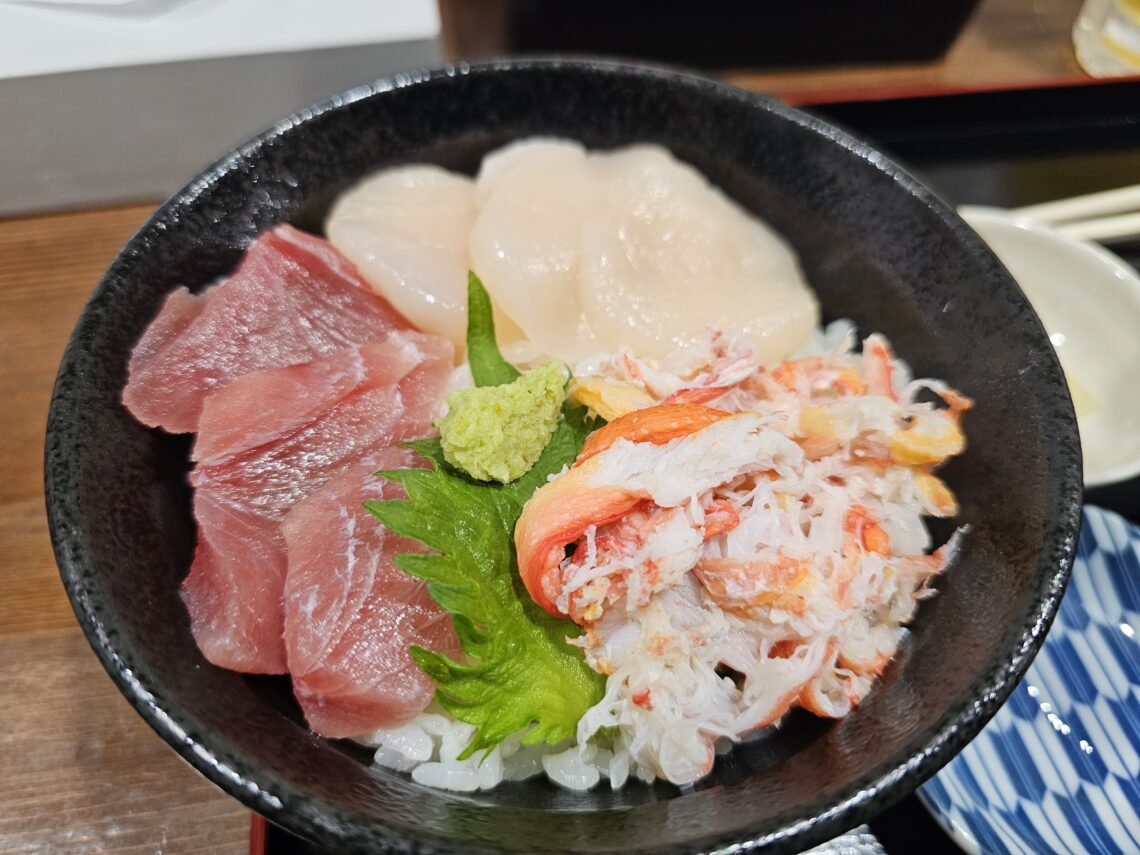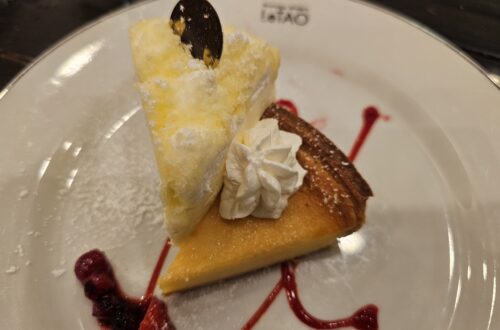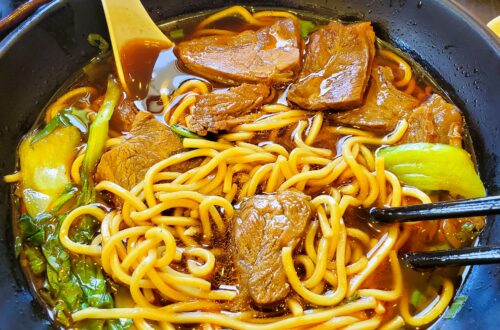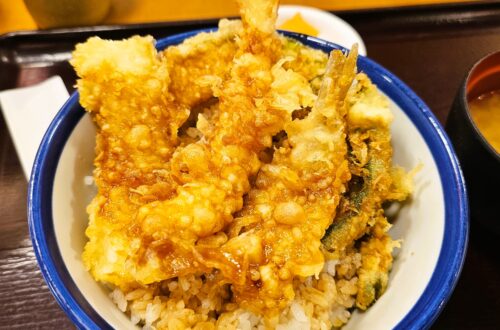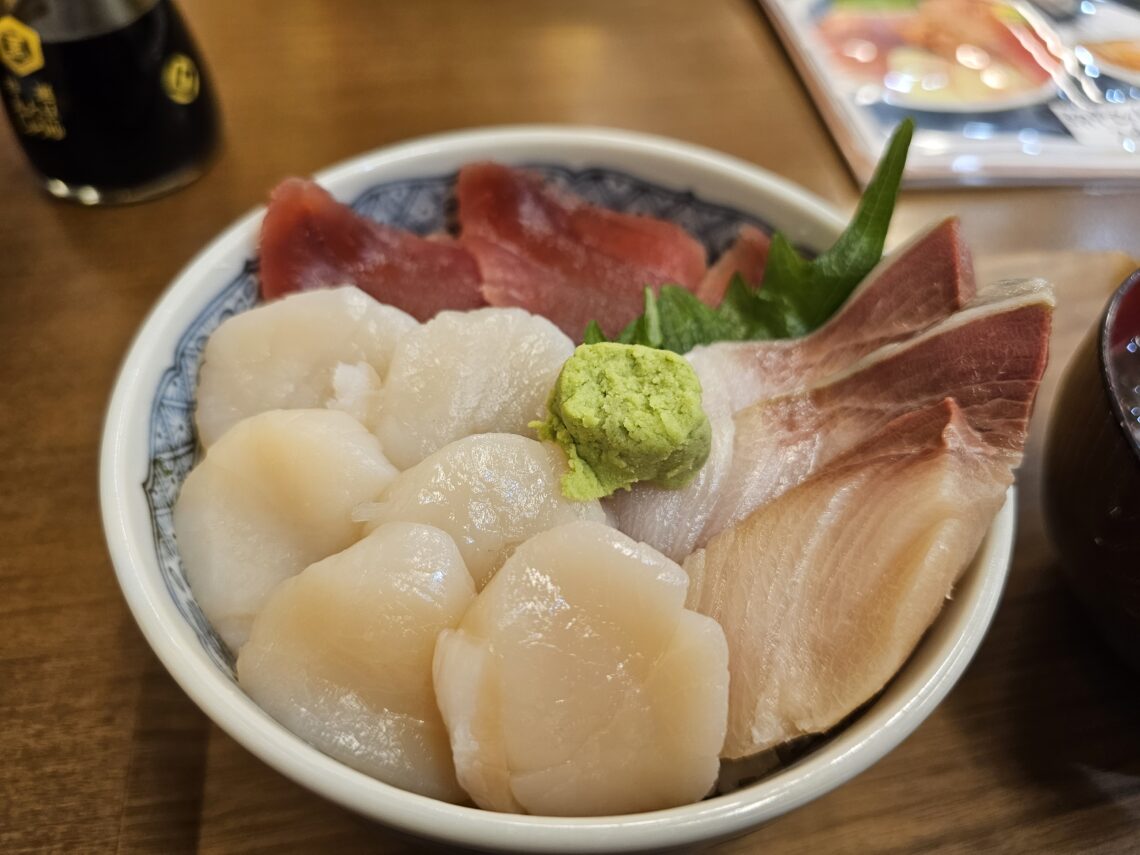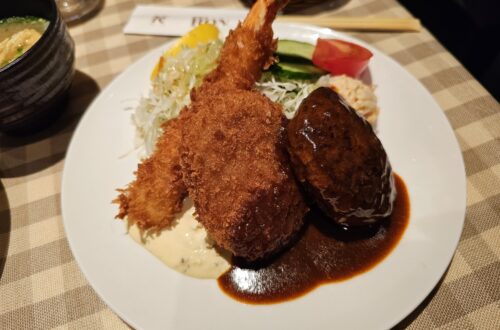-
Es Con Field Hokkaido Home To The Nippon Ham Fighters Is A Must Visit
The Nippon Ham Fighters are a Nippon Professional Baseball team (NPB, Japanese pro baseball) that are located in Sapporo, Japan. Having played their games in the Sapporo Dome since the team re-located from Tokyo to Sapporo back in 2004, the Fighters unveiled Es Con Field Hokkaido to kick off the 2023 season. I went and visited this stadium during the off-season and was very impressed with everything it had to offer!
The Background
Construction for Es Con Field Hokkaido began in May 2020 and was completed in January 2023, just in time for the 2023 season. The newest stadium in the NPB boasts a seating capacity of 35,000, has a retractable roof, and natural turf (a rarity for an NPB team). The field dimensions are as follows: left field 318 ft, center field 397 ft, right field 325 ft.
The standout feature of the stadium is the massive glass wall in the outfield. It essentially runs from left field to right field and it’s absolutely HUGE. When inside the stadium, it’s really a sight to behold and provides great natural lighting.
Outside The Stadium
The surrounding area is lush with greenery so the background setting of the stadium is quite peaceful when outside the stadium. There’s a couple of shops and restaurants next to the stadium and even a hotel that is directly next to Es Con Field Hokkaido. There’s a kids playground, a small pond surrounded by what looked like outdoor suites which were just a large room with a TV and deck with bbq. I’m not exactly what these were. I’d be interested to see how they’re utilized on game day.
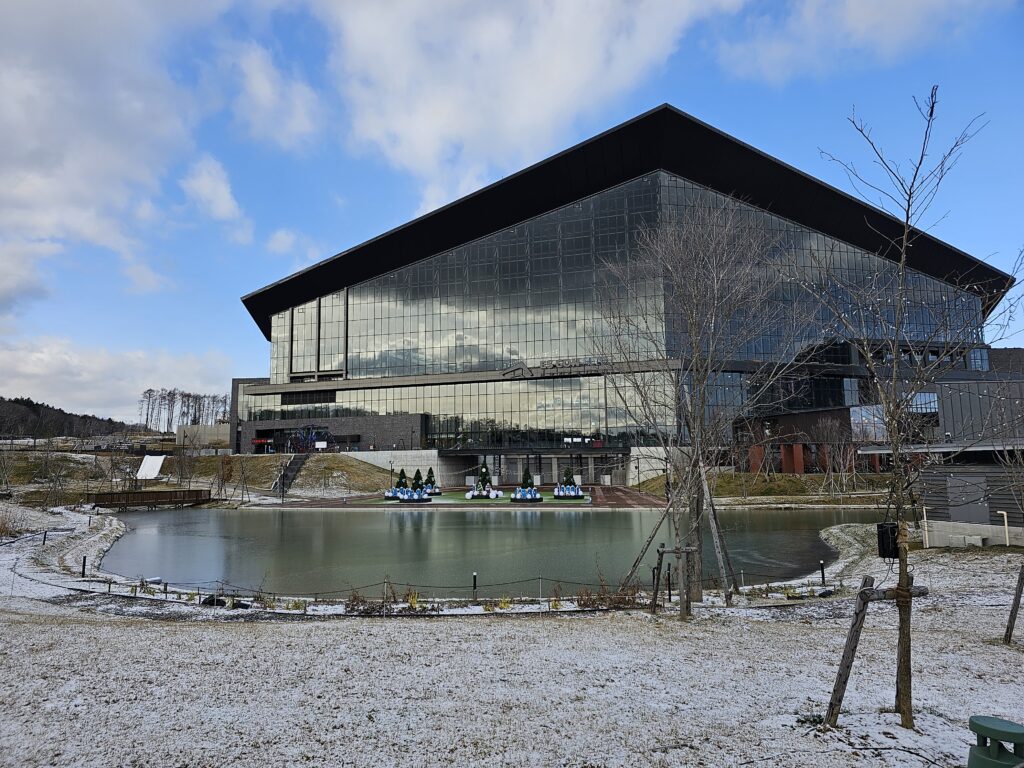
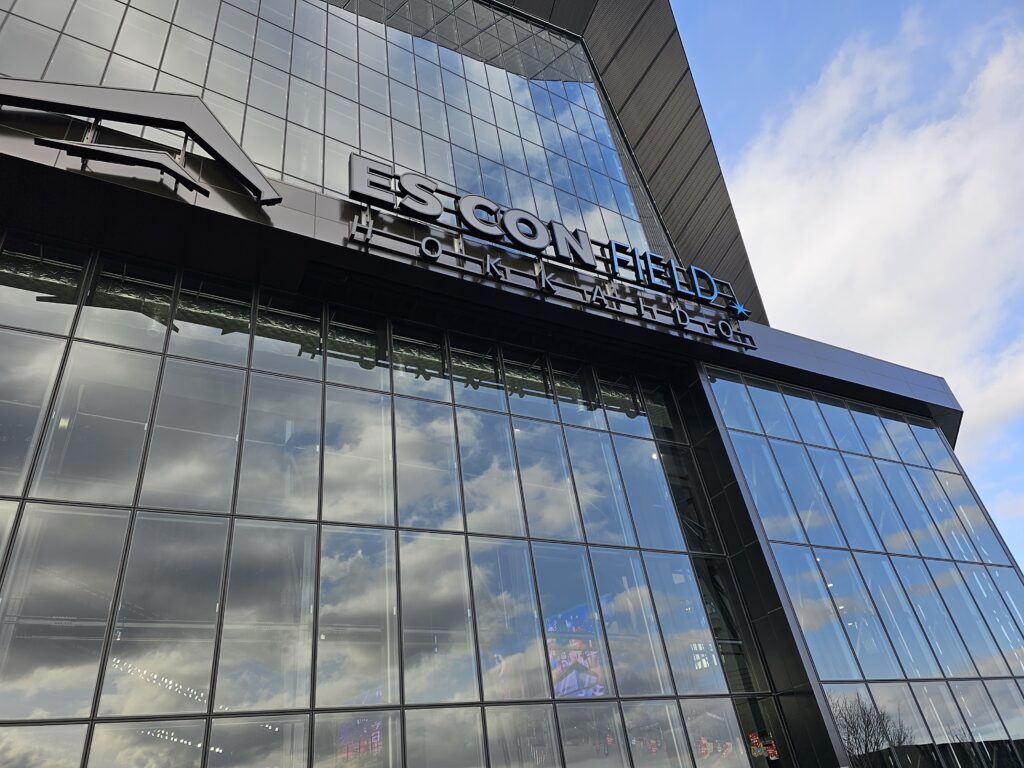
I’d expect this area to be further developed in the future since there’s a lot of space within the vicinity.
Es Con Field Hokkaido is a little bit of a trek since it’s not in central Sapporo and doesn’t have a direct station. The nearest station is Kitahiroshima station which will be about a 20-minute walk to the stadium. I didn’t mind this walk since the area here is peaceful. During game days the walk would most likely be quite fun with boisterous and excited fans making the walk together. During the season I’m guessing they must have shuttle services from the station to the stadium but in those times it may just be faster to walk.
Inside the Stadium
Something that was pretty amazing to me about Es Con Field Hokkaido, outside of how great the exterior looked, was how accessible it was to the public in the middle of December. You could literally walk in through one entrance that takes you to the left field seats which were open to sit in. You could walk the concourse from left field to right field and along the first base line before areas were roped off.
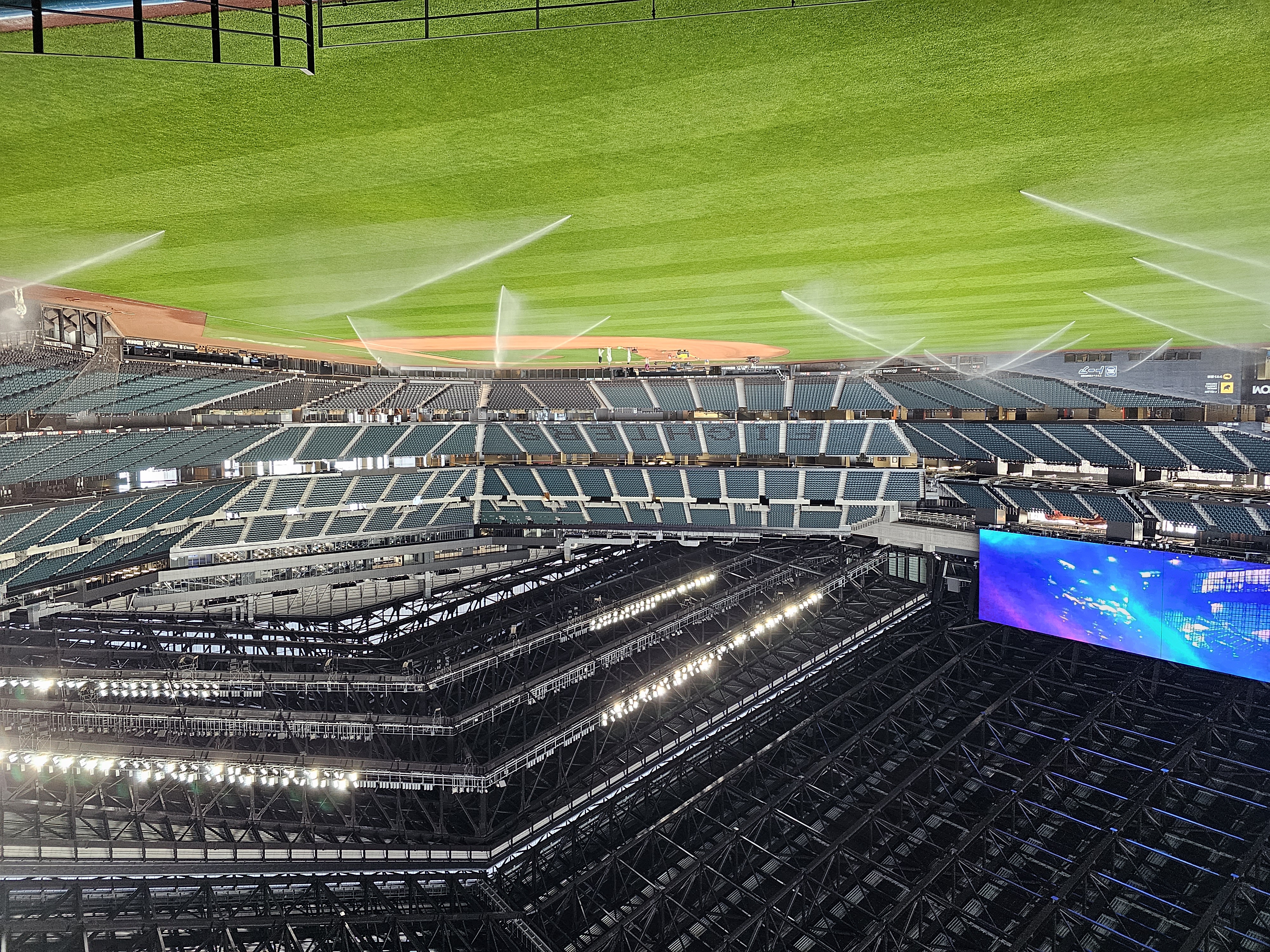
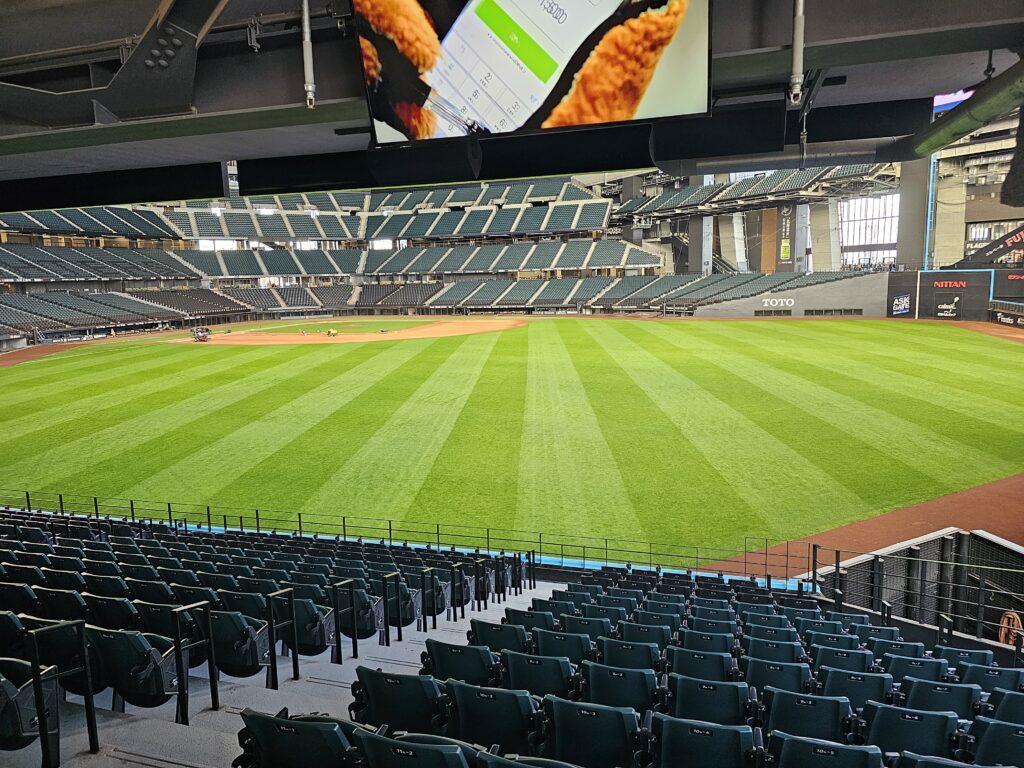
The team store is massive, with a ton of Fighter apparel and souvenirs, really cool and it’s two stories as well!
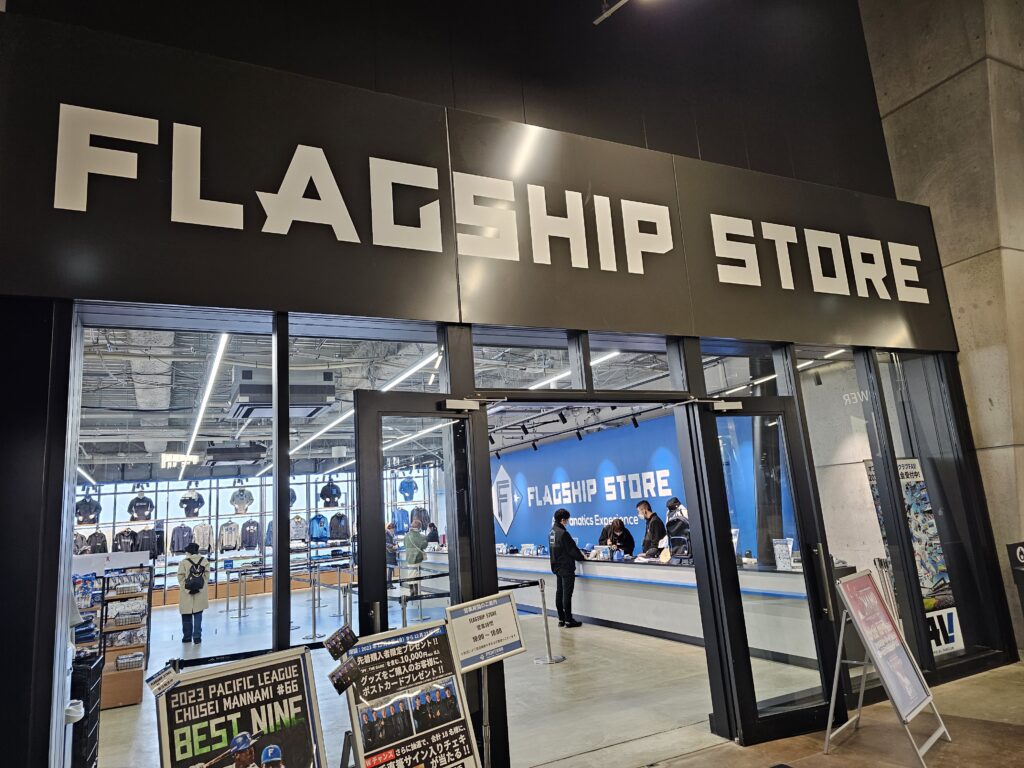
The front of the team store 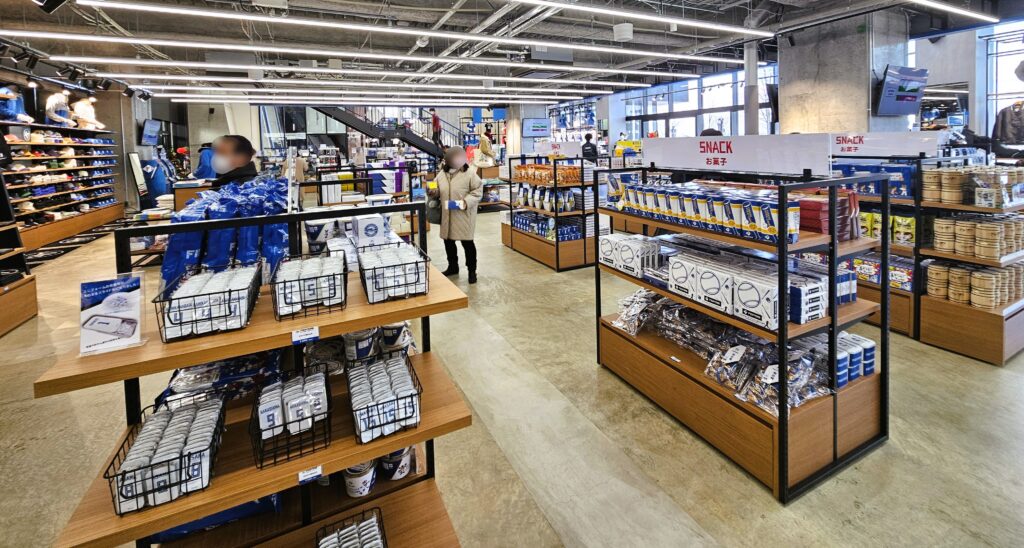
The first floor of the team store 
Mural of Yu Darvish and Shohei Ohtani that’s between the team store and food court. I expected the team store to be open, just didn’t think it was going to be on the inside of the stadium, but didn’t think the food court would also be open AND the brewery (!) too. There was a cool area in centerfield where the brewery was located.
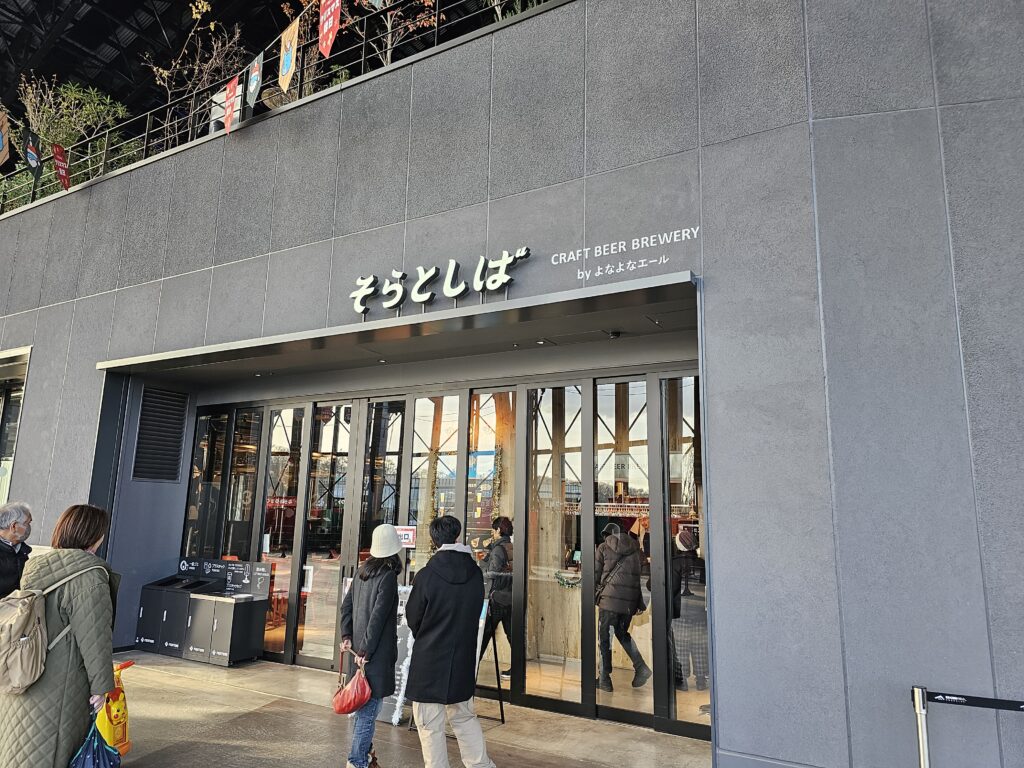
The entrance to the craft brewery 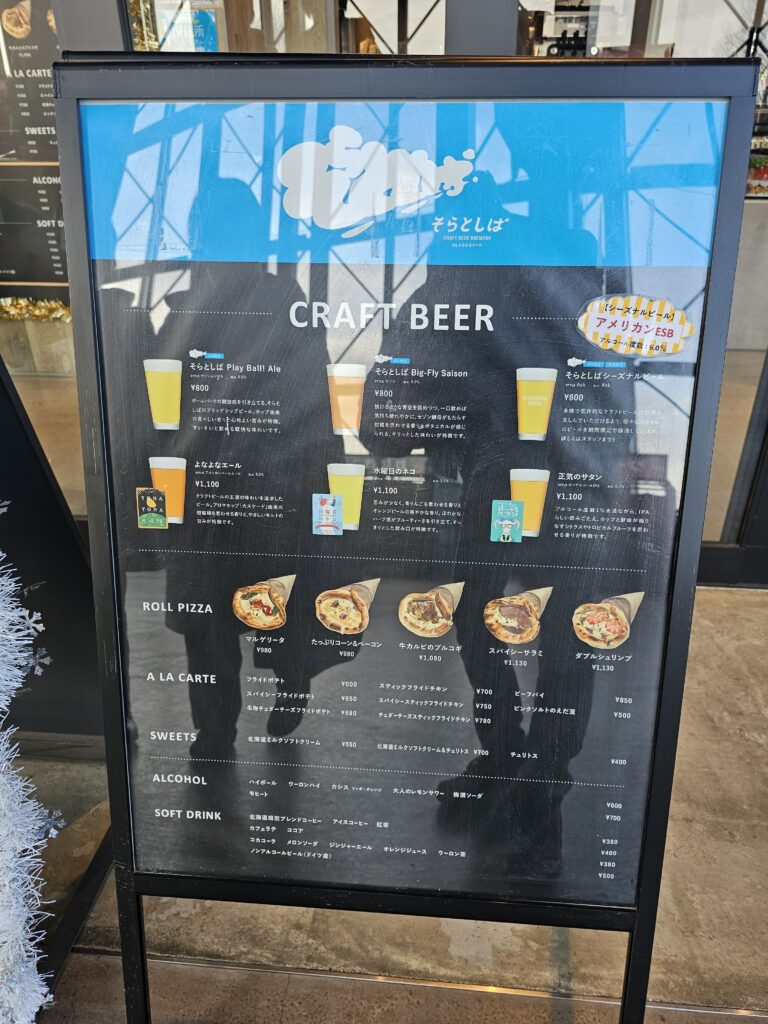
The craft beer selection and snacks! Seeing that one the stadium had a brewery and it was open, I obviously had to grab a Playball Ale (800 yen, $5.29 USD) and roll pizza (Margherita roll 900 yen, $5.95 USD). The brewery is located in center field with both an “indoors” area and also a patio area that’s upstairs (this area’s bar wasn’t open).
I grabbed a seat at the counter that faces the field to enjoy my beer and food. Really cool place and location.
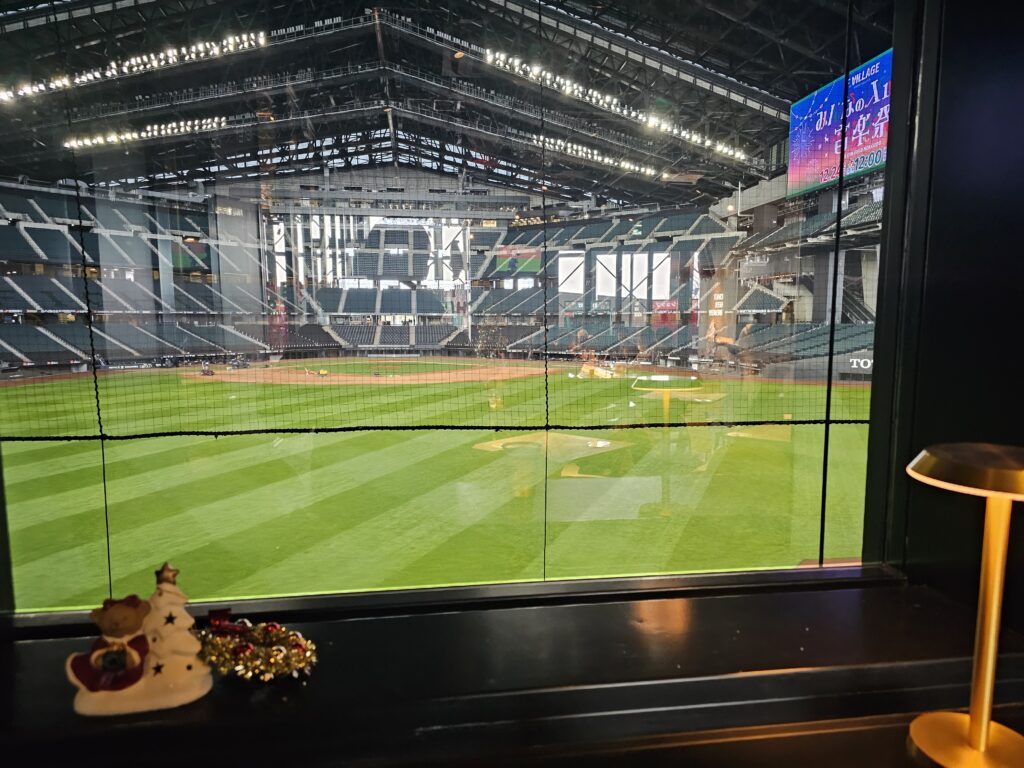
The Tour
Es Con Field Hokkaido offers a couple different tours. The Basic where you can walk around the diamond seat area and get to walk around in the dugout and stand on the field and then the Premium which includes everything from the Basic while also providing access to the players area / locker room. I went with the Basic (1800 yen, $12.42) USD). I really wanted to step onto the field and and see how the stadium looks from field level. You get some really great views of the stadium and the field and some behind the scenes looks into the inner workings of the stadium. It was a blast!

One place on the tour are the seats directly behind home plate 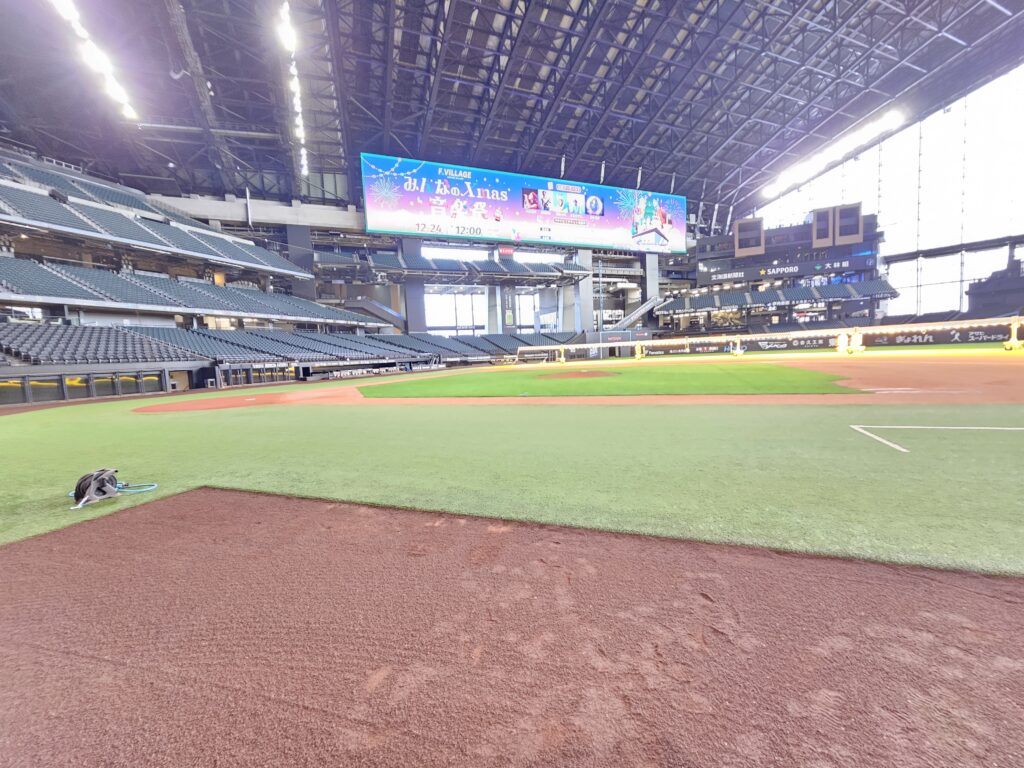
Field level directly in the front of the first base dugout 
The media room Es Con Field Hokkaido Is Worth A Visit
If you’re a sports fan and are visiting Sapporo, Es Con Field Hokkaido should be on the list of places to visit. The stadium is gorgeous and it’s a treat to walk around the surrounding area and within the stadium itself.
The next goal will be to go when the Fighters are playing. The atmosphere from the walk from the station to the field and then the game atmosphere itself would be amazing I’m sure. Certainly something I want to plan for in the future!
-
Things Get SPICY At This Miso Ramen Joint in Sapporo
Miso ramen can be found throughout Japan but the birthplace of this style of ramen is Sapporo. The specific nature of how miso ramen came to be has long been rumored that it occurred at a restaurant called Aji no Sanpei in Sapporo in the 1950s when a drunken customer asked that noodles be placed in their miso soup. How accurate the story is may be debatable, but a “strange” concoction born from the hunger pains of a drunken patron are surely believable.
Fast forward decades later and, as mentioned above, miso ramen has evolved and can be found throughout the country. Each area and restuarant will have their own unique spin on this unique tasting ramen BUT there’s only one place that can claim to be the creator of miso ramen and that’s Sapporo. It was a must try for me while I visited.
Karaiichi Sapporo Ramen Susukino
I stumbled upon Karaiichi Sapporo Ramen Susukino after coming back from my day trip to Otaru. It was a cold day ( I went in December) so a nice steaming hot bowl of ramen sounded like the perfect meal to have to cap the day off. I thought it was the perfect time to get some authentic miso ramen in Sapporo!
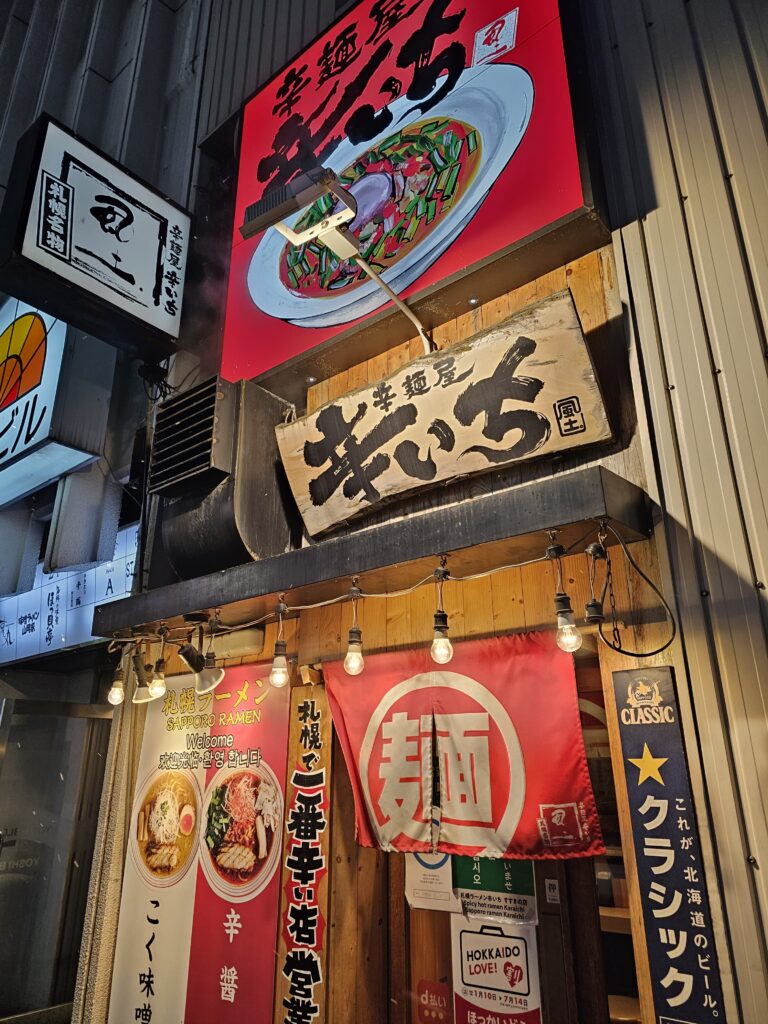
It’s a typical ramen restaurant that’s very tiny and seating consisting of countertop space. They did have an English menu here which was certainly helpful. Something that was very interesting here was the spice level.
If you take a look at the below (sorry the print is tiny) you can see that spice levels range from 1-30 with appropriate increases in price, then there’s TWO additional levels called “demon” and “Hell”. I mean….what does this ENTAIL? What does this even look like or taste like?? I certainly wasn’t brave enough to give either one of those a taste. I like spice but I draw the line when spice levels hit “demon” and “Hell” levels, haha.
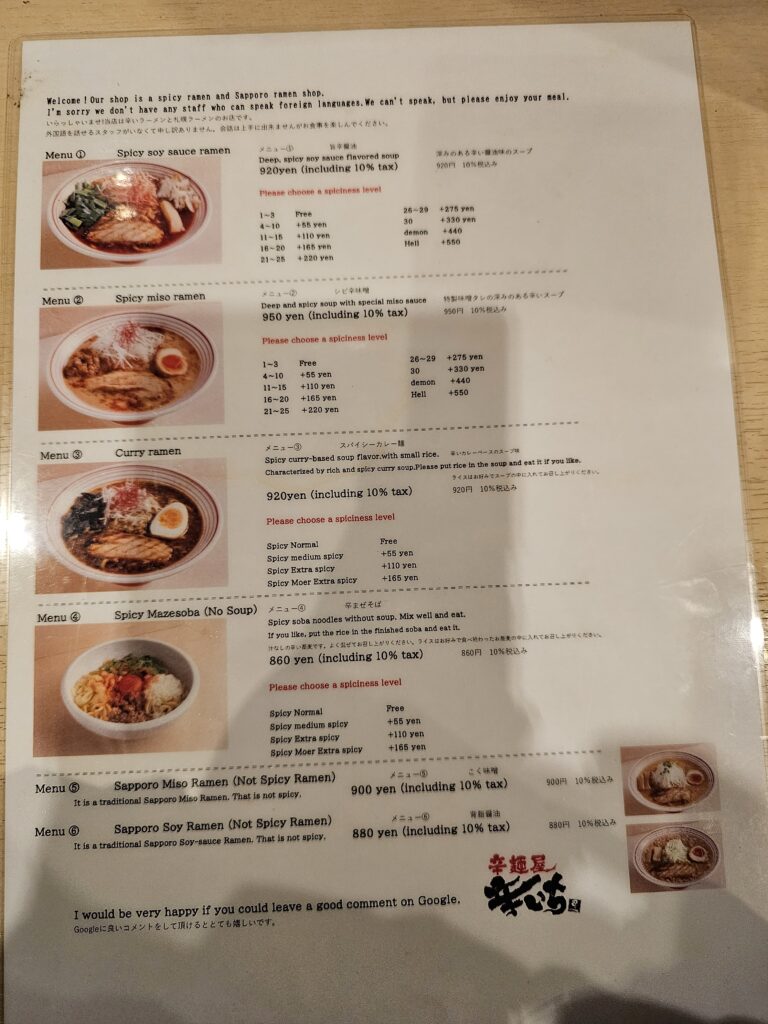
The Food
I ended up getting the Spicy Miso Ramen, level 10 (1005 yen, $6.47).
Miso broth is thicker, made primarily with miso paste and can also include many other ingredient combinations of dashi, garlic, ginger,onions, scallions, tare, and other ingredients. There’s a lot of variation that can be found here.
This particular broth was definitely rich with a deep flavor. The spice was quite good at level 10. Definitely quite spicy, not overly so, with a great kick to it. It was just right. I can’t imagine what level 20 would be, let alone the last two levels!
The bowl of miso ramen comes with finely shredded bean sprouts, half an egg, a piece of chashu pork, and some ground pork as well. The chashu was fantastic. It was exremely tender and was falling apart as I attempted to pick it up.
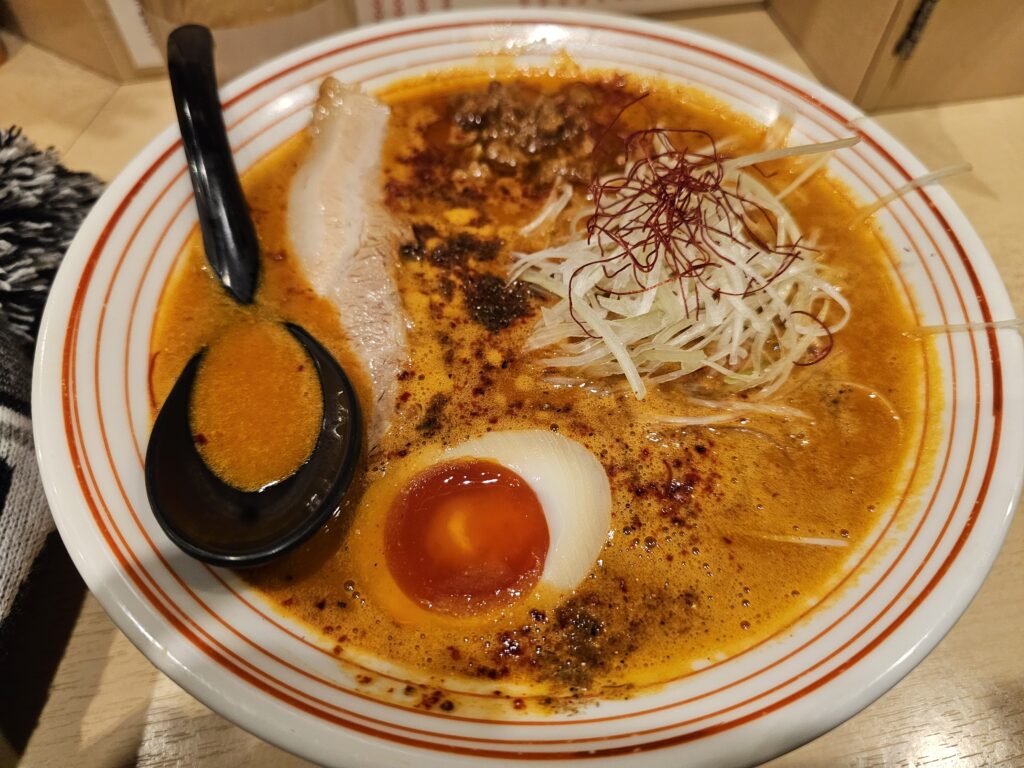
The noodles were thicker and firmer and tasted extremely fresh. The egg was nice and creamy. I enjoyed the addition of the ground pork, it was a little different than what I was used to. The bean sprouts added a different texture to the bowl. Everything in the bowl really played well together, when combined with the spicy broth made quite a comforting bowl of ramen on a cold December night.
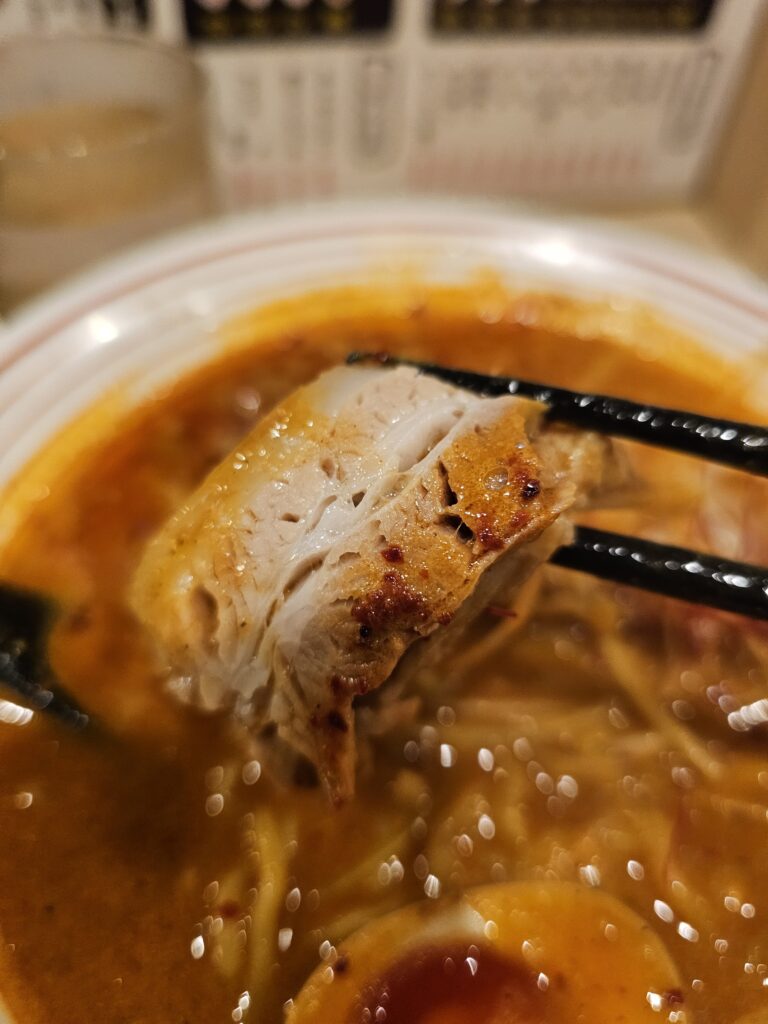
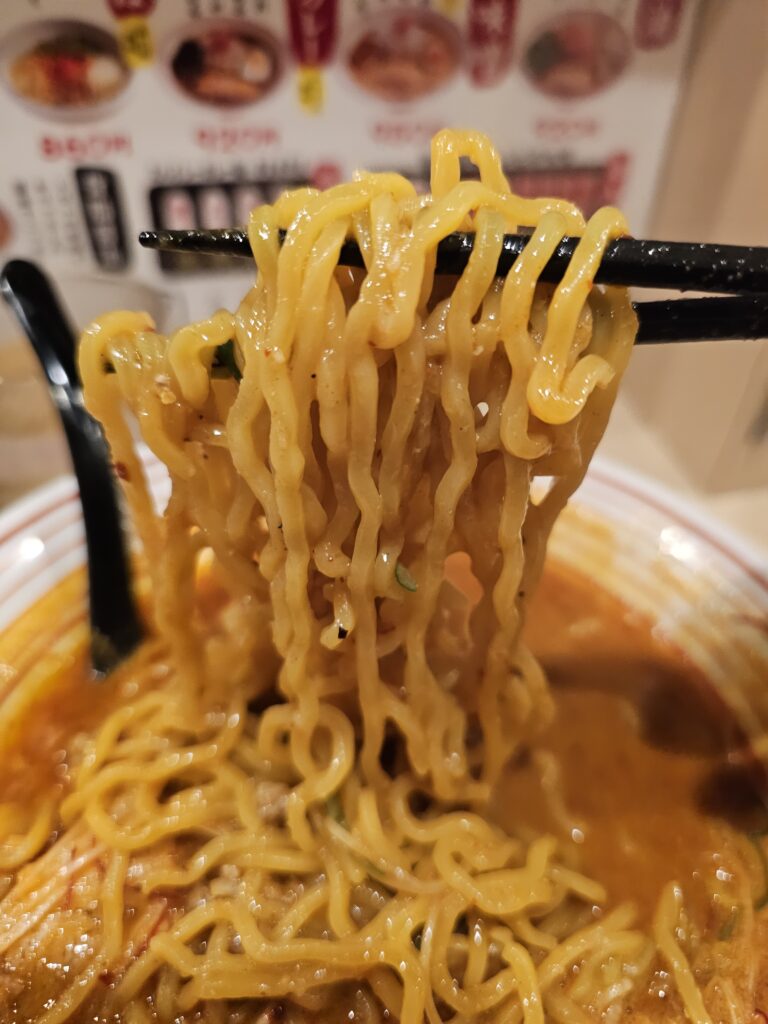
Miso Ramen in Sapporo
As mentioned above, miso ramen was CREATED in Sapporo, so if you’re a foodie it’s a must try. You could certainly go to the original ramen shop that created miso ramen – Aji no Sanpei – it’s still there (!) or you could find any number of ramen restuarants dispersed about the city serving miso ramen.
I was lucky enough to stumble up on Karaiichi Sapporo Ramen Susukino and was not disappointed. If you have a hankering for spicy miso or are looking to give it a try, this is a great option if you’re in the area. The Spicy Miso Ramen was fantastic here. I just love how many different spice levels they offer, as someone that loves spicy food it was great to see!
Karaiichi Sapporo Ramen Susukino
Address: Japan, 〒064-0805 Hokkaido, Sapporo, Chuo Ward, Minami 5 Jonishi, 4 Chome−7−3 ソシアルビル 1F
-
Inviting Local Bar in Sapporo Is A Great Place For Drinks And Snacks
After a long day of exploring Sapporo, I was in the need of a nice cold beer and some food. There are of course a ton of bars in Sapporo so narrowing it down can be a daunting task. Not wanting to venture out too far, I was able to whittle down the choices and find Micci’s. Micci’s had great reviews and was located just a few minutes from where I was staying.
Micci’s Bar
The first thing you notice when you first enter Micci’s is the decor. This is a unique bar in Sapporo. It’s walls are covered with posters, stickers, toys, plushies, photos, and assorted other trinkets. There’s a whole section behind the bar housing many many CDs which are played within the bar. The night I was there they were playing the Rolling Stones. It feels like a bar from the early 2000s. Just a really cool and fun environment.
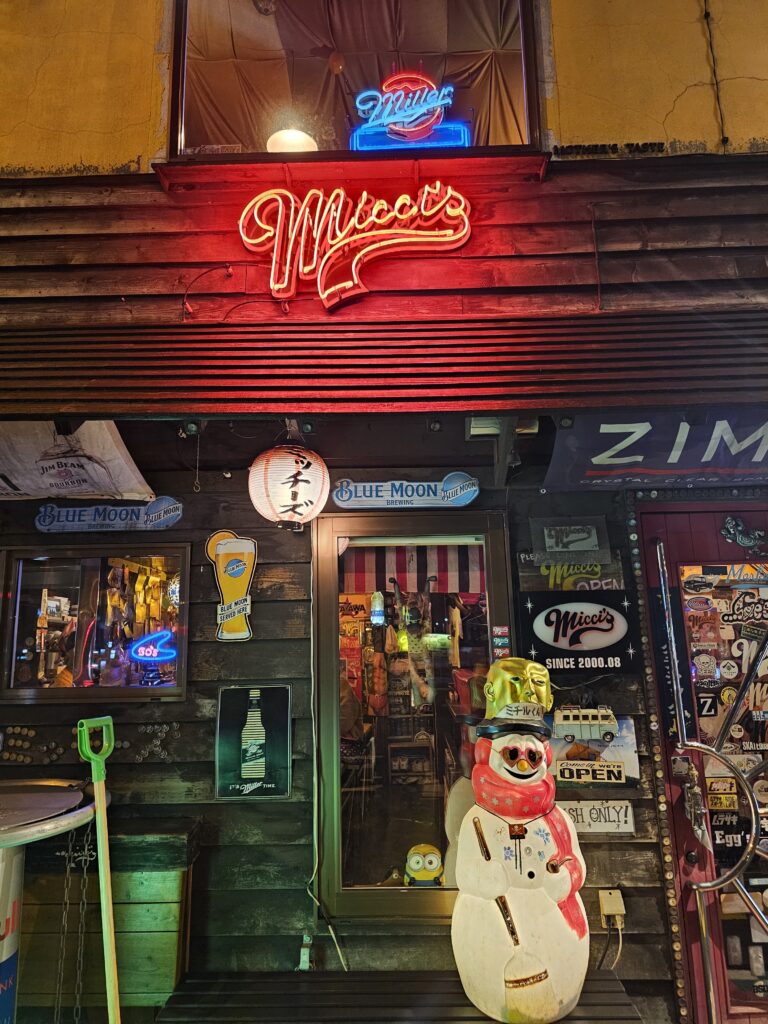
The bar is quite small. There’s counter seating and then another section with a booth and a table with some addtional seating. The quaintness of the bar adds to the coziness appeal. The staff also adds to the warm environment as they are very kind, chatty, and speak English as well!
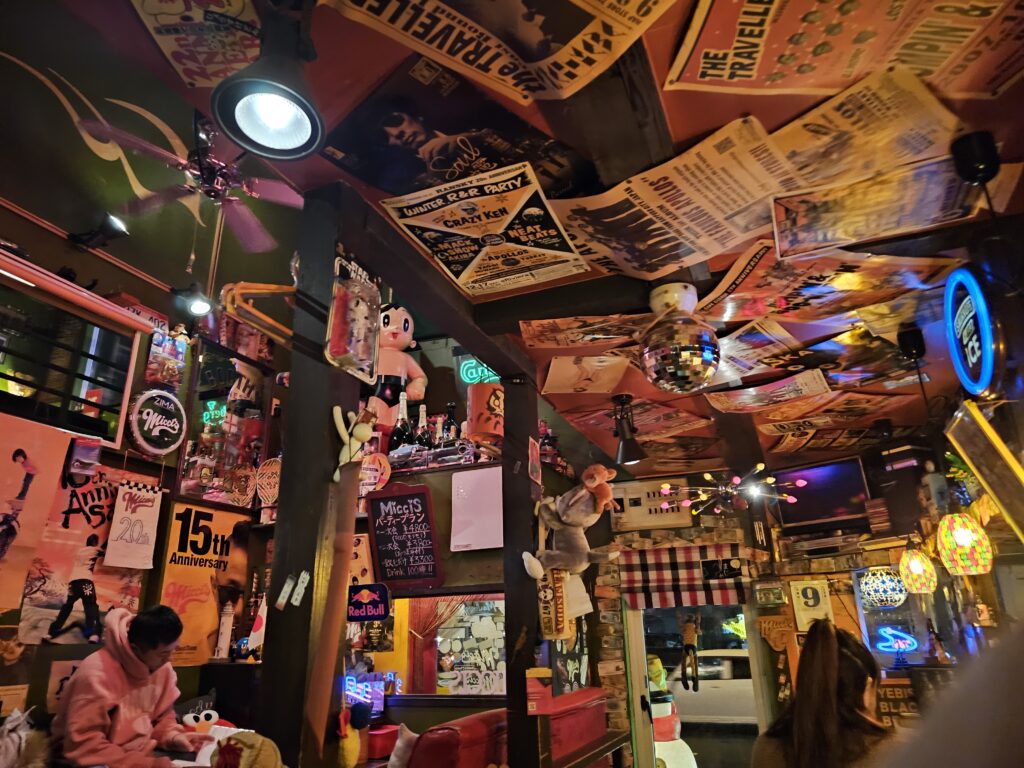
This may be a bar but Micci’s also offers a fairly diverse menu filled with snacks, small dishes, and finger foods which go great with a nice cold beer. The bar food is all very reasonably priced as well so you could certainly eat to your heart’s content here without breaking the bank.
There’s only two people working at Micci’s and Micci does all the cooking. There’s no separate kitchen area. The fryer and all cooking takes place right behind the bar
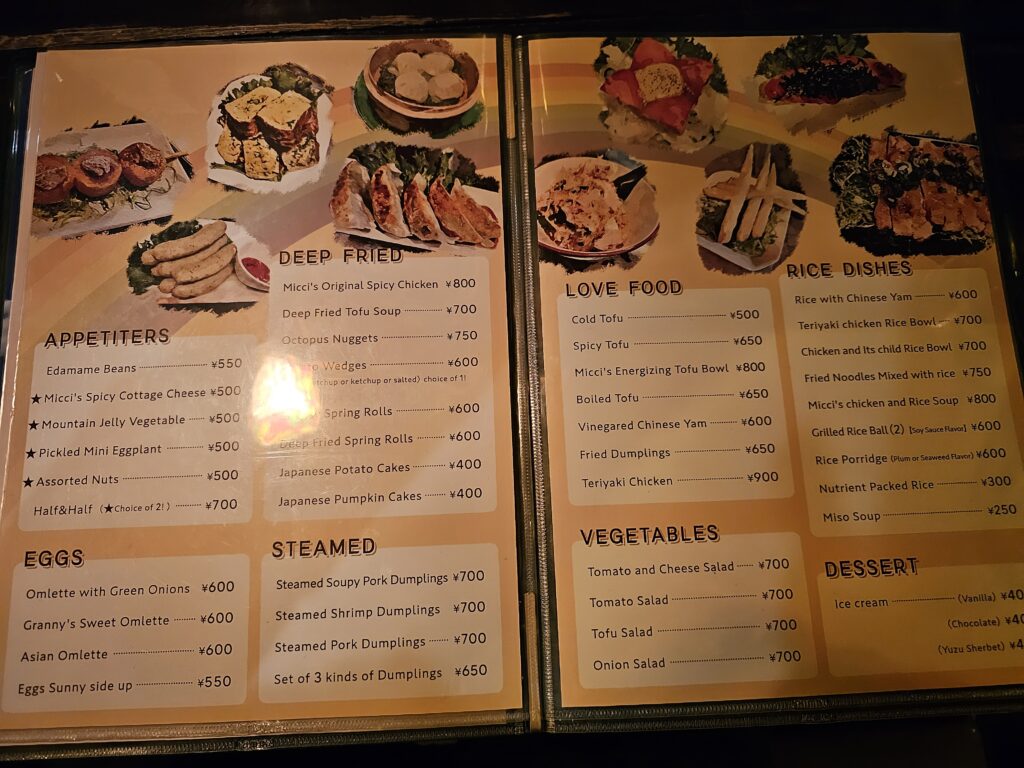
The Food
I opted for Micci’s Original Spicy Chicken (800 yen, $5.07) and the Japanese potato cakes (400 yen, $2.54). The Spicy Chicken had nice crispy skin and the meat was juicy and tender. There was finely shredded lettuce and green onion that accompanied the chicken as well. I wasn’t quite sure what the sauce consisted of. It was a little buttery a little sweet, and a little spicy. Very subtle flavors but very tasty.
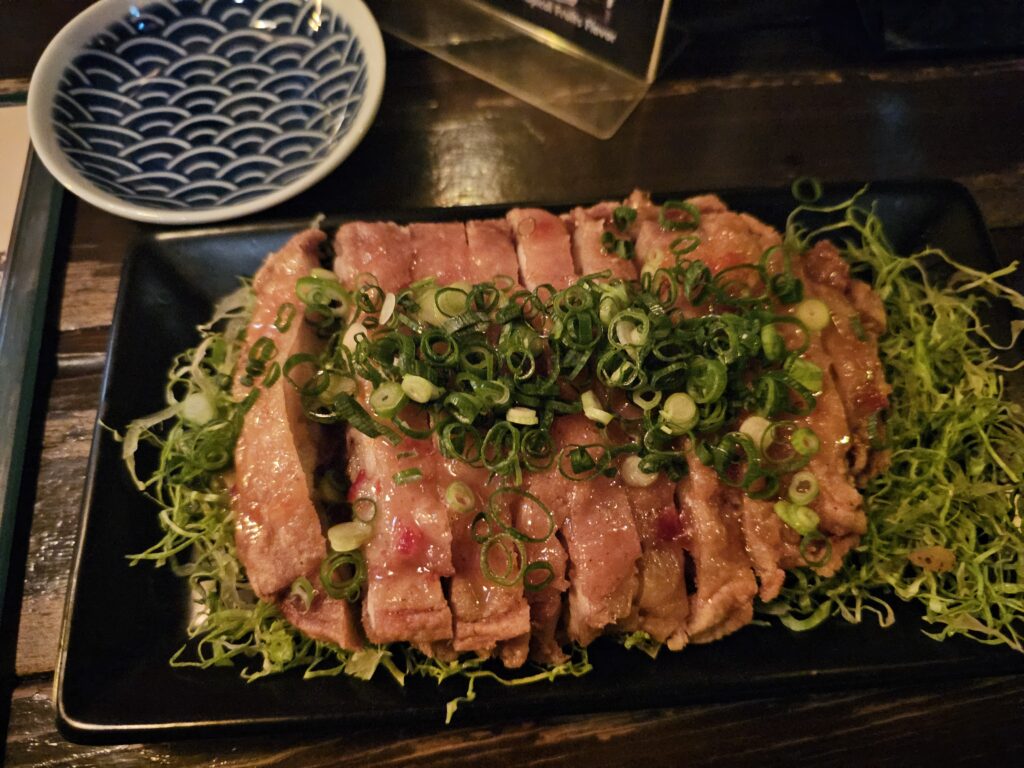
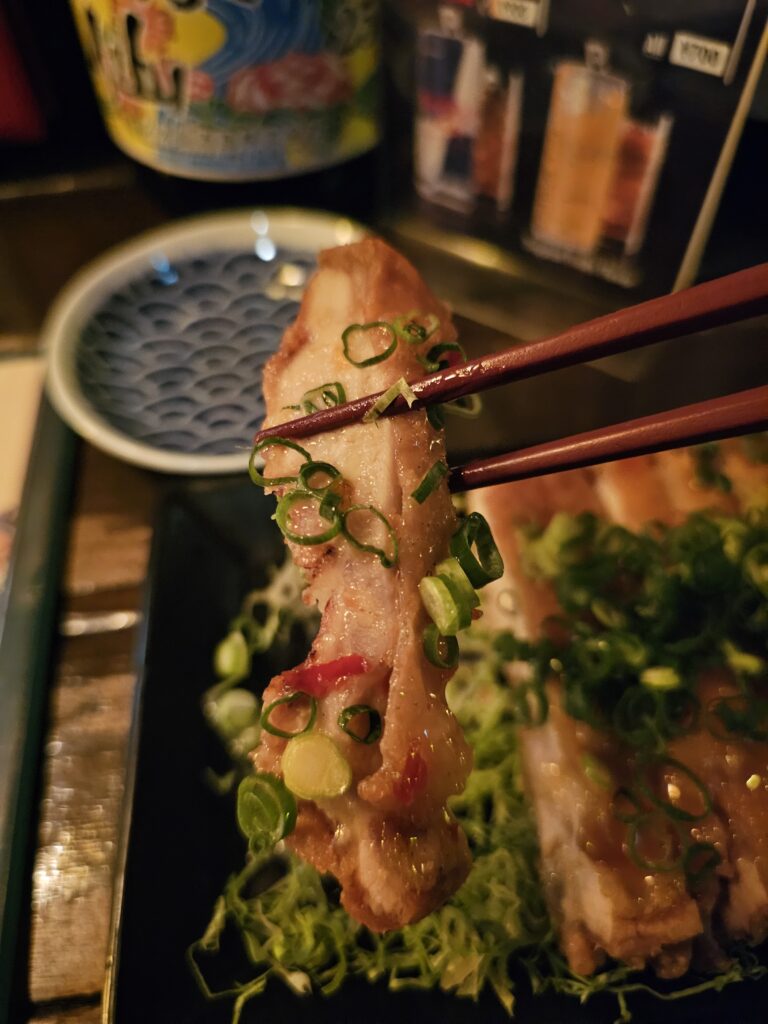
The Japanese potato cakes came out piping hot. Nice and cripsy on the outside the inside was semi-firm, semi-gooey on the inside. It reminded me of potato mochi to a certain extent. It was really tasty as well.
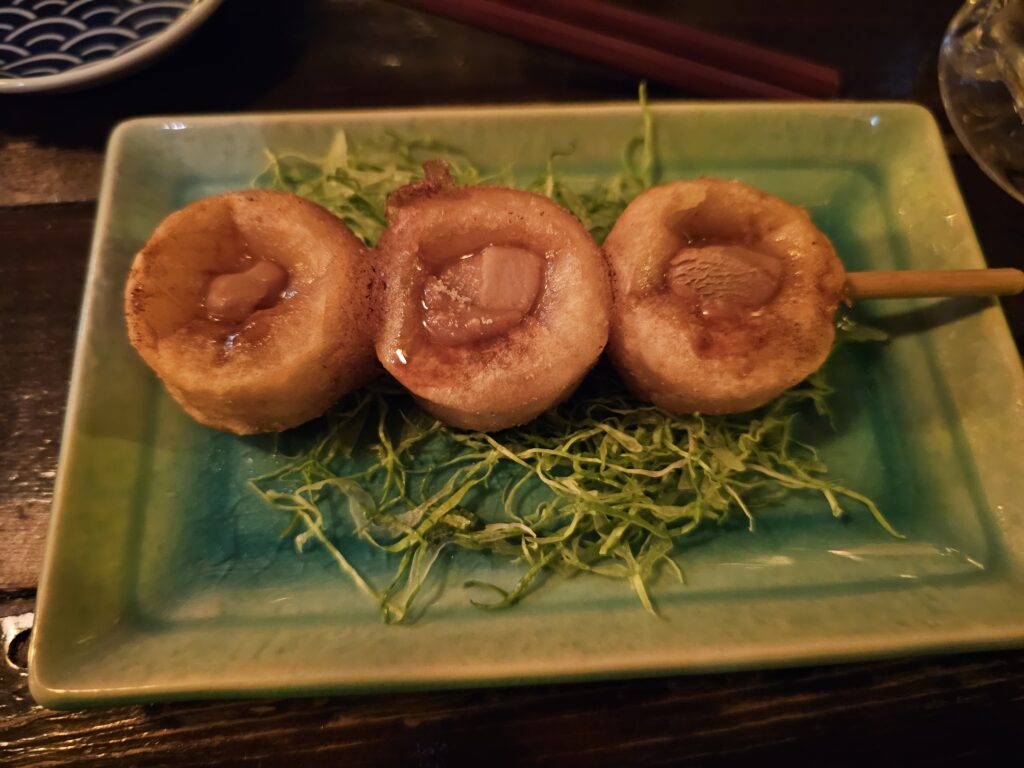
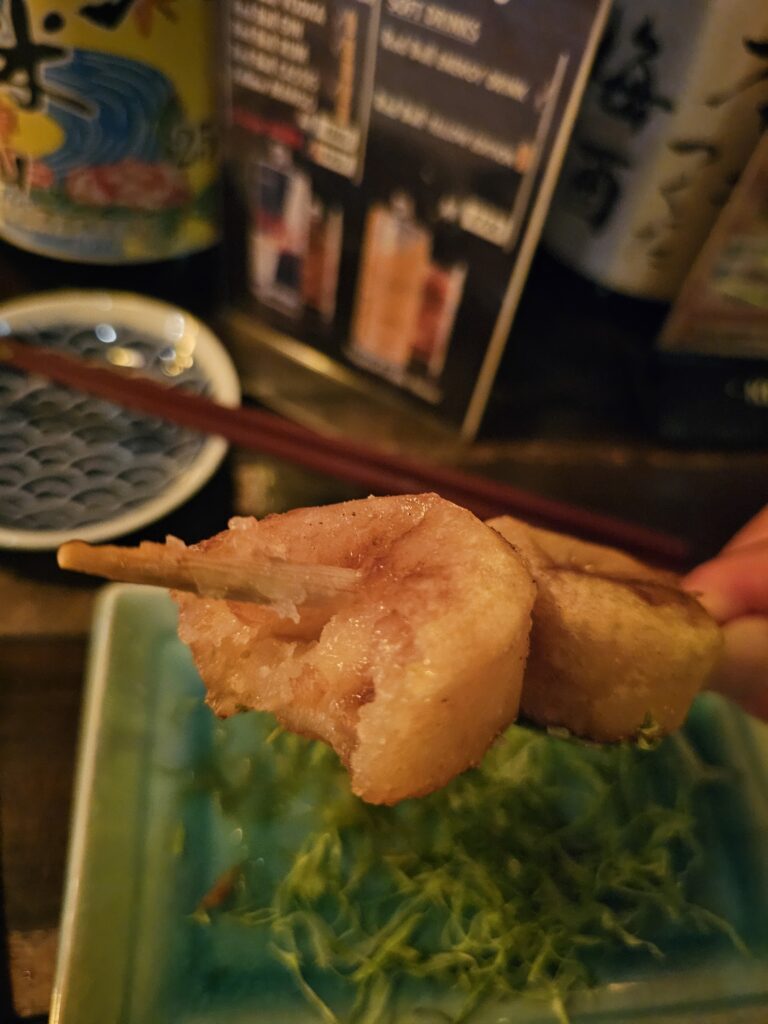
Micci also gave me free octopus nuggets(essentially calimari), which was delicious and very kind of him!
Micci’s Is Worth A Visit
If you’re in Sapporo and looking for a chill evening with some cocktails and some good bar food, Micci’s is certainly worth a visit. It’s a unique bar in Sapporo. From it’s charming decorations to friendly staff to delicious bar food, Micci’s is just a really cool bar in Sapporo to hangout at to enjoy a night. I definitely recommend checking it out!
Micci’s
2 Chome-12-4 Minami 5 Johigashi, Chuo Ward, Sapporo, Hokkaido 060-0055, Japan
Hours – Monday – Saturday 6 pm – 3 am, closed on Sunday’s.
-
Lively Odori Park in Sapporo Is Well Worth A Stroll Through
What is Odori Park?
One of the top attractions in Sapporo is Odori Park. Located right smack dab in the middle of the city, this is an easy attraction to go and see. In fact, just walking around the city you’d undoubtedly stumble upon this at some point during your Sapporo adventure.
Initially used as a fire break back in 1871, the space has gone through a lot of transformation since those days.
Odori Park is unusual since it’s really a long strip of “park” that has major streets running along the side of it. Stretching east to west, over a mile long and over 12 blocks, in the heart of the city it’s hard to miss.
The Sapporo Tower is at one end of the park. Standing about 492 feet, it’s a nice sight to see as you stroll through the park. It’s also another top attraction in Sapporo that you can visit. It has an observation deck where you can get a full view of Odori Park and the surrounding area, if you please. I didn’t go to Sapporo Tower this trip but maybe next time!
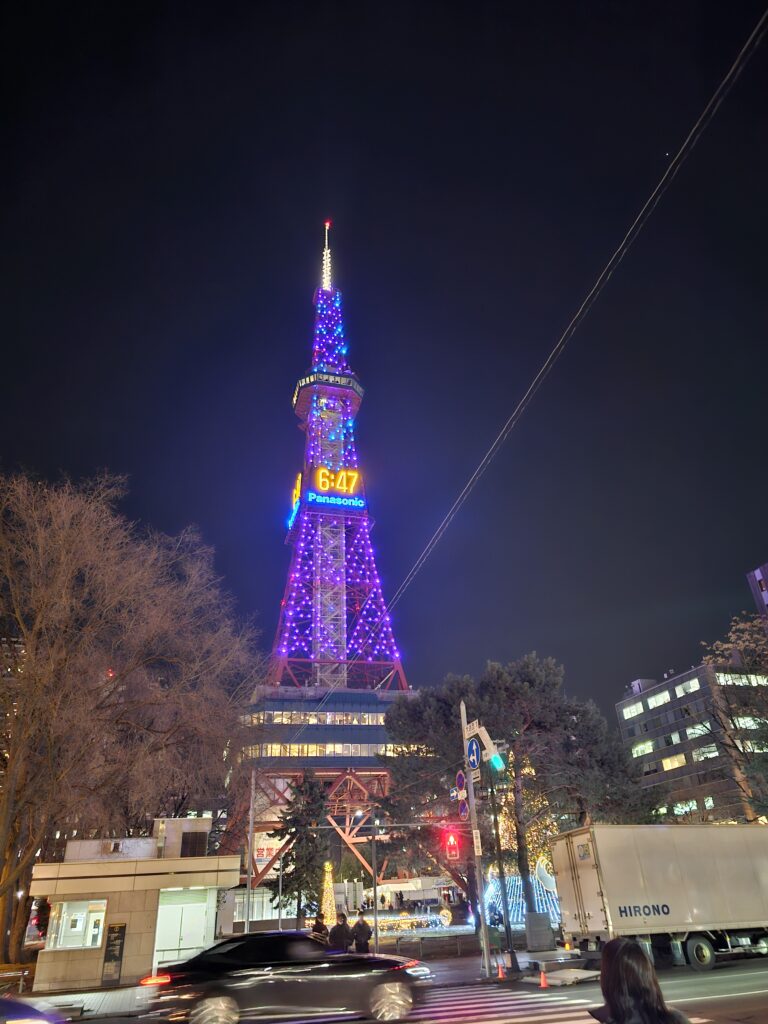
Why is it so popular?
Odori Park hosts seasonal events such as the well-known Snow Festival in the winter, the Lilac Festival in the spring, the Soran Festival and Beer Garden in the summer, and the Autumn Festival, in well, the autumn.
This is a popular location for both locals and tourists alike for a nice place to either take a stroll or just hangout. It’s just a really unique park since it’s so close to the street and isn’t an enclosed “normal” park. The seasonal events attracts MEGA crowds, with the Snow Festival being the biggest of them all, for good reason.
I went in mid December and the park was decked out with Christmas light displays. It was stretched out for most of the park and was a lot of fun to walk through and see all the displays. There was a German Christmas Village set up that had shops selling Christmas souvenirs and there were a number of stalls selling food and beverages. It was a really fun and festive environment to be in and was really enjoyable on a cold December evening!
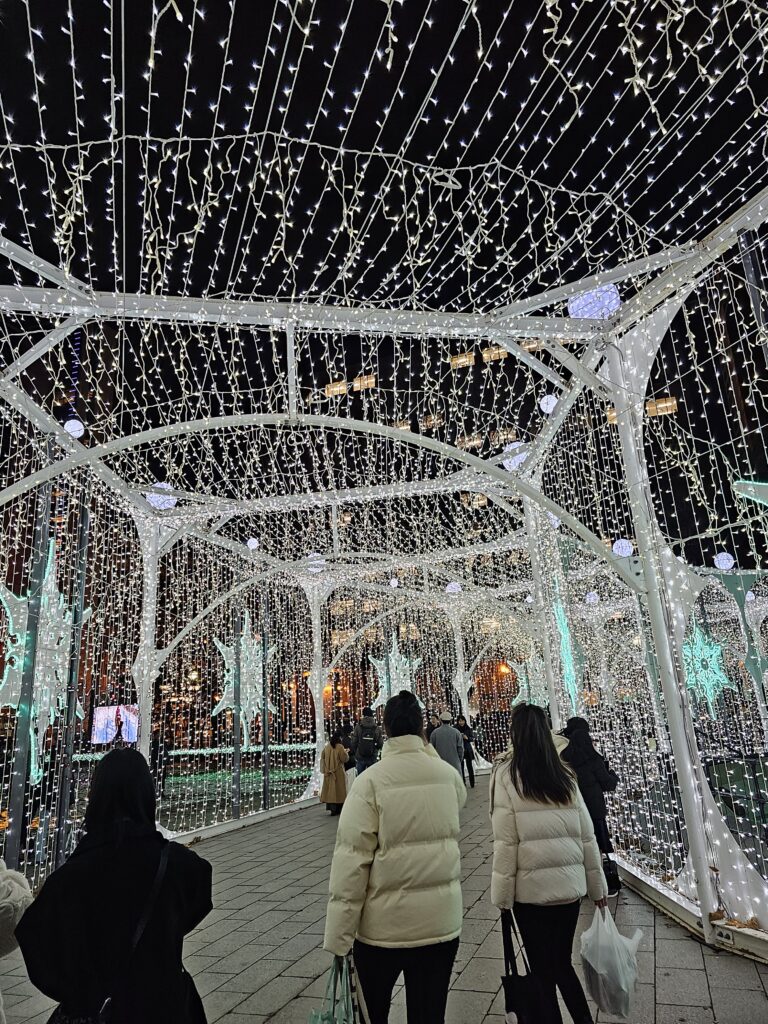
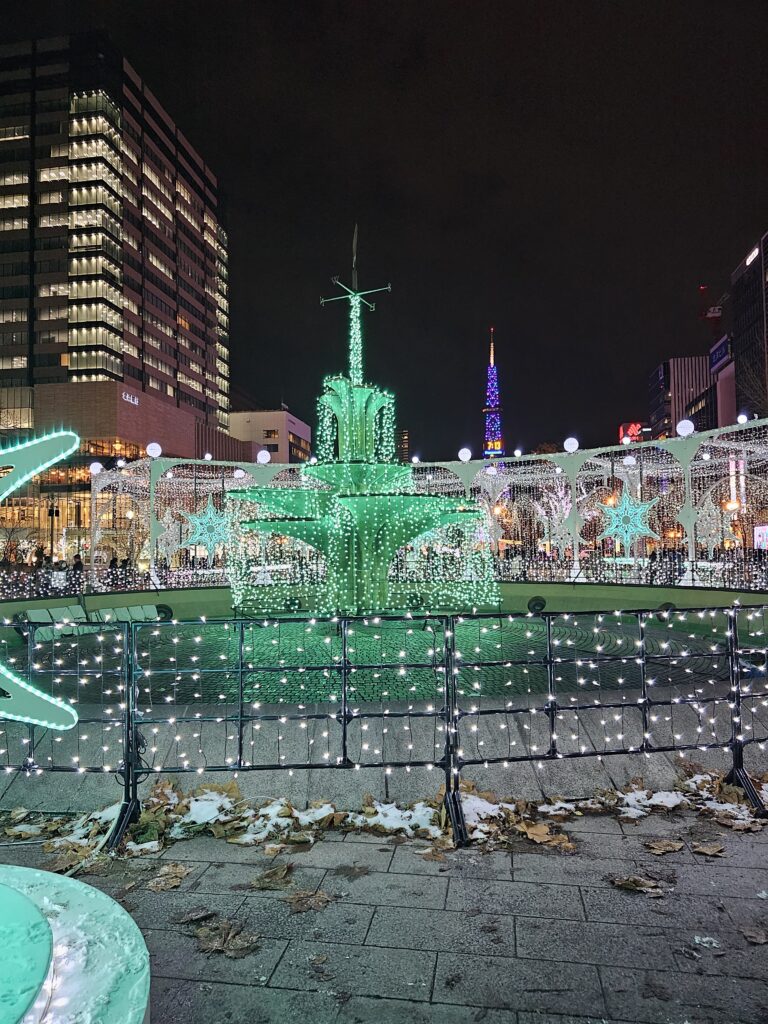
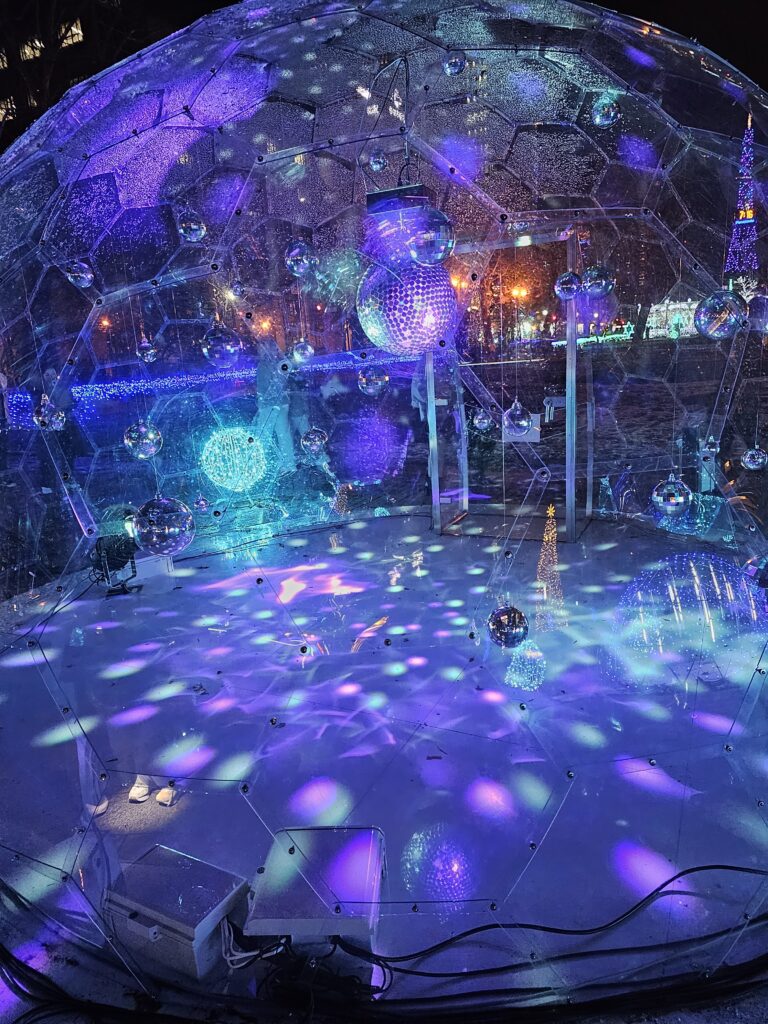
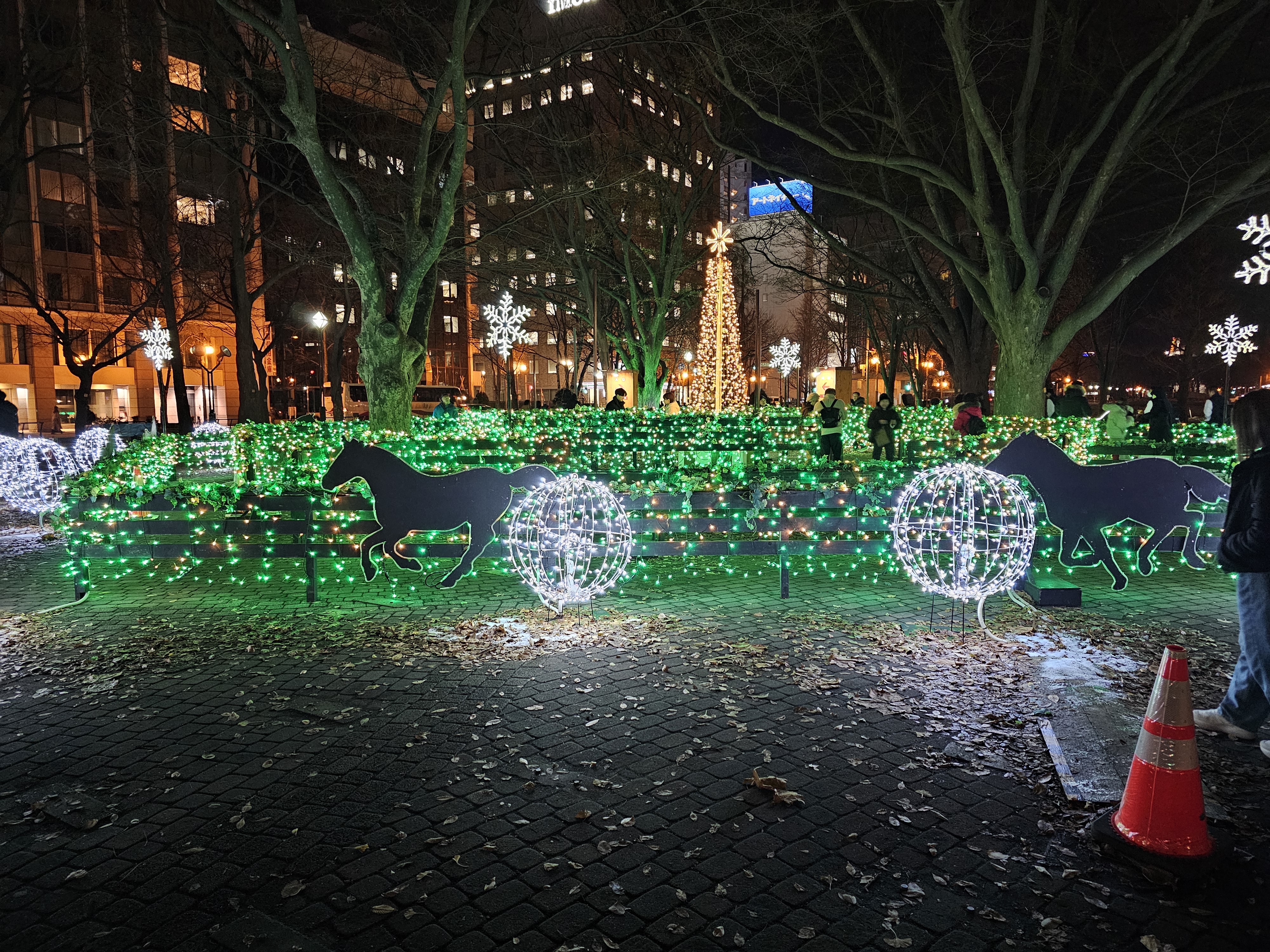
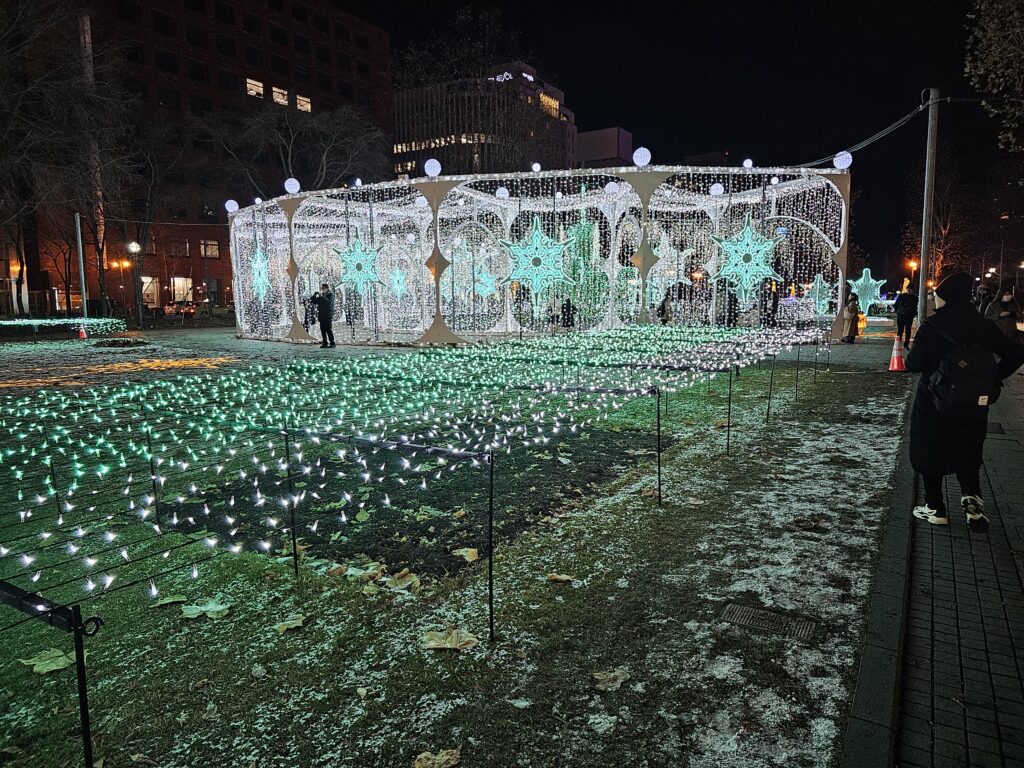
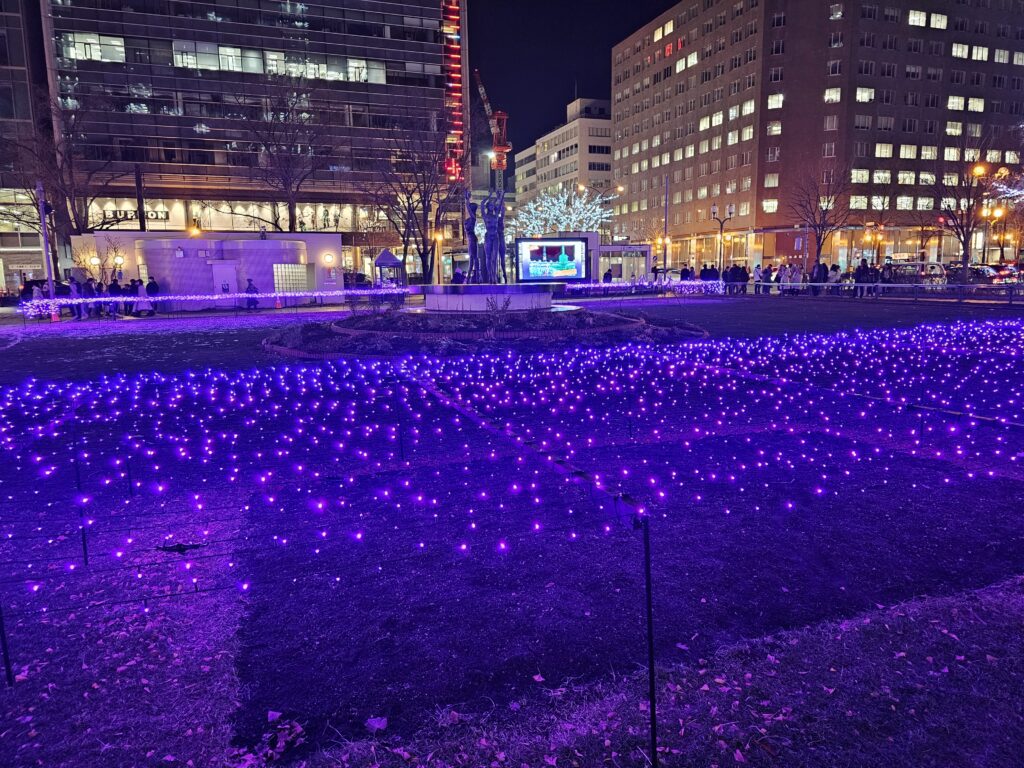
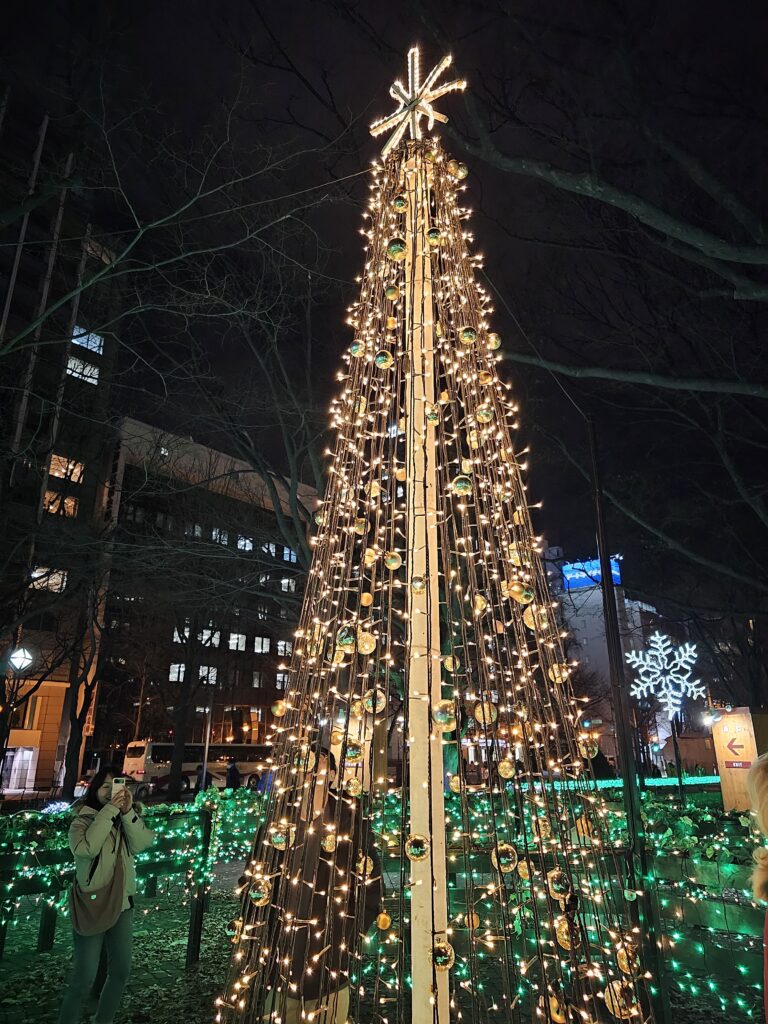
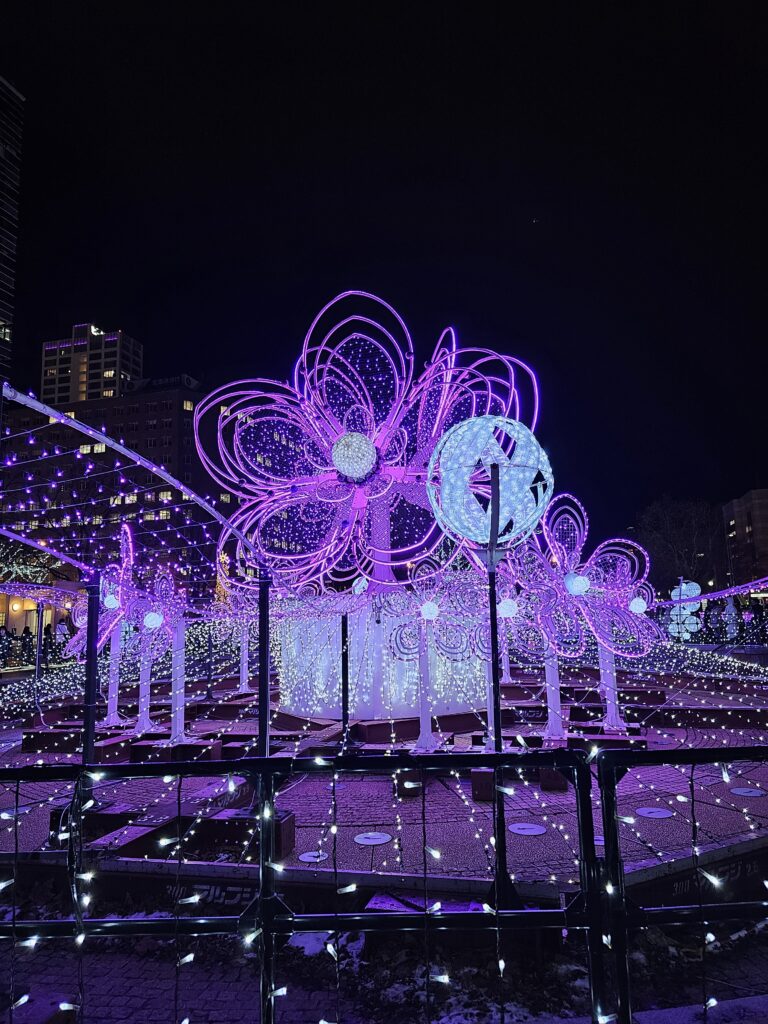
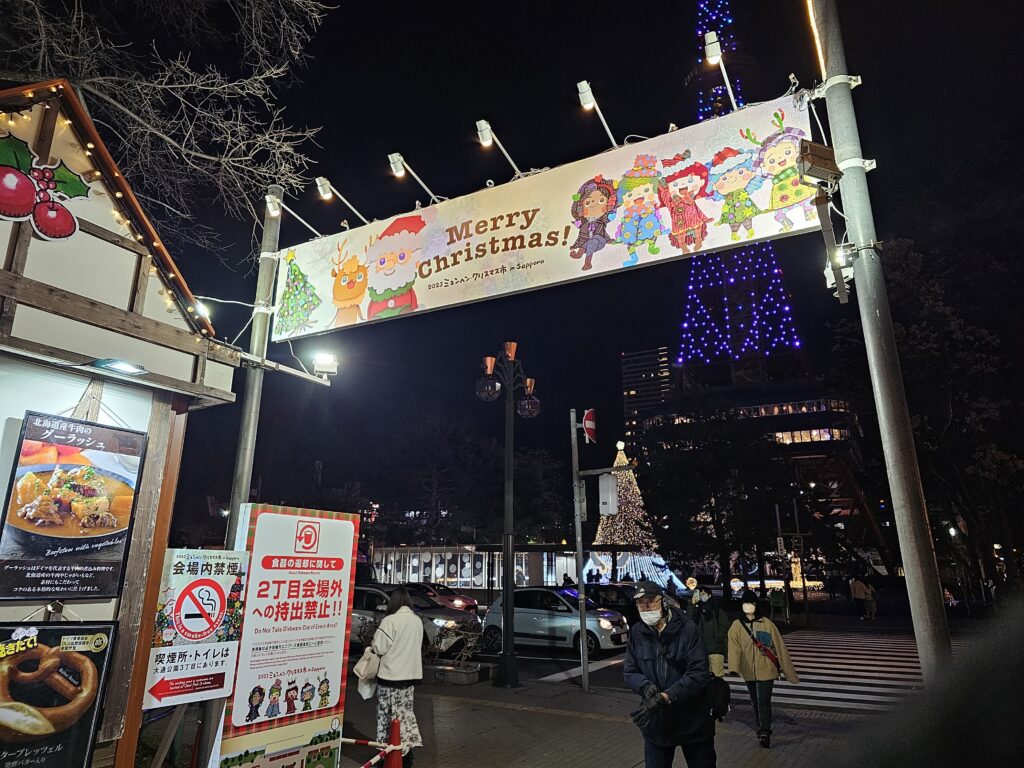
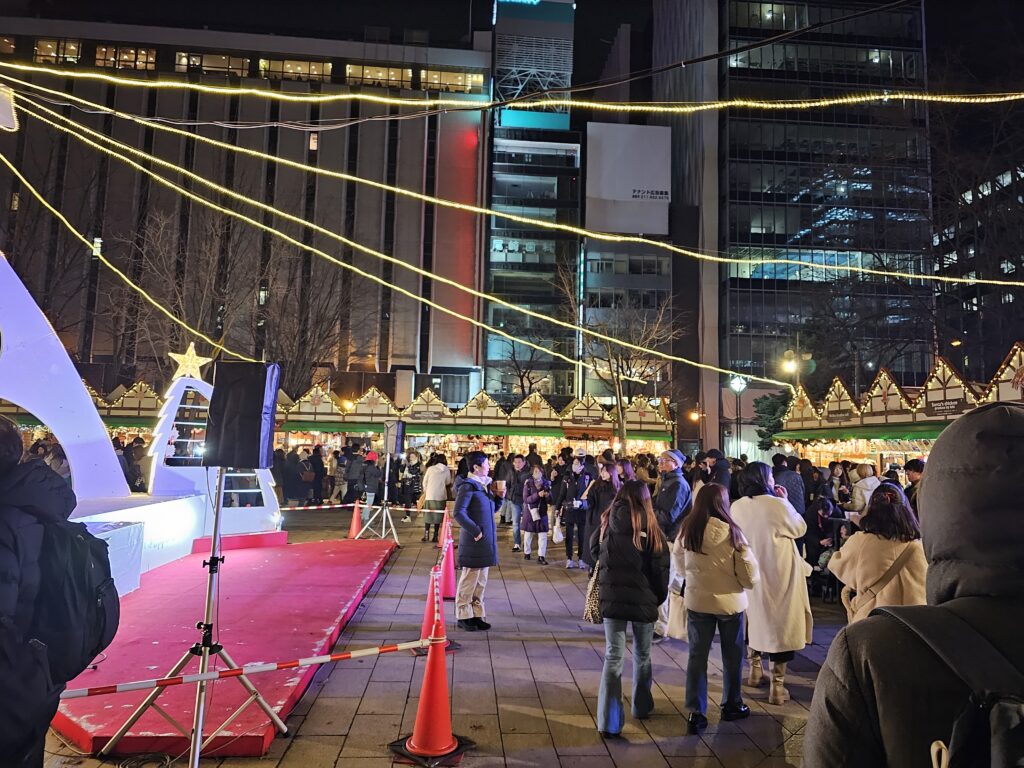
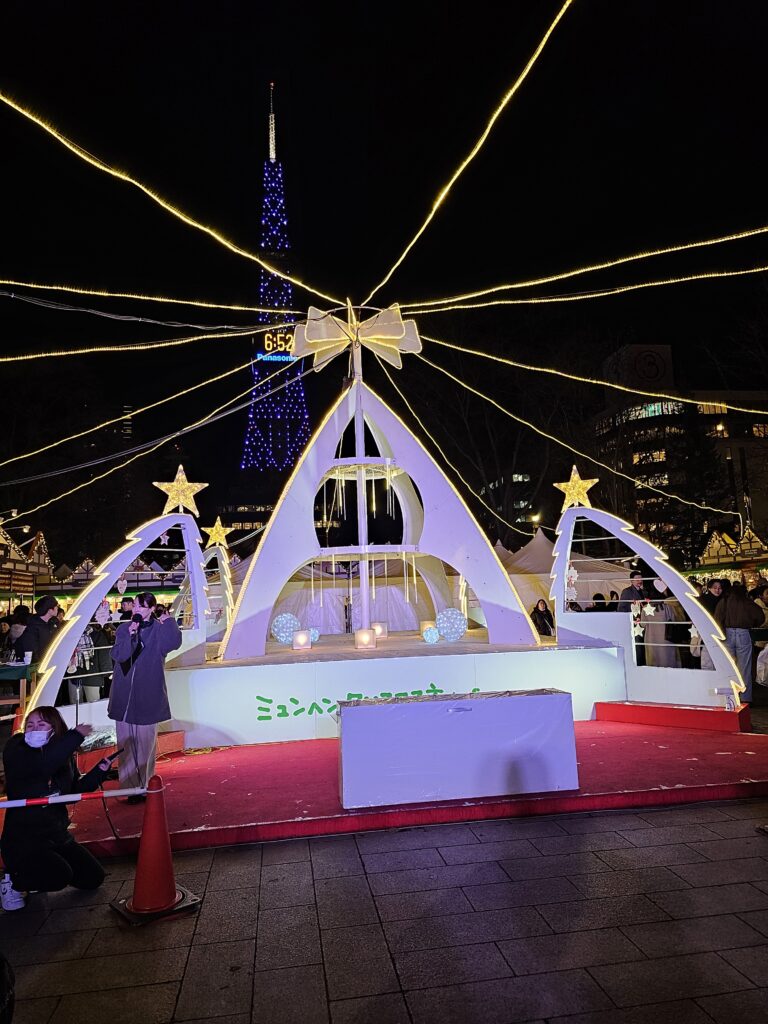
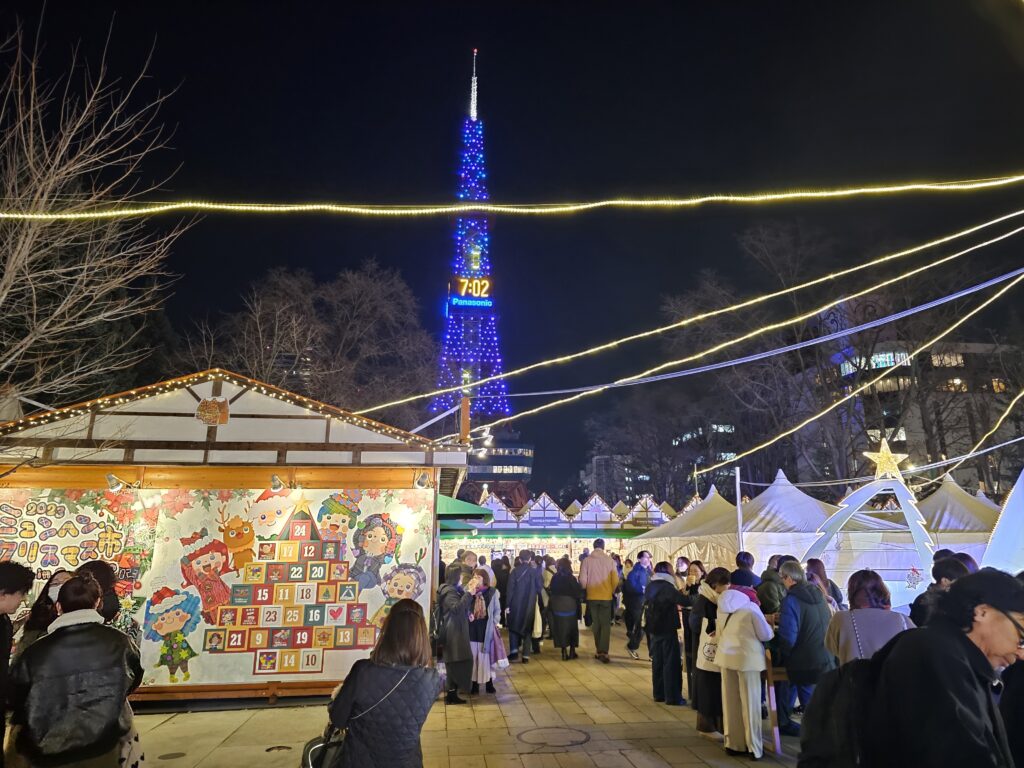
-
Maruyama Park Sapporo Has A Lot To See And Do
Maruyama Park in Sapporo, not to be confused with the Maruyama Park in Kyoto, is a huge park that houses many different attractions and things to see and do. Located under the Maruyama Mountain, the park is home to over 300+ different trees and plants, which depending on the season you’re visiting, can create quite the scenic impression as you take a stroll through the park. There’s over 100 different types of birds located here as well, so avid bird watchers will certainly appreciate the park. Maruyama Park houses a zoo, sports facilities, a public field, a short trail that leads to a great view of the city, and a couple ponds. You could spend an entire day here if you wanted to!
I highlight of the bigger attractions below.
Hokkaido Jingu Shrine
Technically the Hokkaido Jingu Shrine is not inside Maruyama Park. It’s adjacent to it. But it’s hard to separate the two and if you’re visiting one the other one makes sense to visit as well.
The shrine is significant in Hokkaido due to it being the enshrinement of three Shinto deities – Okunitama, Onamuchi, and Sukunahikona. A fourth spirit, Emperor Meiji, has been included as well. It is very much a shrine of spiritual significance.
The area, much like Maryuma Park, becomes quite popular during cherry blossom season since it’s regarded as one of the best places to view cherry blossoms in all of Hokkaido.
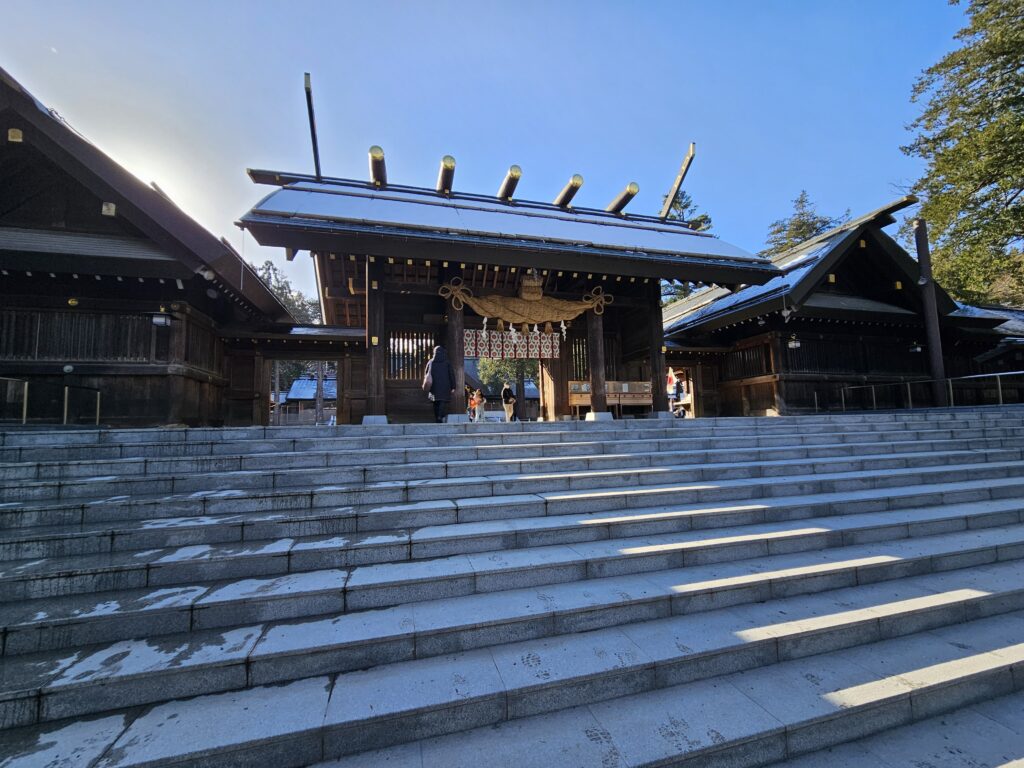
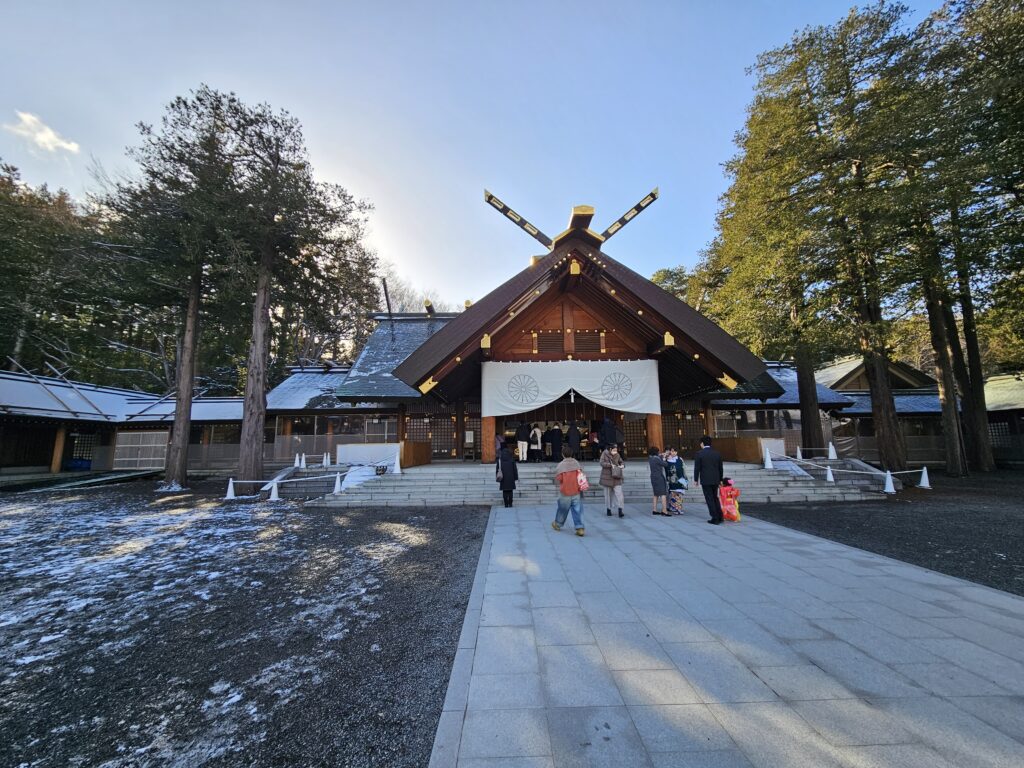
Maruyama Zoo
Maruyama Zoo has been inside Maruyama Park since 1951, so it has a long history with the park. It houses over 170 different species within it including polar bears, wolves, deer, elephants, giraffes, hippos, chimpanzees, and brown bears, just to name a few. The zoo is quite massive as you’d imagine with so many different species. It’s pretty impressive. I wasn’t expecting it to be so large to be honest, and wasn’t expecting to stay as long as I did. But this was an enjoyable afternoon and I devoted around 3-4 hours here.
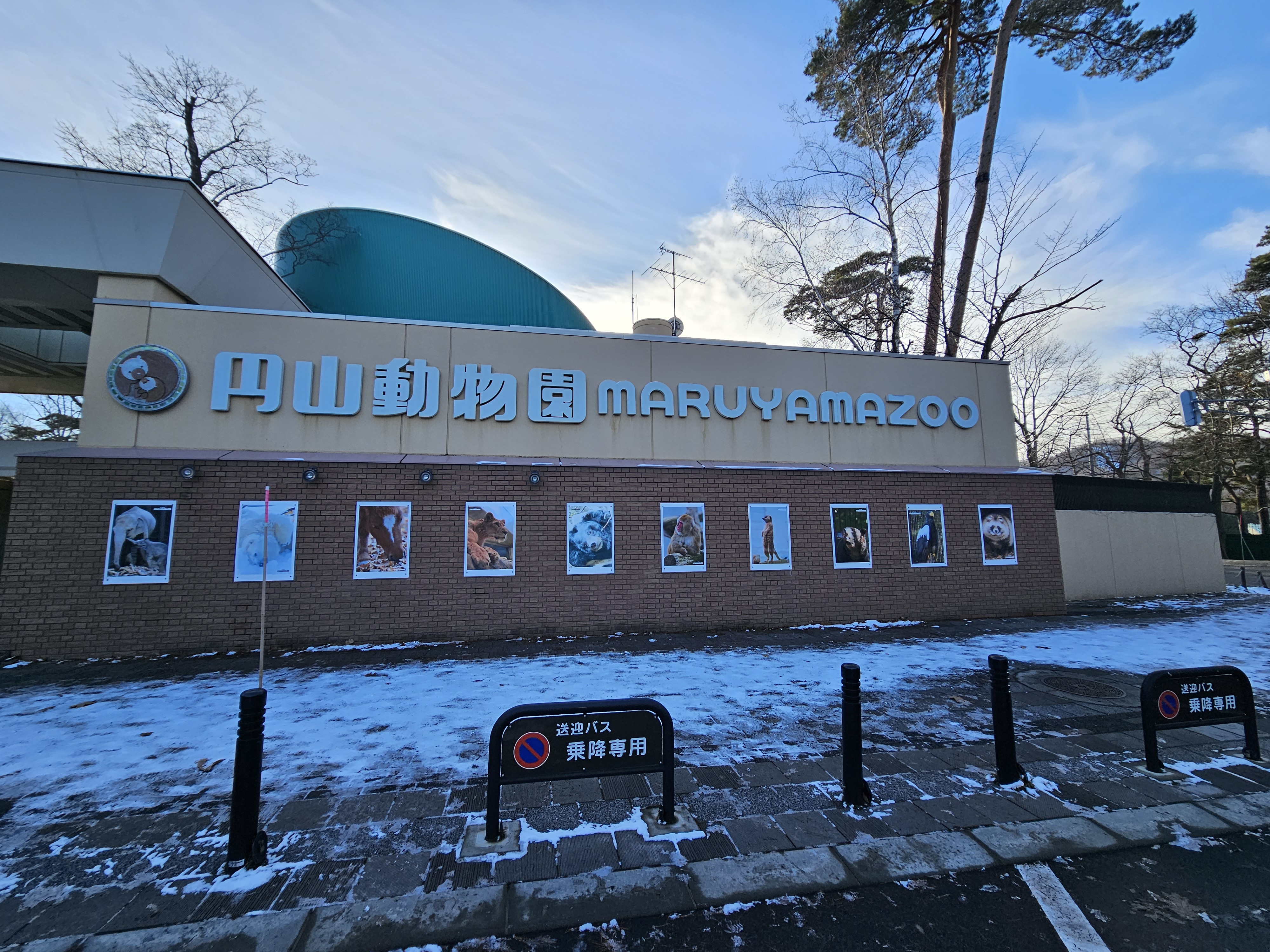
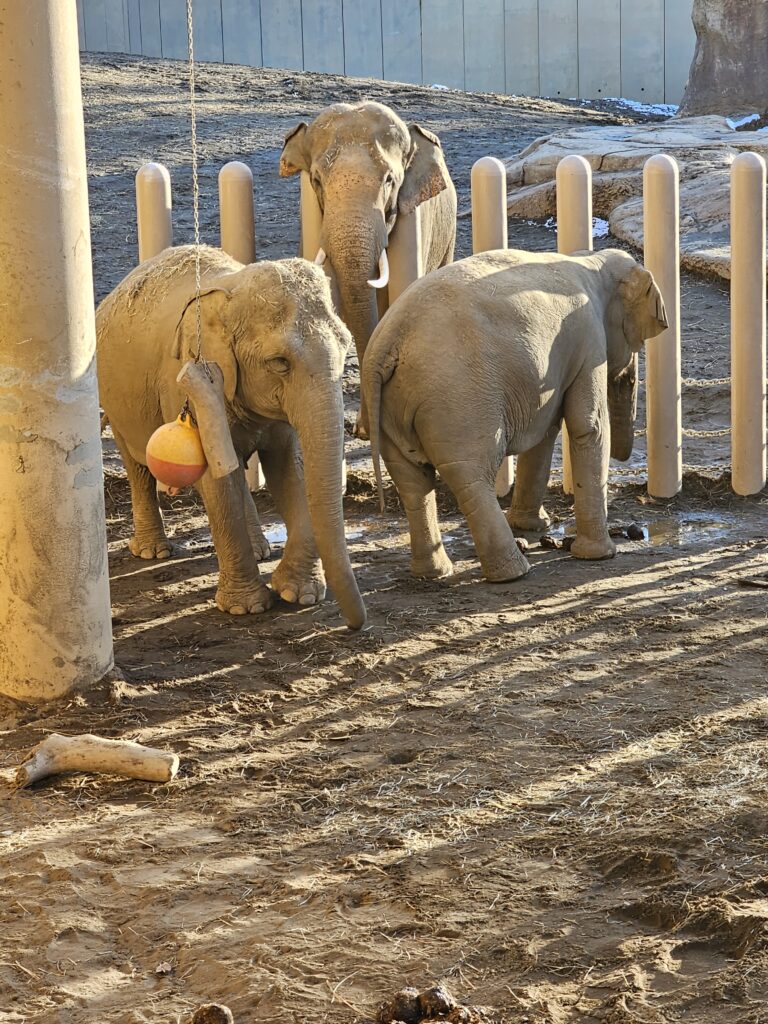
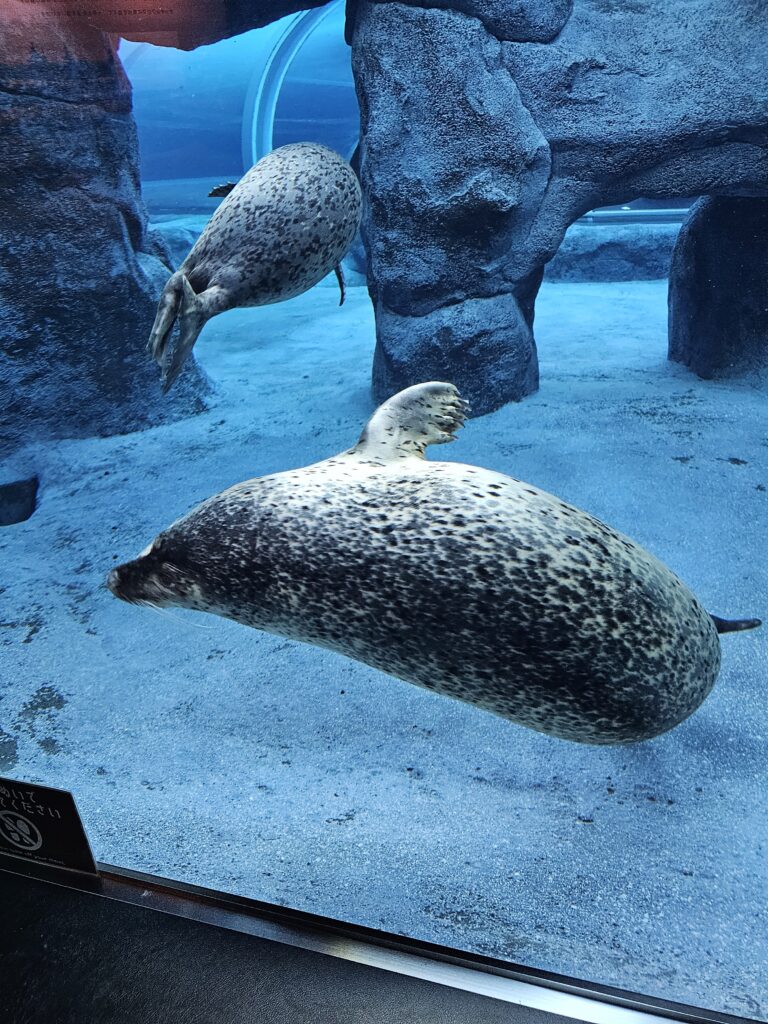
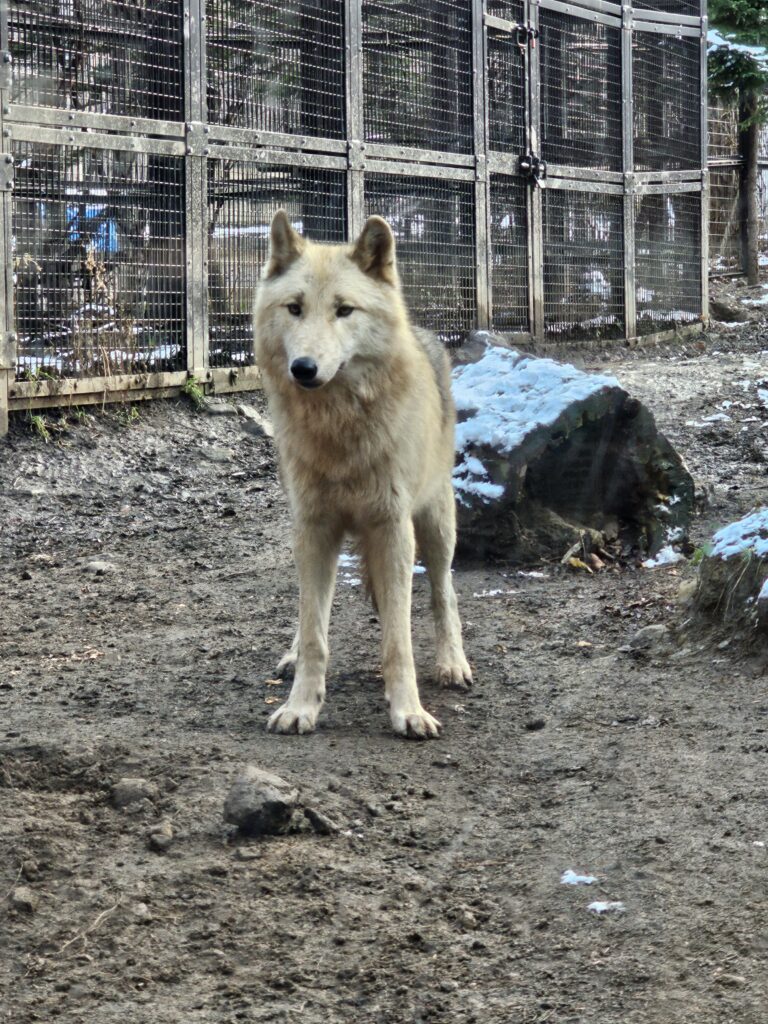
Maruyama-Hachijuhakkasho Trail
Feel like doing some hiking while at Maruyama Park? You can also do that here! There’s a small, short trail within the park that will take you to a point with a beautiful view of Sapporo. The hike takes about an hour both ways. It’s not overly strenous. It will take you uphill though and I was a little winded to be honest. If you take your time and take breaks if needed you will be rewarded with the view though. Just remember to bring some water along as well. The view is worth it. It’s really is quite nice!
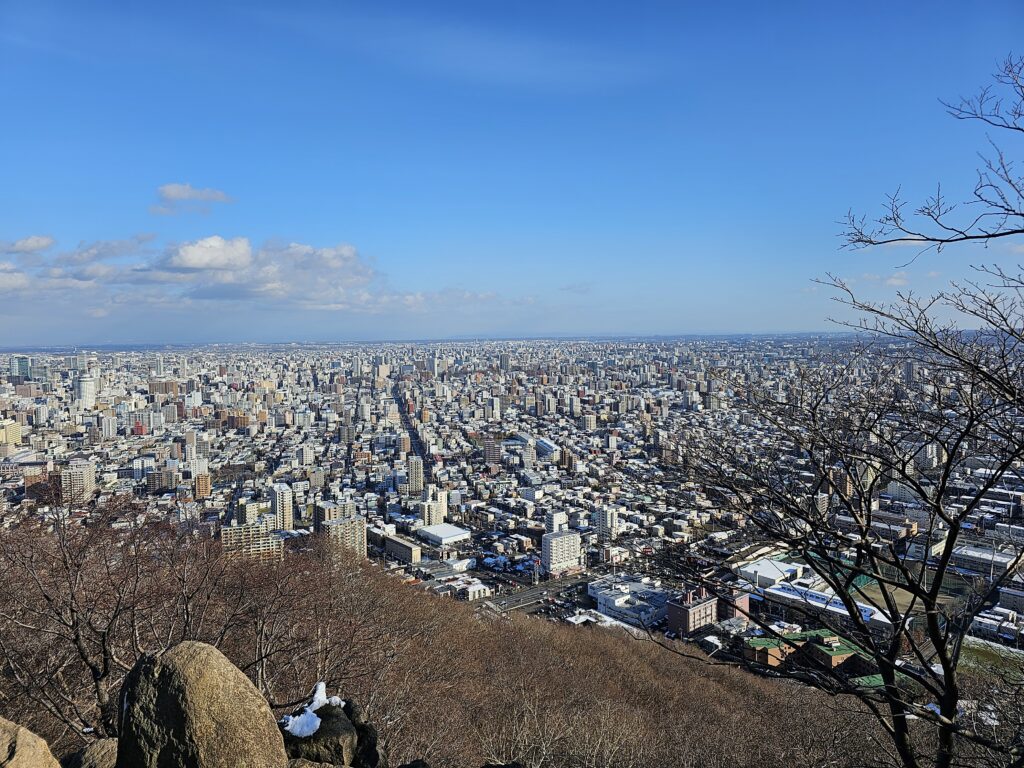
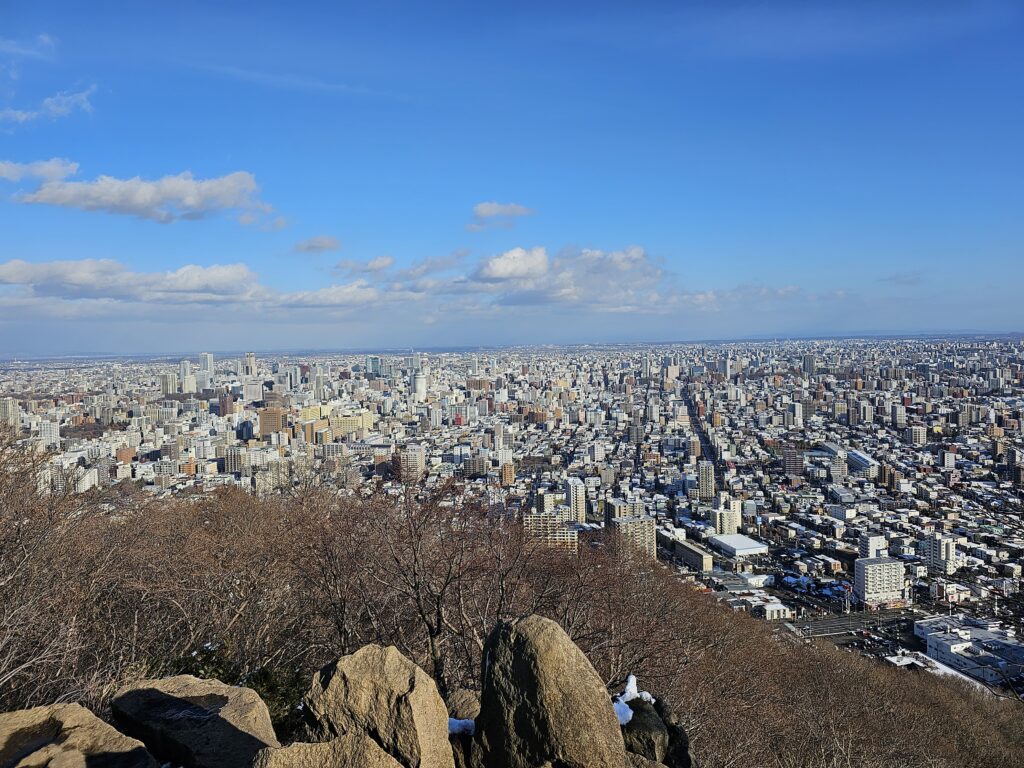
-
Genghis Khan BBQ Is A MUST TRY If Visiting Hokkaido Japan
There’s some well-known, very popular foods in Hokkaido Japan (think soup curry, miso ramen) and Genghis Khan BBQ (also known as Jingisukan) is one of those foods. Like the other two foods mentioned above, it’s a regional favorite and is certainly a comfort food in Hokkdaido.
What is Genghis Khan BBQ?
Genghis Khan BBQ is grilled mutton with a mixture of vegetables like beansprouts, onions, mushrooms, peppers, and others. It’s also served with a dipping sauce on the side.
The shape of the grill is very unique and definitely stands out. It’s a rounded iron pan with a domed grill which slightly resembles that of an old helmet. Meat is placed at the top of the dome and the vegetables placed on the bottom, around the edges of the grill. Think the brim of the helmet. The vegetables are placed here so they can soak up the the meat drippings and oil, making them even more tasty.
The Food
There’s a lot of Genghis Khan BBQ places in Sapporo. Since I was staying right next to the popular Susukino district that’s where I gave it a try. I stumbled upon a restaurant named 63 Roksan Genghis Khan and was fortunate enought to get a seat without a reservation.
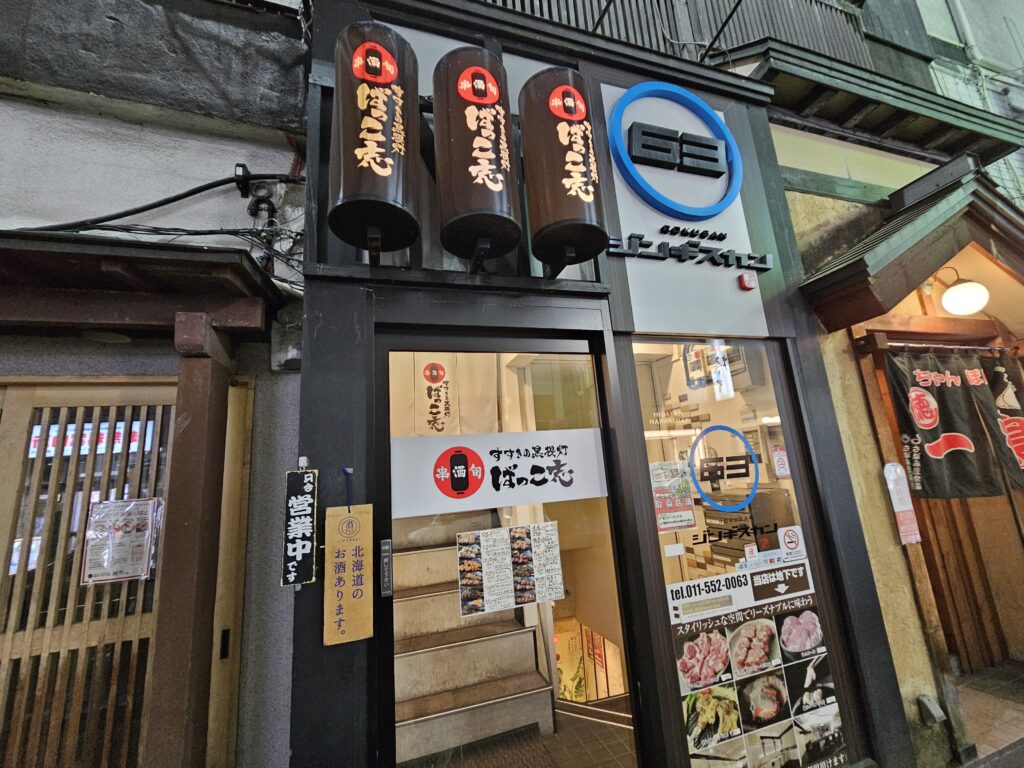
The layout strongly resembles that of a Korean BBQ place with grills at every table and at the counter which is where I sat.
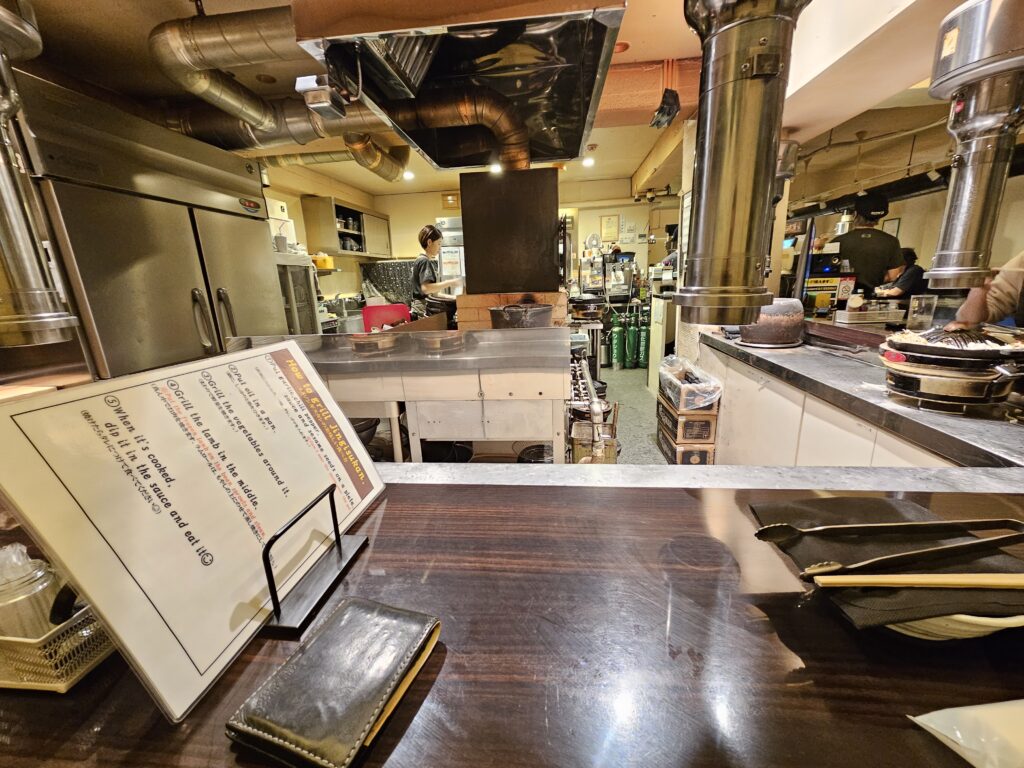
These grills though, unlike Korean BBQ grills, have that unique “helmet” like shape to them.
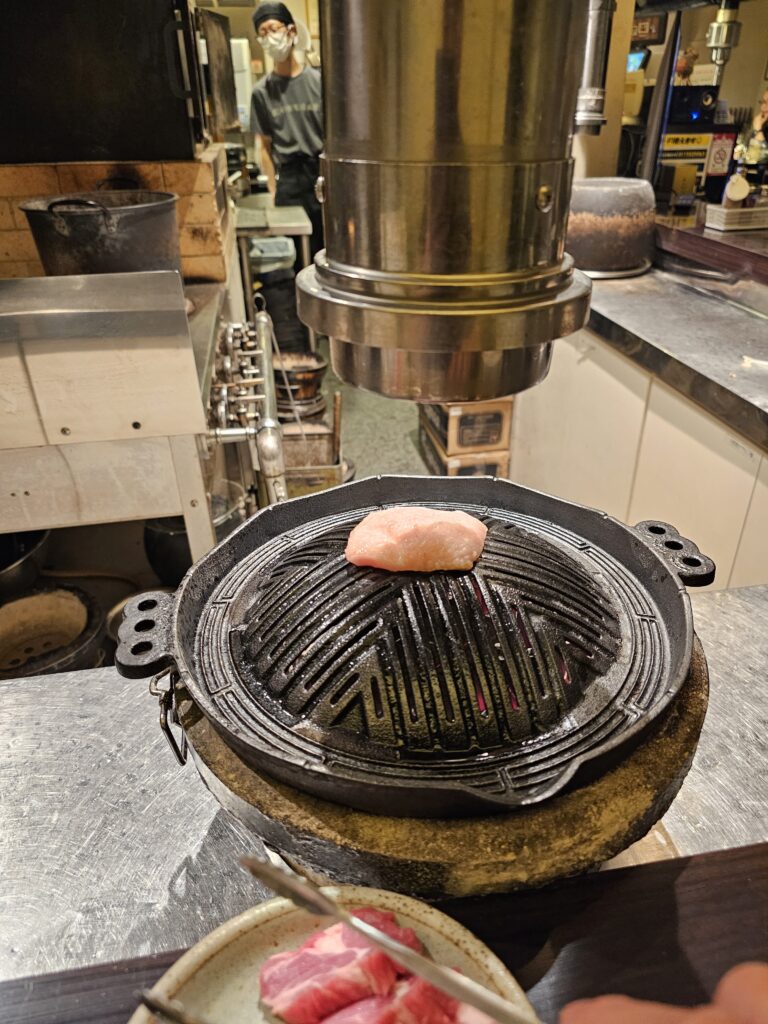
The experience is also unique since you get a piece of fat to grease up the grill.
I loved that they had a simplified English menu here. There was an easy to choose trial set that included grilled vegetables, lamb chuck, lamb dice steak, frozen lamb slices, and a sausage set (1900 yen, $12.56). I opted for this since I wanted to give everything a try and figured these were the most popular lamb cuts.

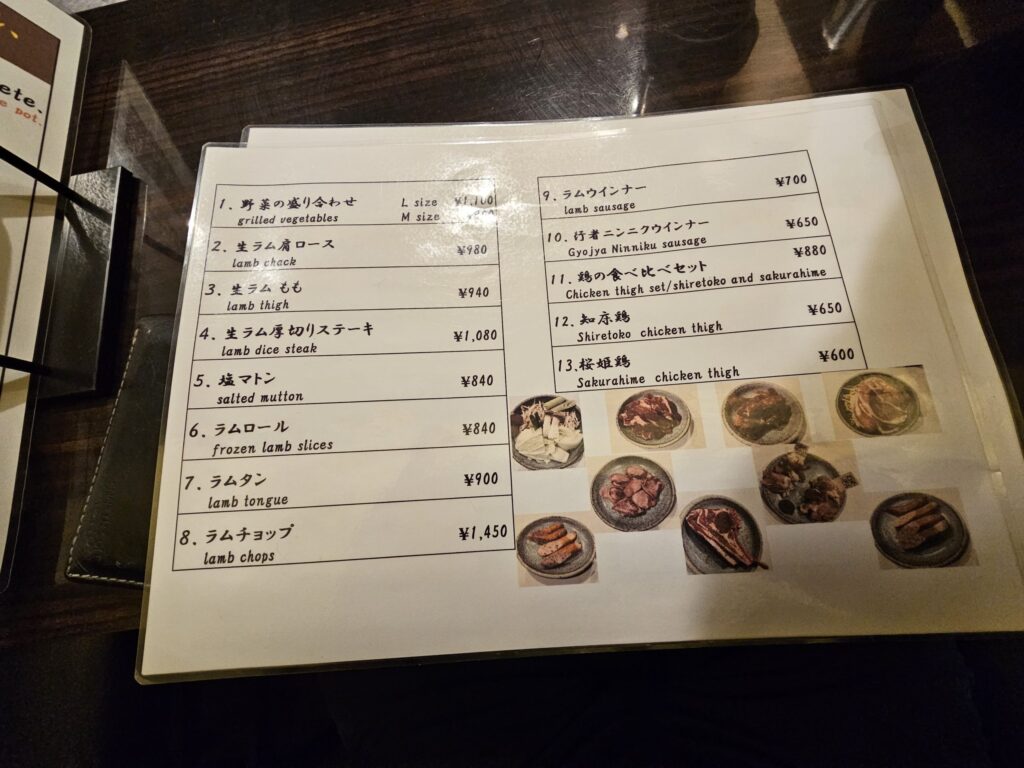
Something else that was helpful was they offered English instructions on how to make the dipping sauce and properly grill everything, which was definitely helpful for a complete noob like myself.
Without this there definitely would have been some trial and error or awkward staring at others to figure out how to correctly cook everything, lol.
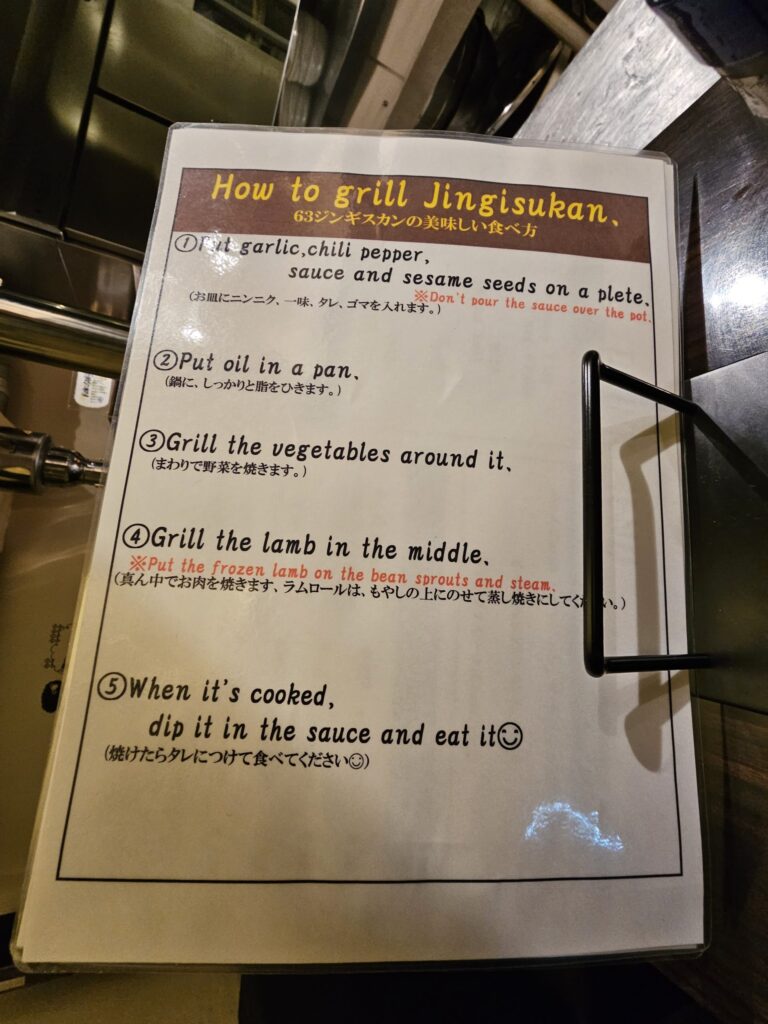
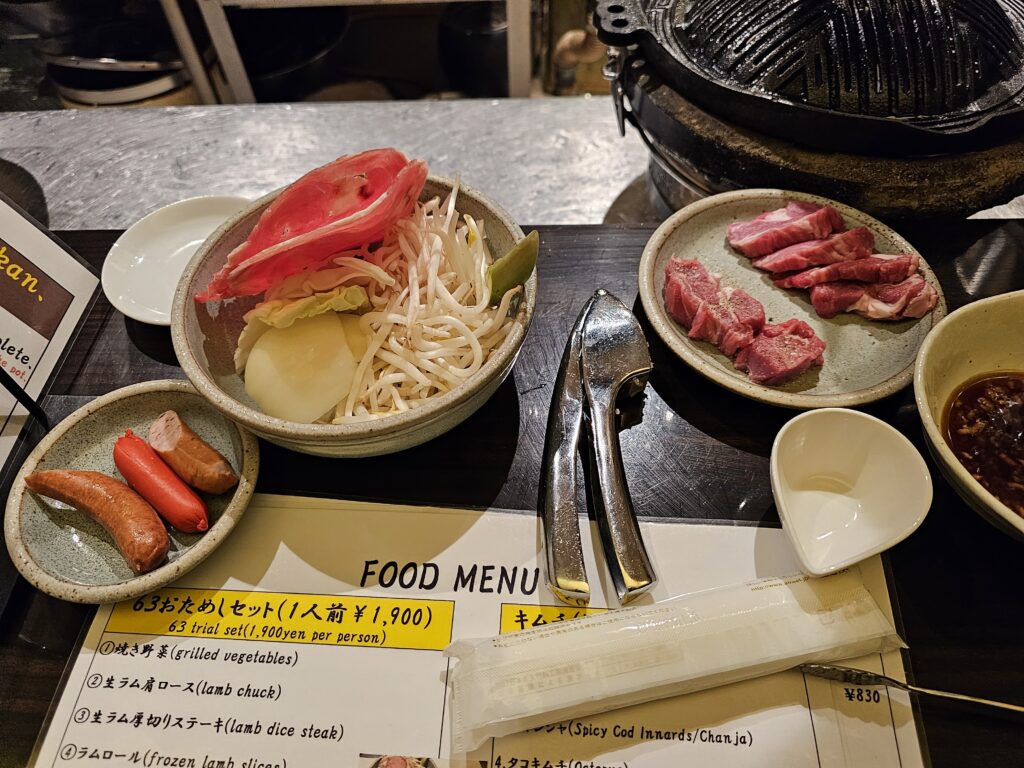
This was the spread of everything included in the meal. It didn’t turn out to be a TON of food, but I think it’s meant more to be a sampler, then you can order more a la carte.
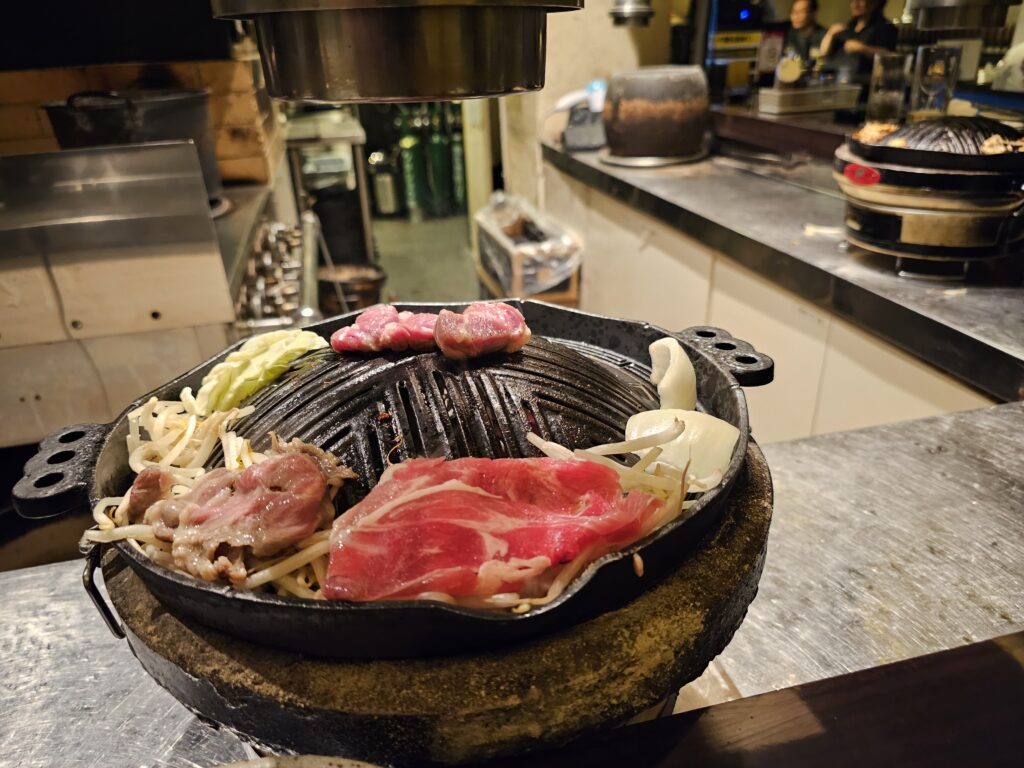
This is how it all looks when you throw it on the grill. For the frozen lamb, since it’s so thin, you put it on top of the vegetables to cook as they absorb the juices that roll off the meat.
After this it’s just straight grilling meat. I’m no lamb connoisseur but found this to be very good. The meat was really tender and juicy. I expected it to be a little gamey but didn’t notice that at all with these pieces.
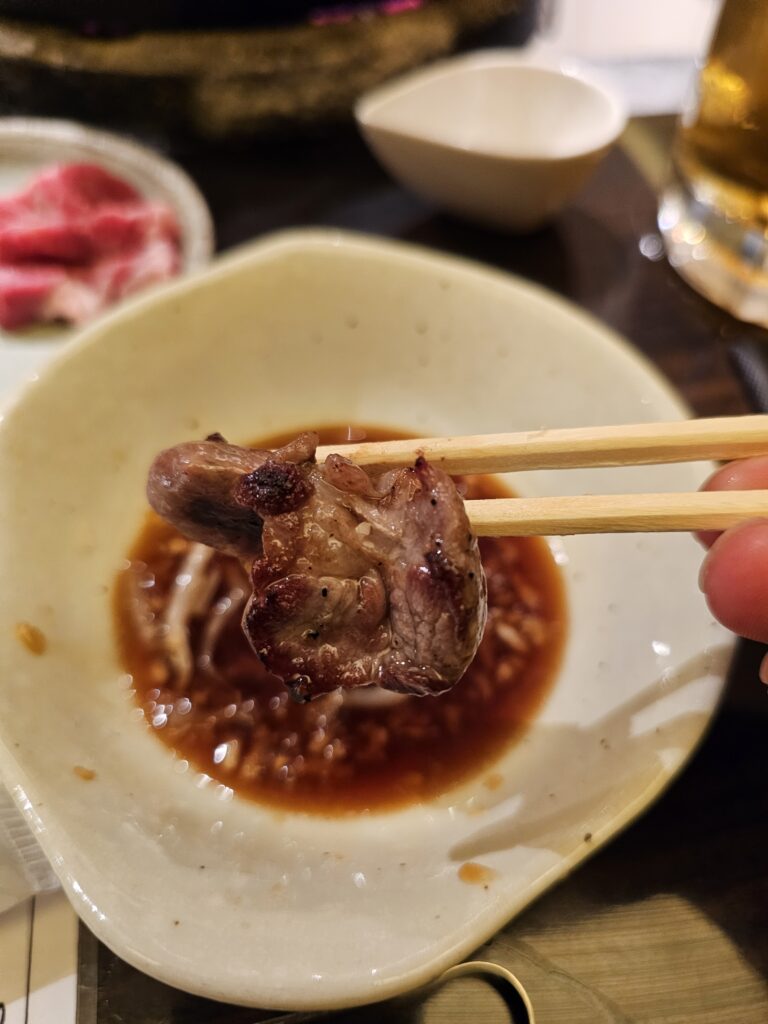

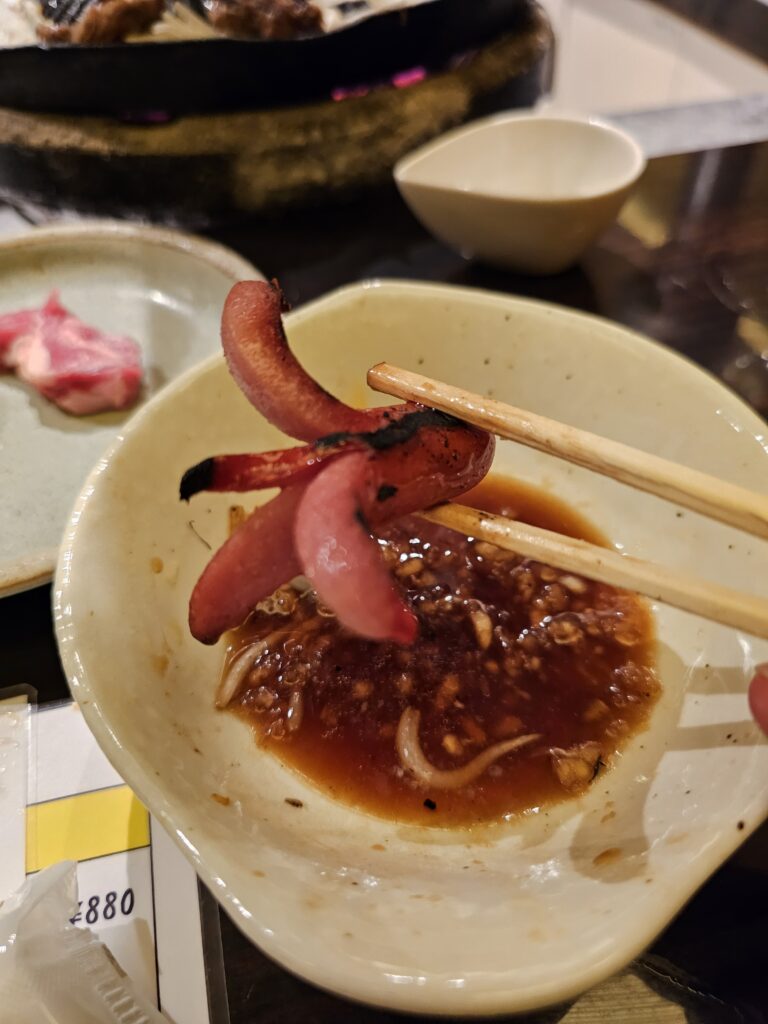
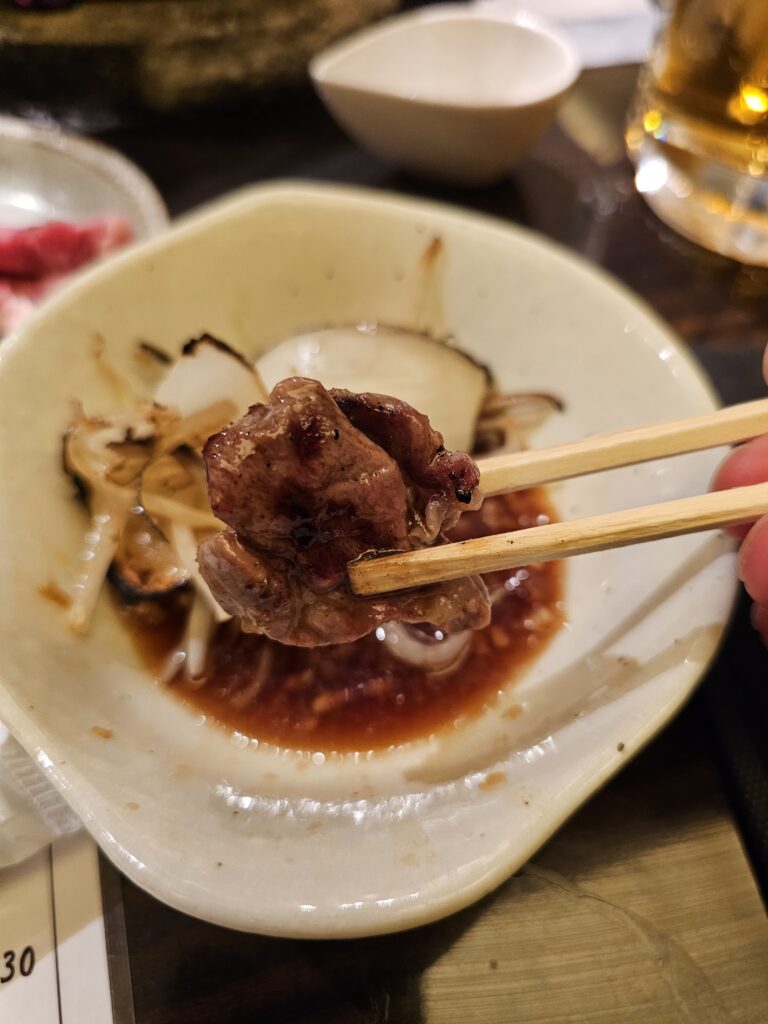
The dipping sauce which consisted of garlic, chili pepper, sesame seeds, and soy sauce complements the flavor of the meat well.
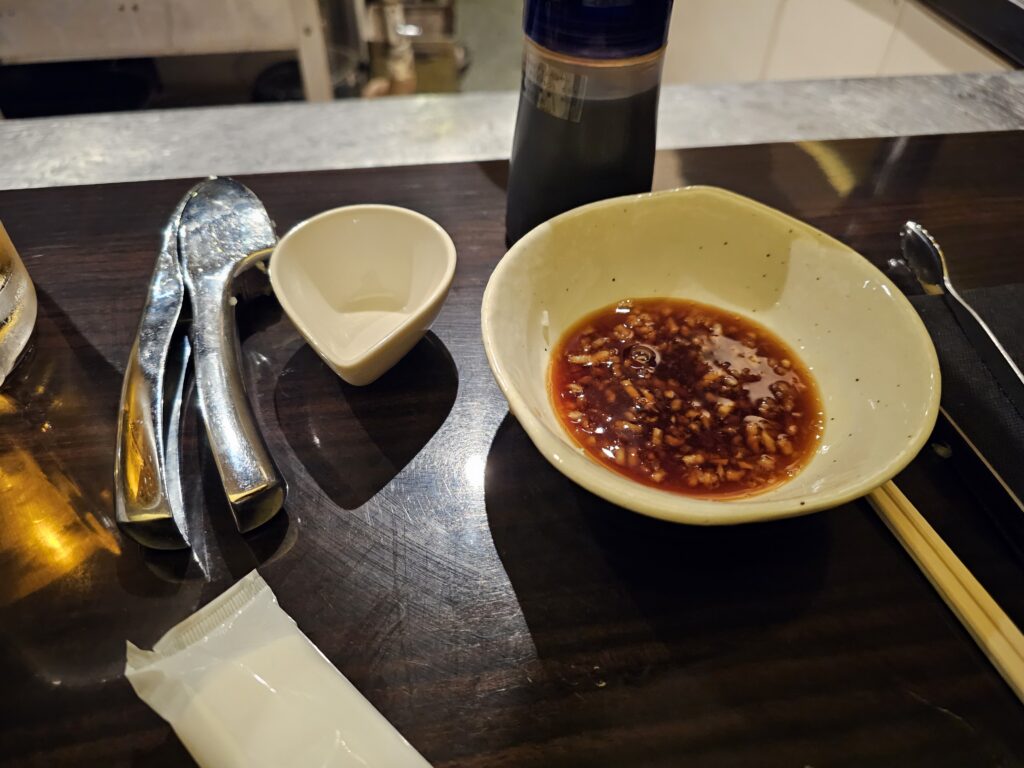
Final Thoughts
Overall, the meal was very good. Any one that’s had Korean BBQ will feel at home eating this meal. There’s obvious familiarity with it, just with a slight twist due to the the grill. It’s a really fun experience. Grilled meat with an ice cold beer, you can’t ask for much more. Without a doubt Genghis Khan BBQ is something you’ll want to try if visiting Hokkaido. It’s immensely popular for a reason!
On a side note, I’m not sure if it’s the case everywhere in the city (Sapporo specifically), but I found that reservations are definitely needed around dinner time.
I was able to get into 63 Roksan but they did ask if I had reservations (I did not). They were kind enough to accommodate me but other places I went to for Genghis Khan BBQ were fully booked for the evening and couldn’t seat me without a reservation. So I’d definitely recommend booking a reservation if interested in giving Genghis Khan BBQ a try. This is one popular meal in the city!
-
The Ramen Alley in Sapporo Hits The Spot For Ramen Lovers
What is the Ramen Alley in Sapporo?
The Ramen Alley in Sapporo is located in the lively Susukino district. This narrow alley has been around since 1948. Shockingly, there’s nothing but ramen shops found in this delightful alleyway, who thought with a name like that? Lol. The original Ramen Alley opened up with eight total ramen shops. There are now 17 that line the famous alley. Miso Ramen was also created here, adding to the lore.
These shops are all quite tiny, most likely seating no more than 7-15 people from what I could gather walking by. Since this is a tourist spot expect crowds, especially at peak lunch / dinner times for the most popular spots. All the shops have varying hours as well so if you know the specific place you want to go to make sure to check their hours.
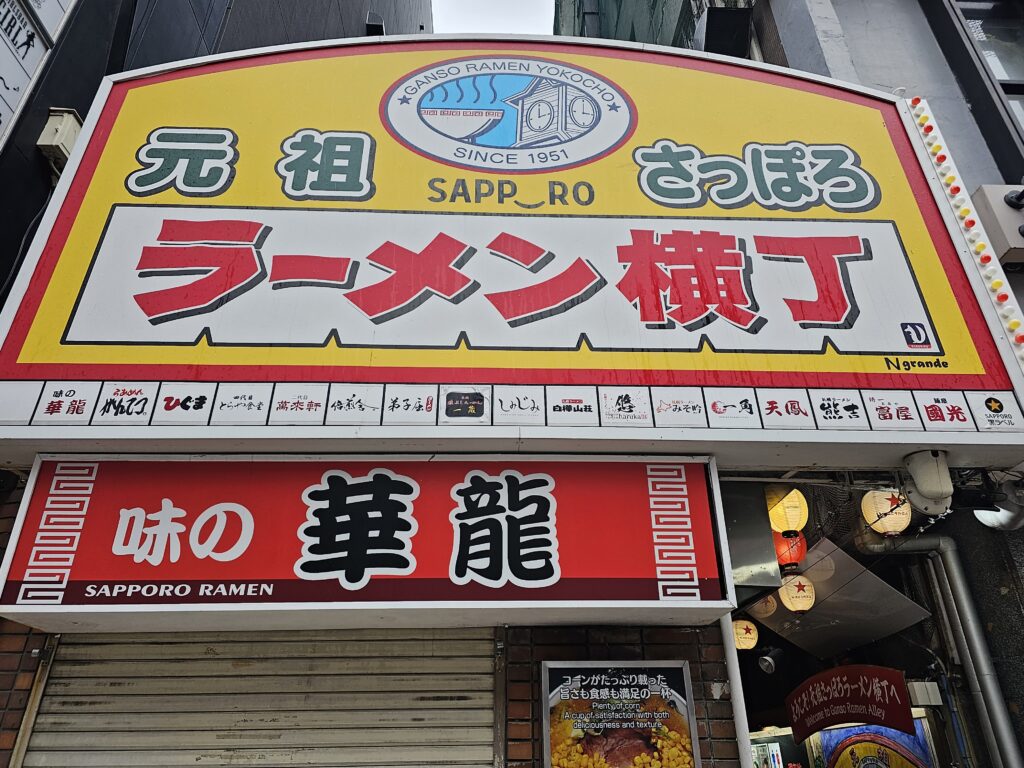
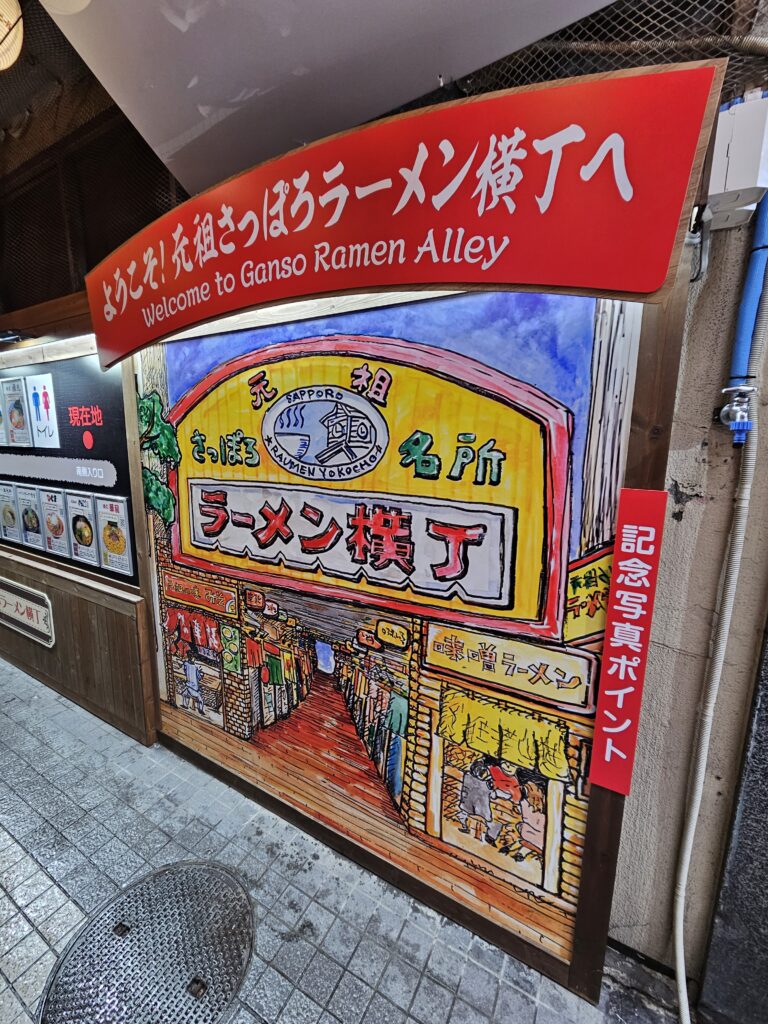
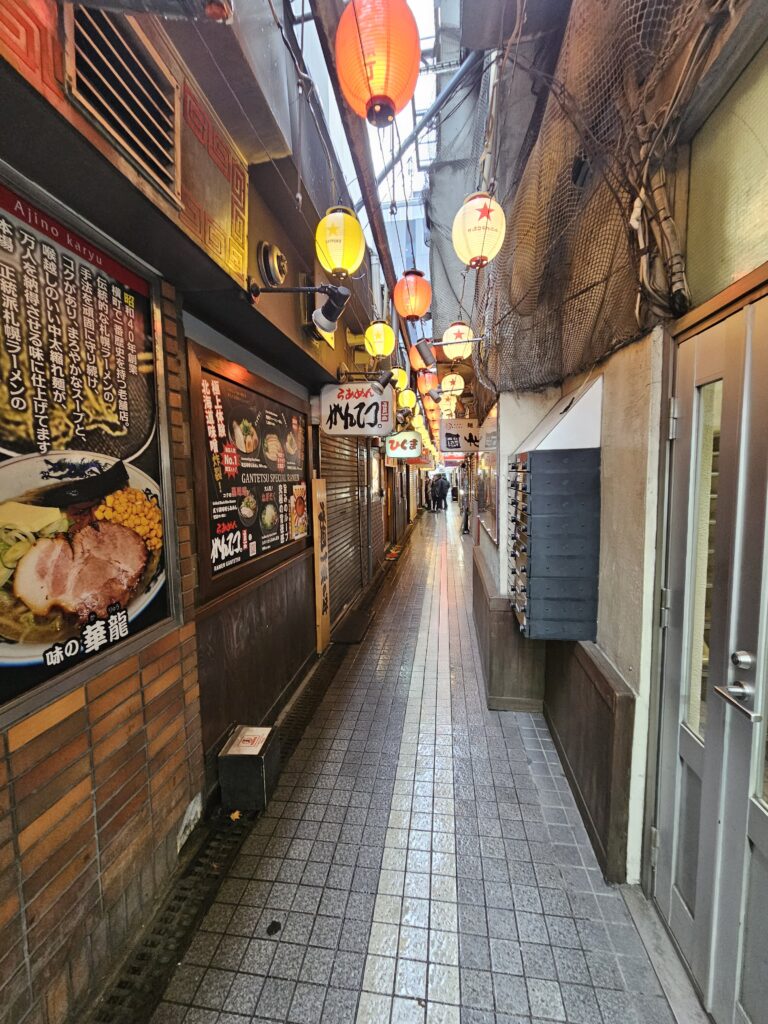
I got here at an odd time when some shops weren’t open yet but was able to find a seat at Ichi Kura.
Ichi Kura
Ichi Kura was one of the places that were open and had available seats. I hadn’t done any research on the individual shops themselves, so I wasn’t sure what the most popular or well-know shops were. The ramen pictured in front of the shop looked great though so I decided to give it a try.
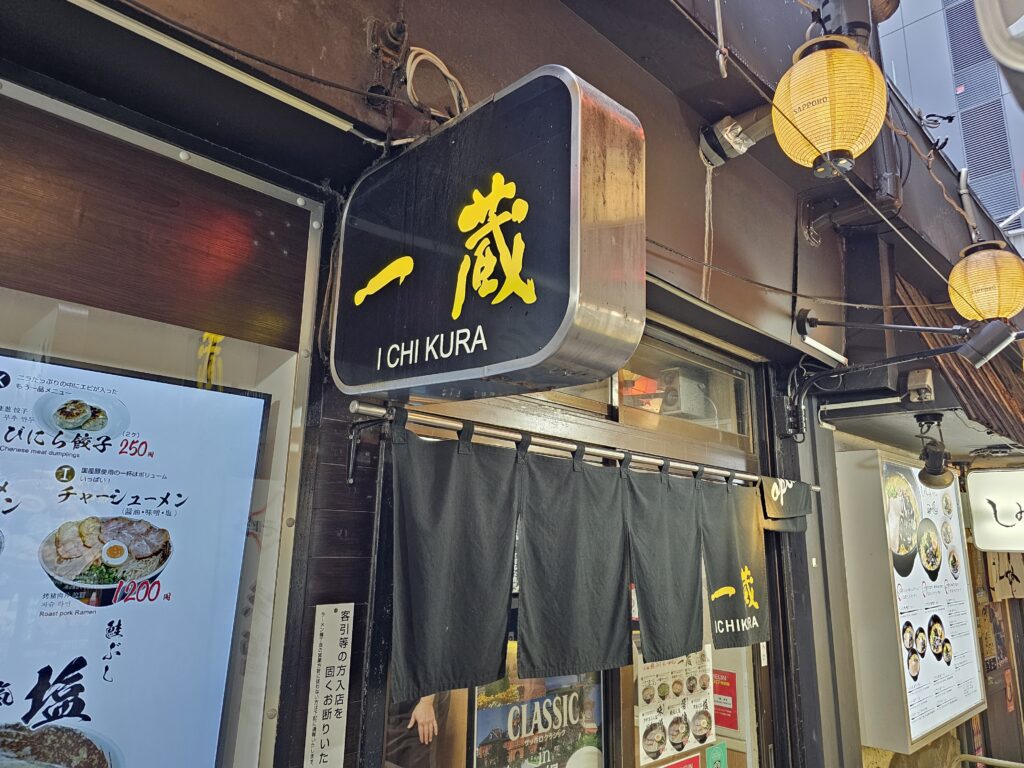
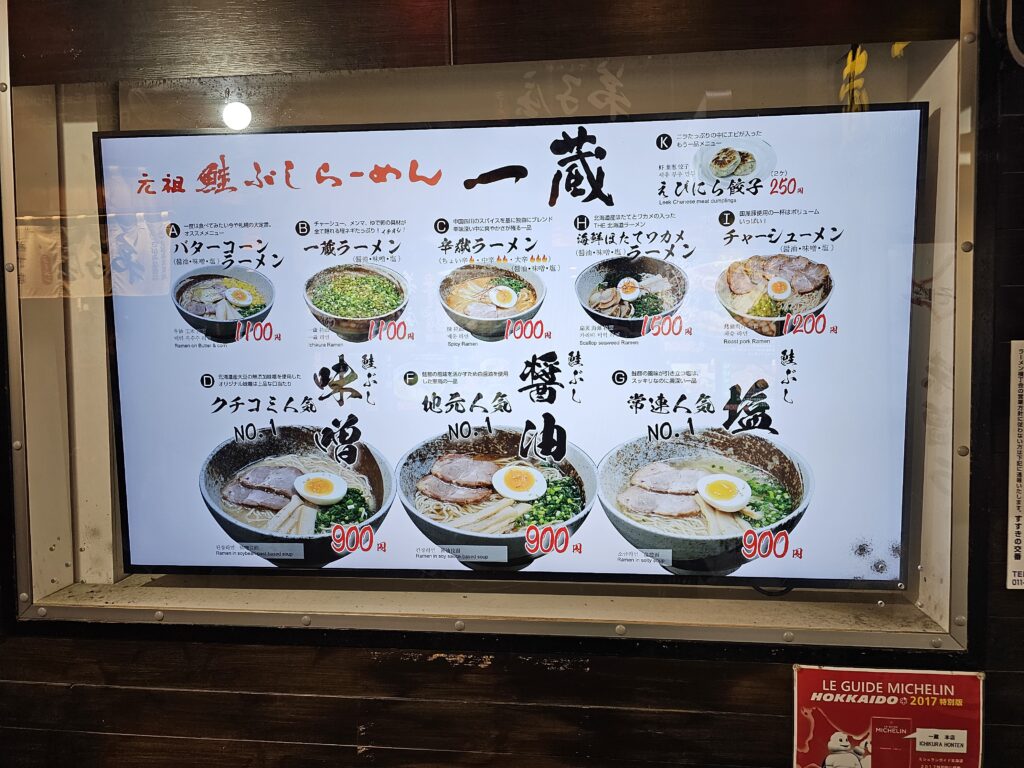
Toppings that are more uniquely associated with Hokkaido include corn and butter. Hokkaido is known for their dairy and produce so this would be the place to get those toppings in your ramen!
The Ramen
Like I mentioned above, the main driving force behing getting this particular bowl was for the butter and corn. I’m not entirely sure what the broth was, possibly shoyu, but it was very light. The butter once, melted really adds a richness and creaminess to it which was a welcome addition to the overall flavor. In addition to the butter and corn the ramen was topped with bamboo shoots, green onion, half an egg, and chashu.
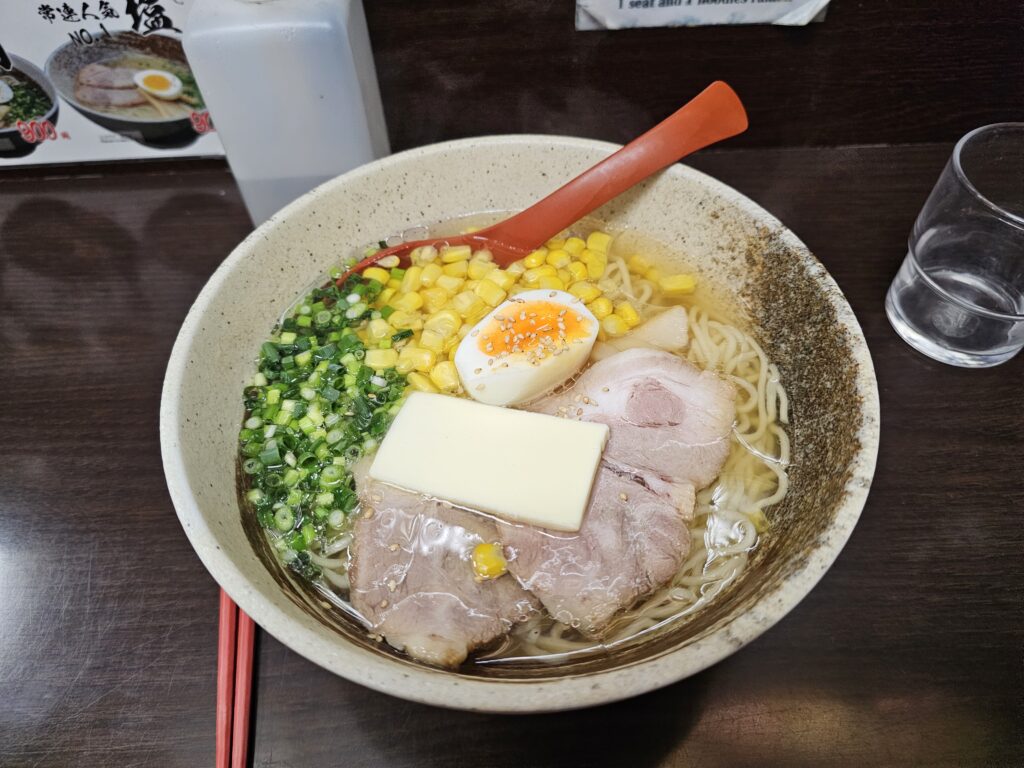
The semi-firm noodles were light, springy, and fresh. The egg was nice and runny, and the corn was definitely sweet. All solid additions to go along with the bamboo and green onion. The chashu was good, but nothing to really write home about. Definitely tender but was lacking in flavor to a certain extent. Overall the bowl of ramen was really good. I did enjoy the butter and the corn so I was glad I got the chance to give it a try.
Is the Ramen Alley in Sapporo worth a visit?
If you’re a ramen lover like myself, without a doubt you’ll want to visit the Ramen Alley in Sapporo. Can you imagine an alley lined with nothing but ramen shops? It’s a ramen lover’s dream! It’s just a cool experience as well since the alley is quite narrow and the shops are all quite small. It’s fun walking by and checking out the different types of ramen that each shop offers. Next time I go I’ll have to do a better job of researching the restaurants to know which ones I should target!
-
Top 7 Things To Do In Hakodate, Japan
Hakodate is one of the main cities located in Hokkaido. It’s the third largest city after Sapporo and Asahikawa. If taking a bullet train from Tokyo, Hakodate is the last bullet train station into Hokkaido. The trip will take about five hours.
Some people will choose to hop on another regular train and head to Sapporo but Hakodate is worth spending a couple days in to explore. Even though it’s the third largest city in Hokkaido, it’s not too big. It’s very laid back and things are slower paced here. If coming from Tokyo, it’s a nice break from the crowds and the hustle and bustle. Two days will be good enough to see all the sights that Hakodate has to offer.
Mt. Hakodate Observatory
One of the top things to do in Hakodate is making a trip to the Mt. Hakodate Observatory (1800 yen, $12.24 USD) at sunset or at night to enjoy the panoramic view of the city. It’s certainly a spectacular view with water on either side of this particular part of town. There’s technically not a best time to go here. Day or night you’ll get a beautiful view but I’m more partial to the night when the city is fully lit up. It’s a pretty sweet view! Nighttime is also the busiest time to go so expect to see some crowds on the observatory deck. There’s also a restaurant and gift shop located here if you want to hang out a bit and soak in some more of the view.
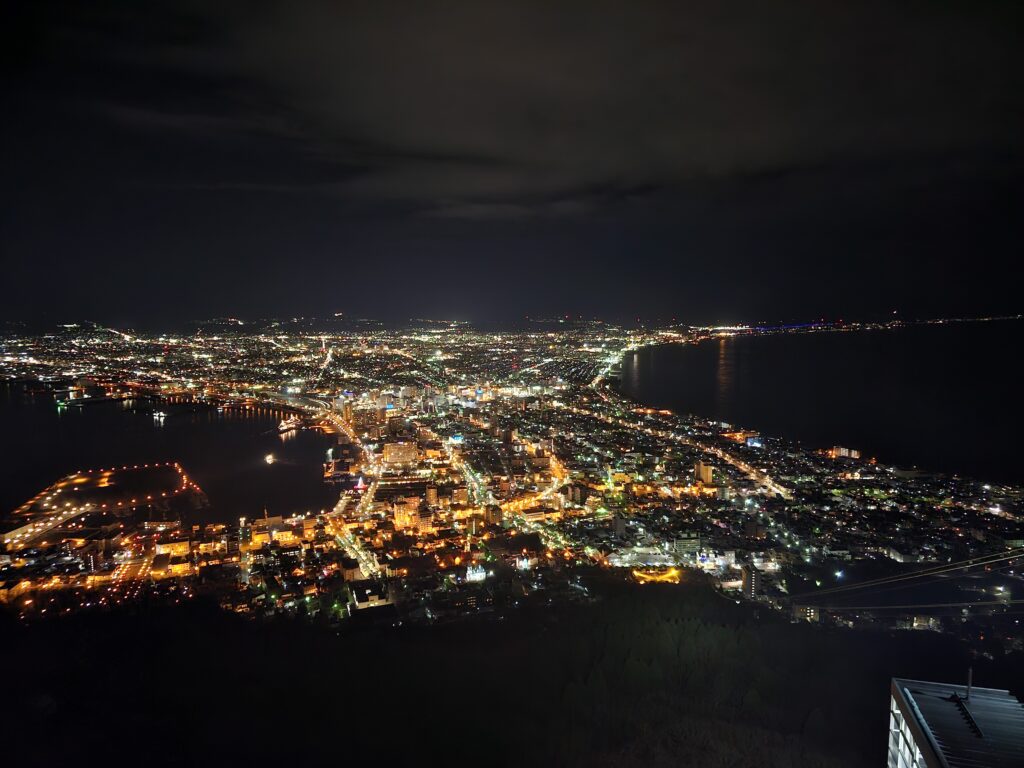
Fort Goryokaku / Goryokaku Tower
I’ll fold these two attractions into one. But you can certainly do one or the other and skip the other one if you wanted to. Fort Goryokaku is the iconic star shaped fort located in Hakodate. Completed in 1866 as a military site in the defense of Hokkaido, the fort was later converted to a public park sometime in the early 1900s when the fort lost its military importance. The star shape of it is really quite unique, as is the moat that surrounds it. There’s not a ton to see here but the grounds are quite peaceful and nice to take a stroll around. There’s also around 1000 cherry blossom trees planted around the fort so if planned correctly during cherry blossom season it would be quite the sight! Visiting the park itself is free.
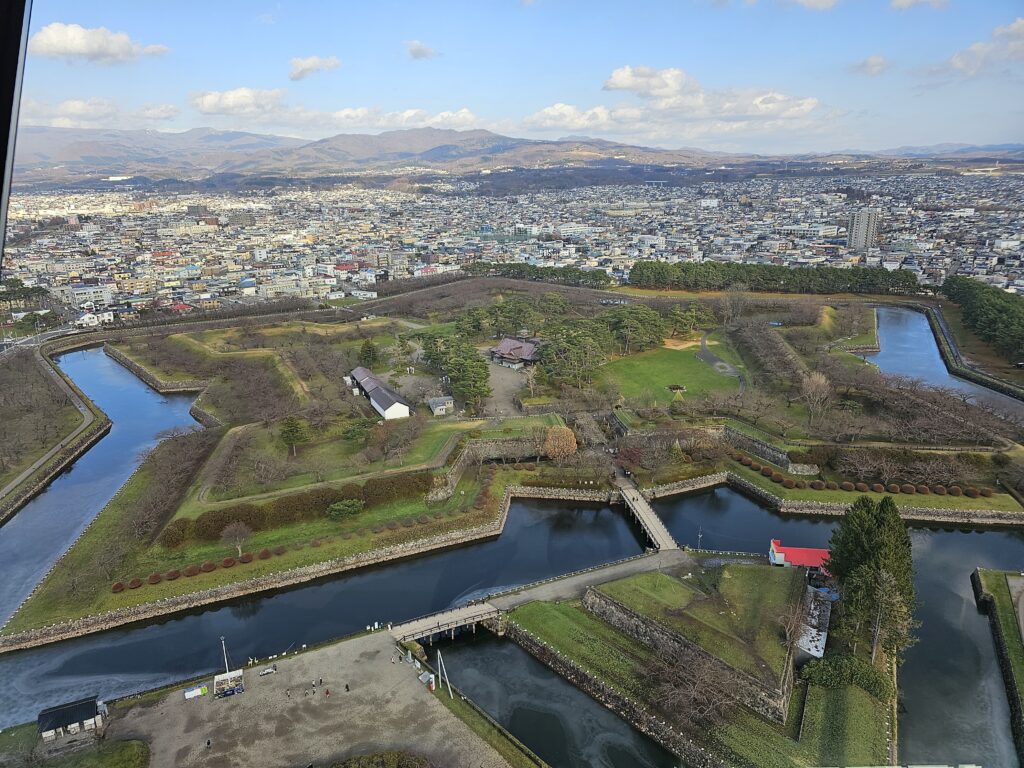
Fort Goryokaku To get a full view of the fort and it’s unique shape you can go up the Goryokaku Tower (1000 yen, $6.81 USD) which has a great view of the fort as well as other views of Hakodate since the tower provides a 360 degree view. There’s also displays up in the tower which provides the historical backdrop of the tower.
Hakodate Morning Market
The Hakodate Morning Market is a four block stretch in Hakodate that sells fresh seafood, vegetables, fruit, and snacks. It’s definitely one of the top things to do in Hakodate in the morning to start your day. It opens from 5am to about 2pm, with about 250 places total, there’s a lot of food options to choose from. The seafood here is outstanding. Even though there’s 250 places here, the market doesn’t seem huge. Crowds are fairly mellow here as well, which is nice.
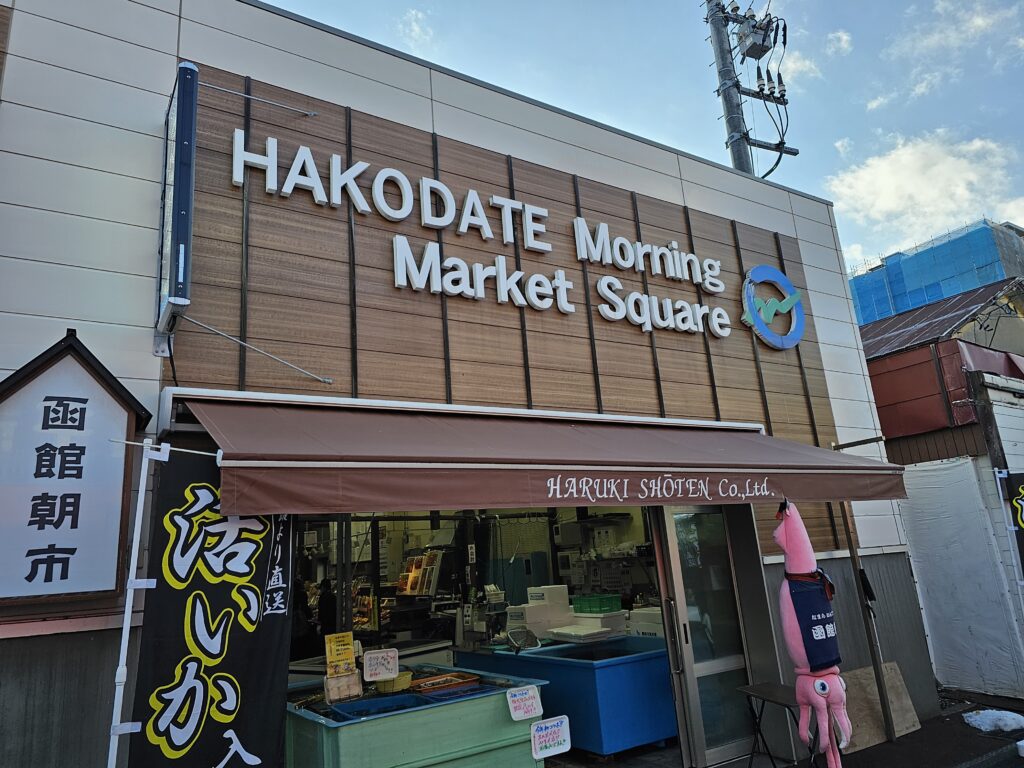
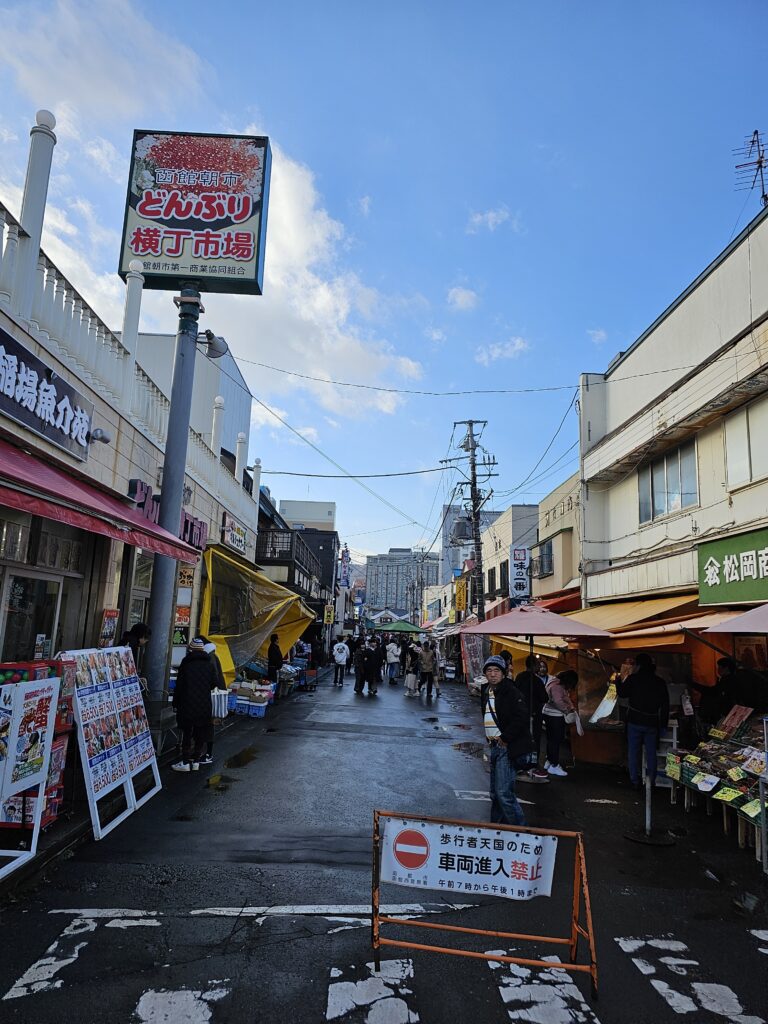
Cape Tachimachi
Cape Tachimachi is a scenic spot in Hakodate with a fantastic view of the ocean, with sharp cliffs surrounding the area. There’s a paved path that loops around on top of one of the cliffs with a great lookout point with a couple benches where you can take a seat and take in the stunning view.
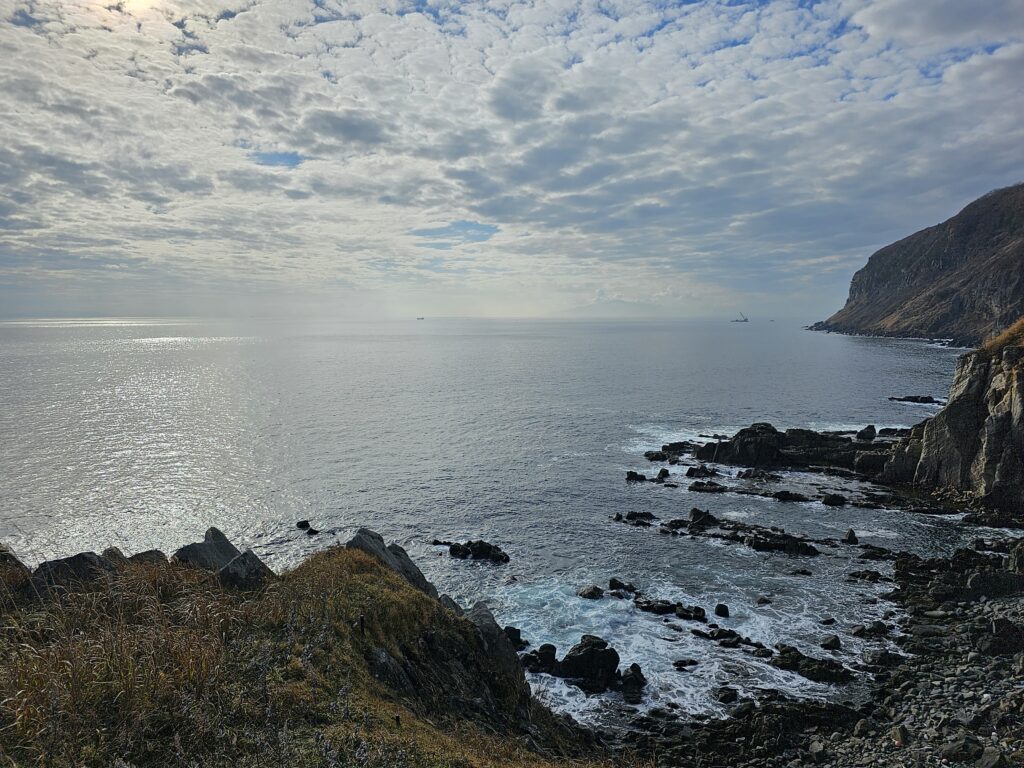
Kanemori Red Brick Warehouse
These old converted red brick warehouses were once used in the old trading days of feudal Japan when the Hakodate port was used for international trade. Now, the warehouses are home to souvenir, clothing, boutique type of shops. There’s a beer hall, restaurant, and some other places for snacks and dessert as well.
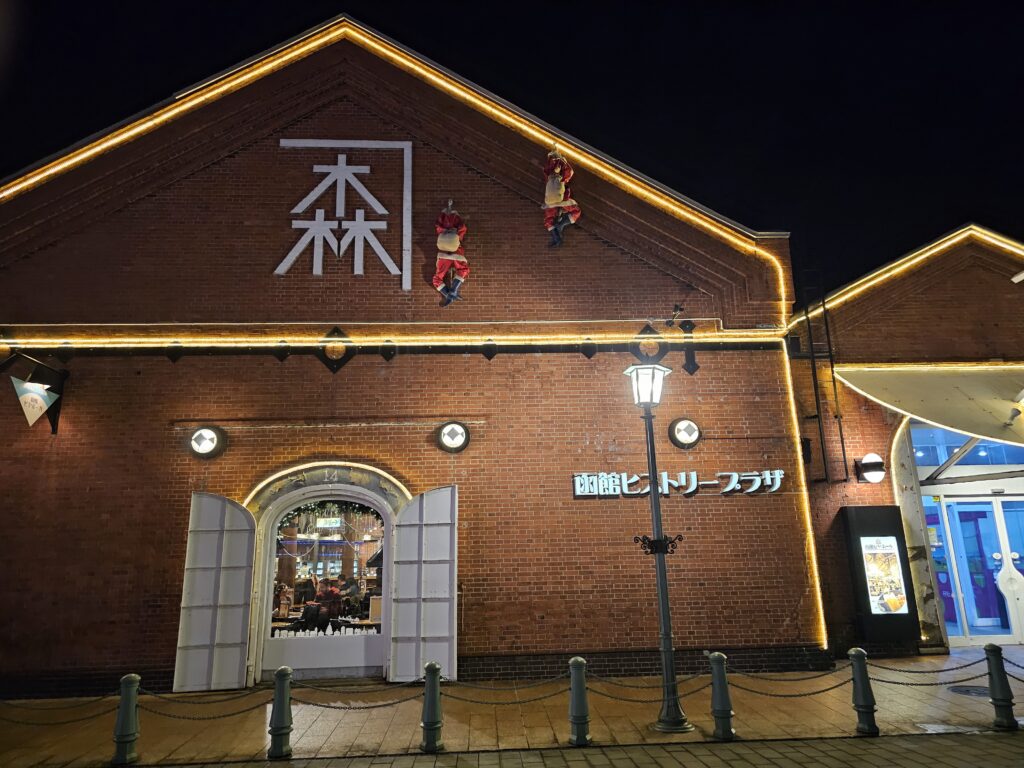
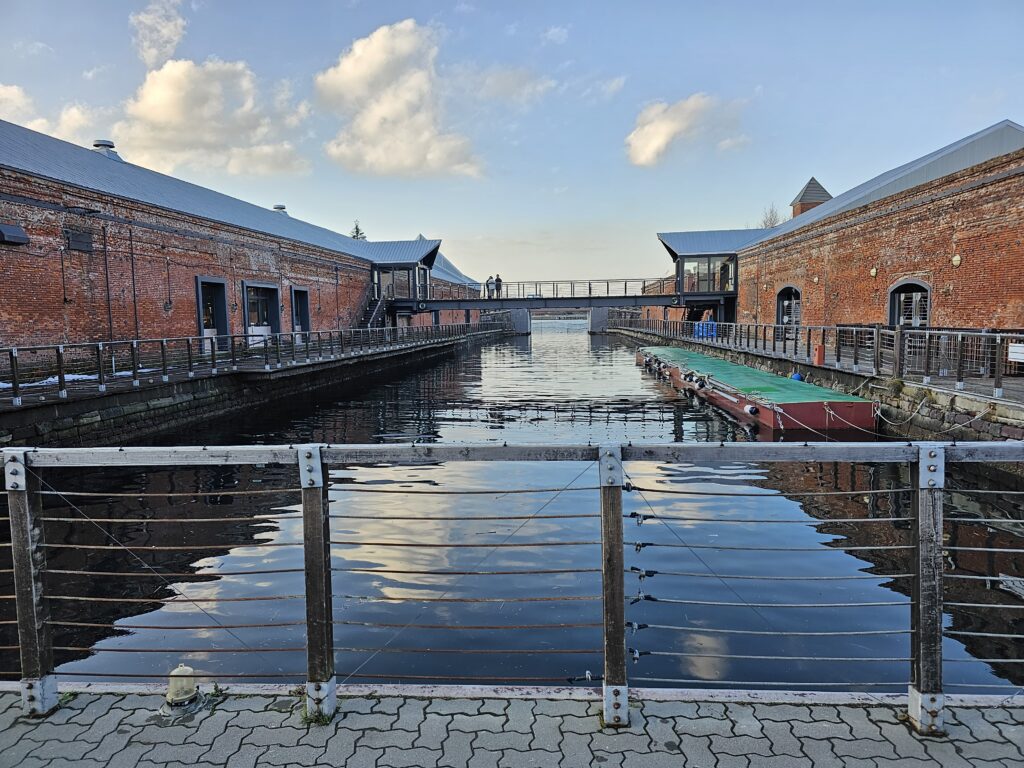
Eat At A Lucky Pierrot’s
One of the top things to do in Hakodate is a place you can both visit and EAT at. Lucky Pierrot is a chain of hamburger restaurants that are only located in Hakodate. There’s a total of 17 restaurants, all of which have their own individual personality and flair. No one restaurant is the same as the next. It’s immensly popular and is a tourist draw. It’s one of those things that you feel you need to try if in the area. I mean you’d try In N Out if you saw it wouldn’t you?
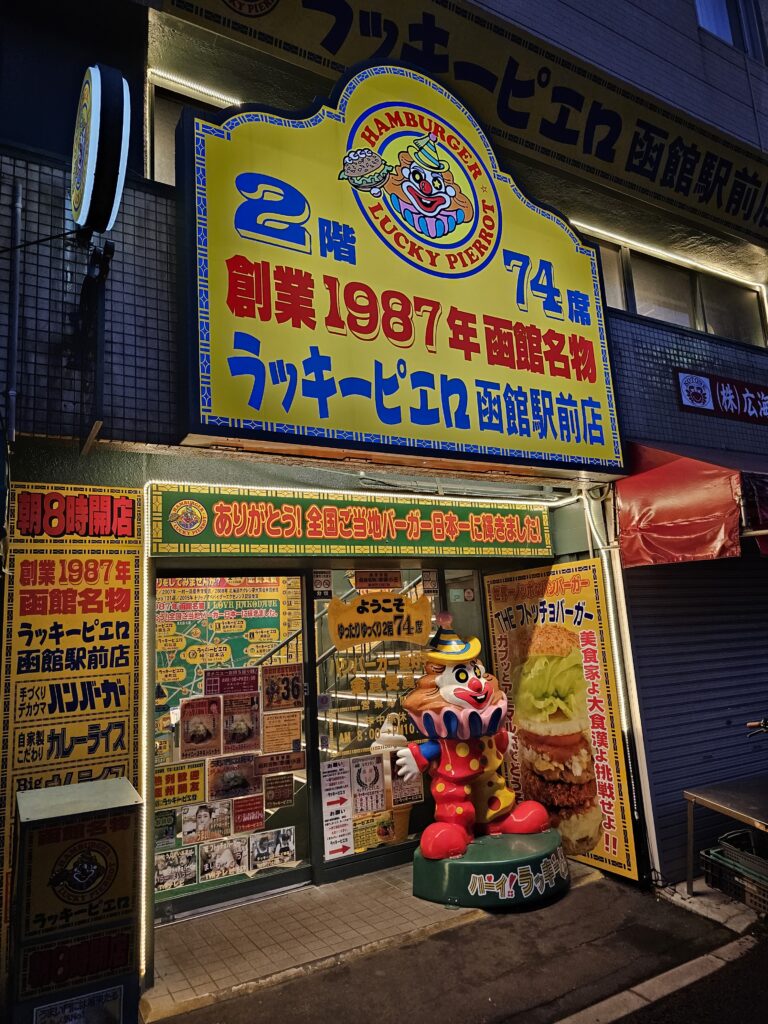
Hachiman Zaka Slope
Hakodate’s most famous slope, Hachiman Zaka Slope provides a scenic view on top of a hill down a stone paved, tree lined street, with a view that leads down to the bay. During Christmas time the trees are adorned with lights which provides quite the setting at night.
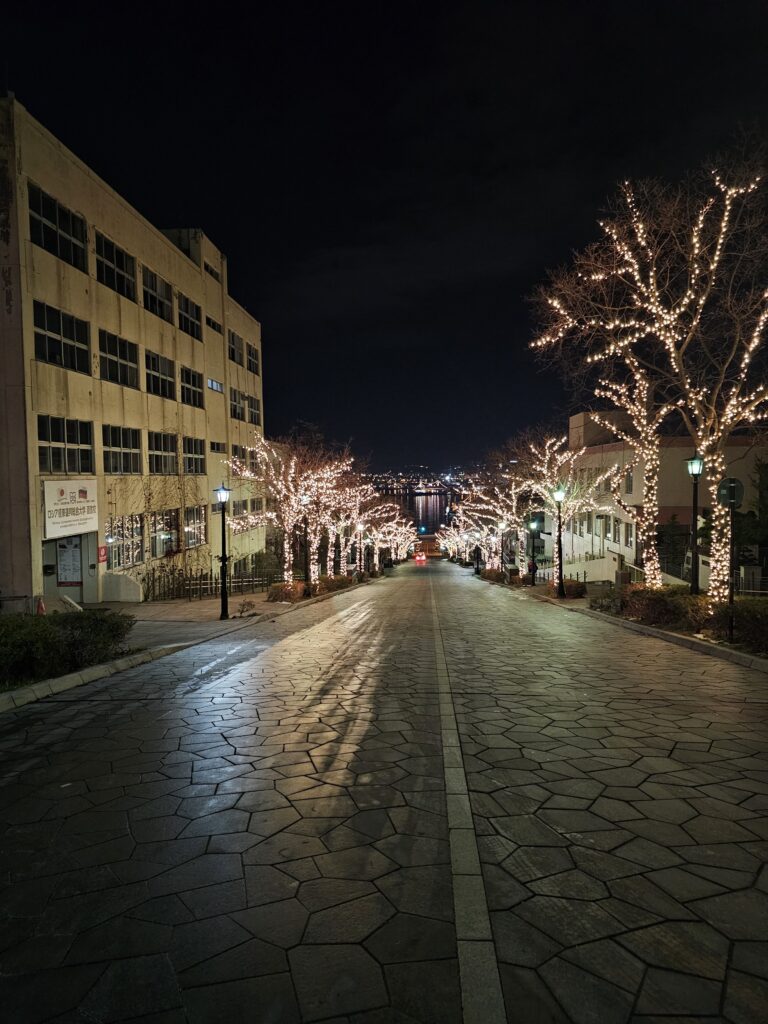
-
The Unique Lucky Pierrot In Hakodate, Japan Is A Must Visit
Lucky Pierrot – Background
Lucky Pierrot is a chain of hamburger restaurants located in Hakodate which is located in Hokkaido in Japan. Founded in 1987, Lucky Pierrot has 17 restuarants…all located in Hakodate. It’s immensely popular there.
So what makes it unique? In the age of franchising and trying to make as much money as possible, Lucky Pierrot has resisted doing so. It’s only found in Hakodate. The owner, Ichiro Oh, has kept the local brand, well, local, despite overtures to grow the brand outside of Hakodate. All ingredients used at the restaurants are local and fresh which wouldn’t make it possible to open restaurants outside of Hakodate. In a time when restaurant chains are always looking to expand and grow, Lucky Peirrot has done the opposite in order to ensure their quality standards don’t suffer. It’s quite a refreshing and admirable stance in this day and age.
Something else that’s unique is that all 17 restaurants have their own individual flair and personality. There isn’t a standard Lucky Peirrot layout that all 17 follow. So really each time you step into one of them it’s a little different experience since they all have a different theme.
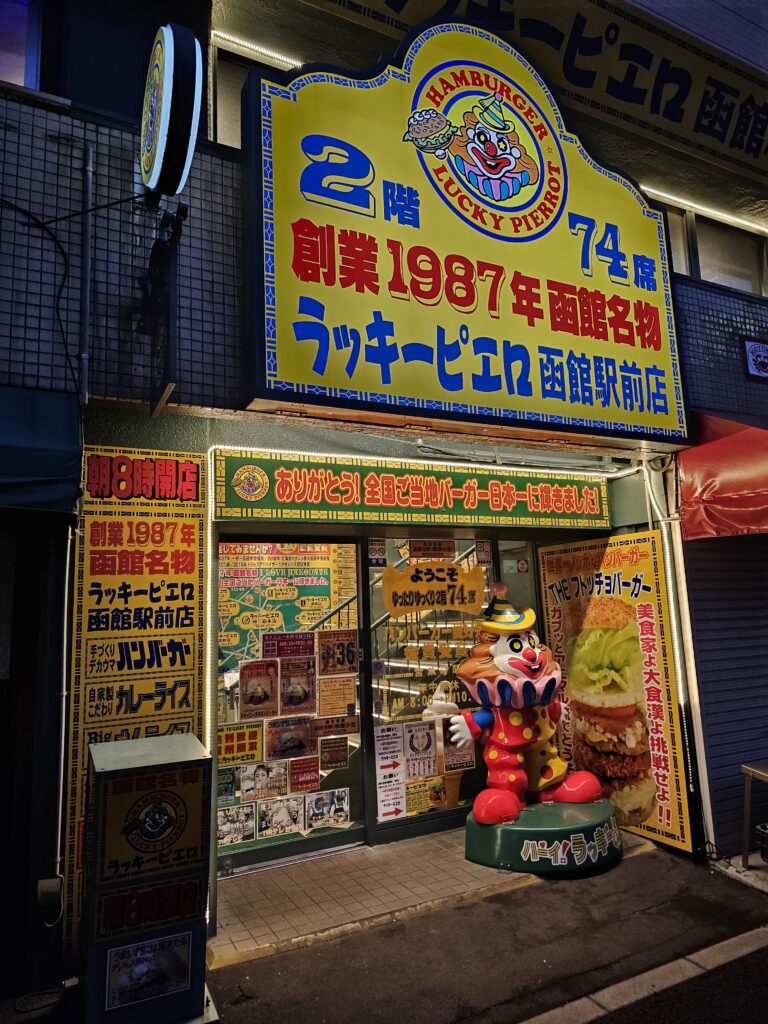
The Experience
There’s a lot going at at Lucky Pierrot’s. The restaurant I went to was pretty hectic with the decorating and VERY colorful. It’s pretty kitschy but in a positive, fun vibey way. They also have a portion of the store with various souvenirs. They even have their own brand of drinks, including an energy drink!
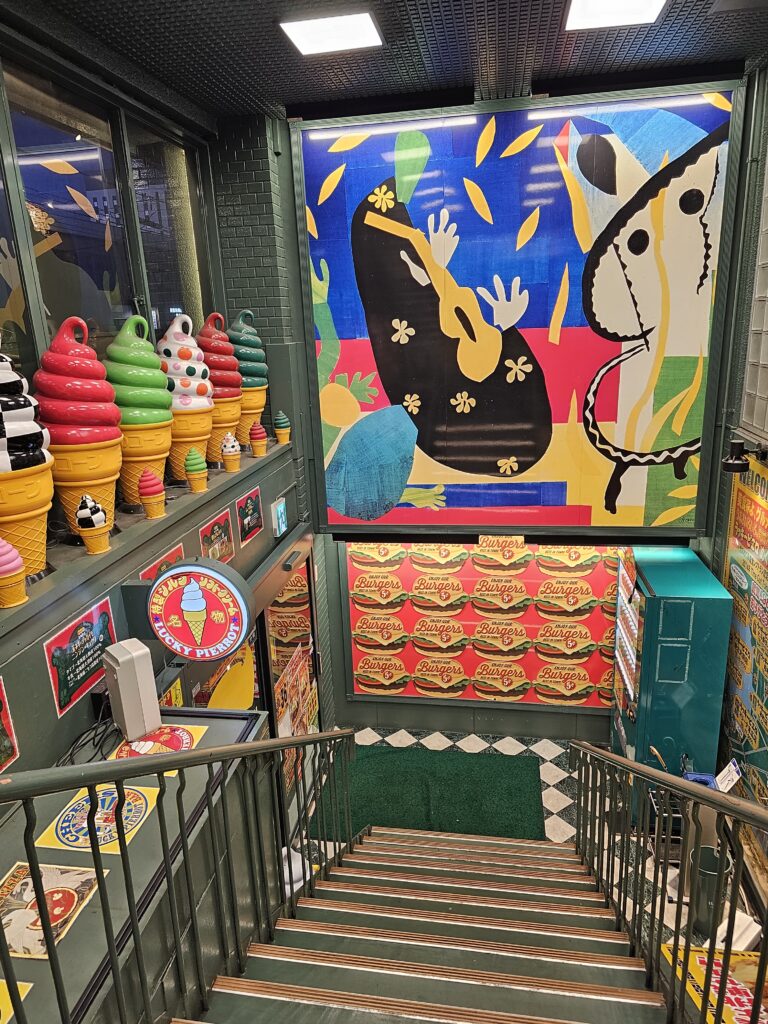
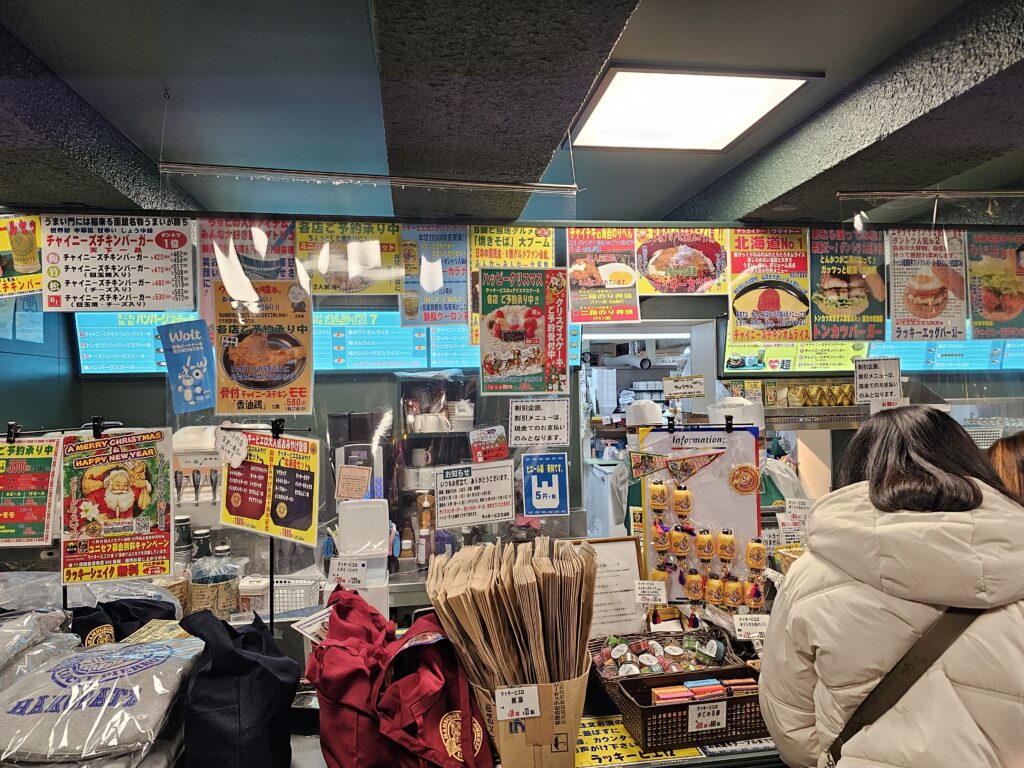
The menu is pretty expansive with a variety of food. There’s burgers, sandwiches, curry plates, pork cutlet bowls and plates, hamburg and steak dishes, and fried noodles. There’s A LOT to sort through. I already knew what what I wanted to try here though. The Chinese Chicken Burger is the original burger and what Lucky Pierrot is well-known for so I had to give it a try!
The Food
I got the #1 combo which consisted of the Lucky Pierrot Chinese Chicken Sandwich, fries with cheese / gravy, and drink (550 yen, $3.66) and also got a soft serve vanilla ice cream on the side (290 yen, $1.93).
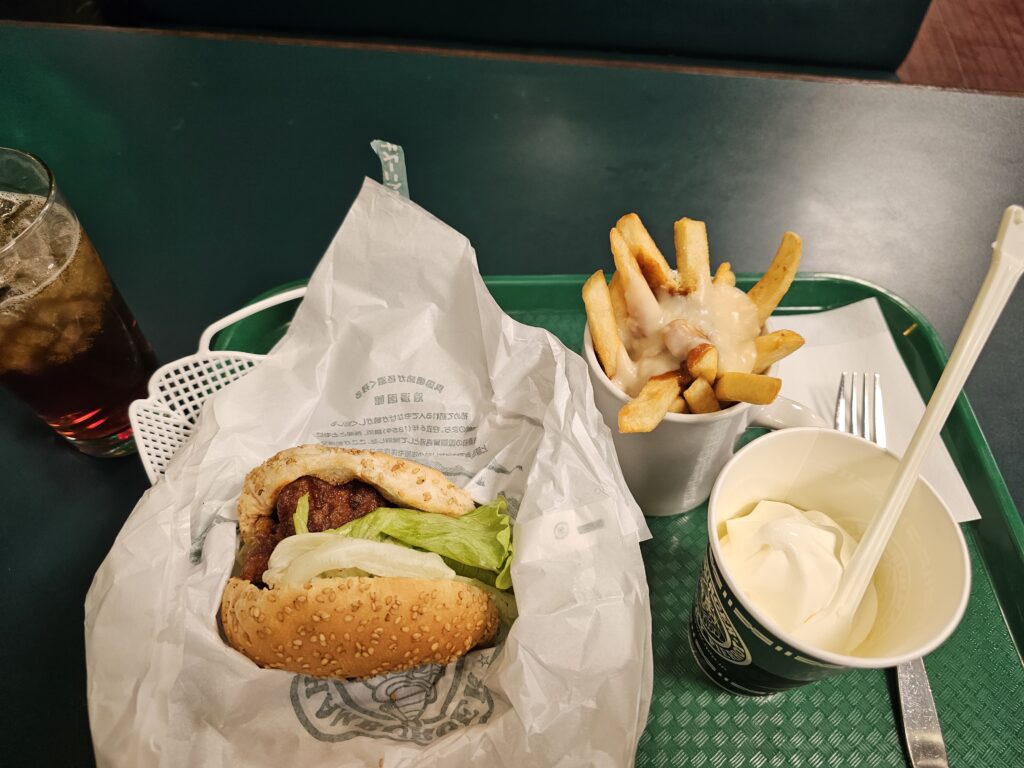
The chicken sandwich consists of two pieces of fried chicken lathered in sauce (think orange chicken essentially) with lettuce and LOTS of mayonnaise. That’s it. Chicken, lettuce, and mayonnaise. It’s a very simple sandwich. The pieces of chicken are tasty and are actually quite tender. There’s just way too much mayonnaise. I had to scrape some of it out. Overall, it’s a pretty decent chicken sandwich.

The cup of fries is lathered in a combination of like a cheese sauce and gravy mixture. I’m not exactly sure what it is exactly to be honest. The taste reminded me of dipping sauce for tonkatsu. So pretty interesting taste and texture to it. The fries themselves weren’t too bad. Nothing to really write home about.
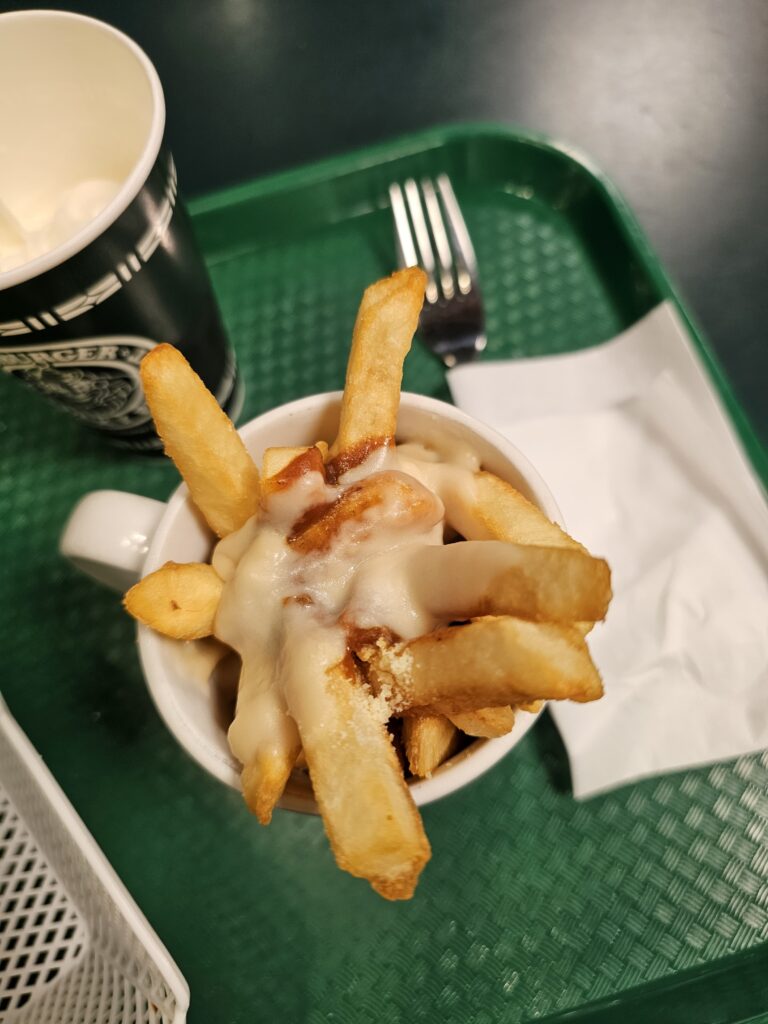
The soft serve ice cream had trademark Hokkaido ice cream traits: rich, creamy, and sweet. I love this style of ice cream. It has very distinct taste to it.
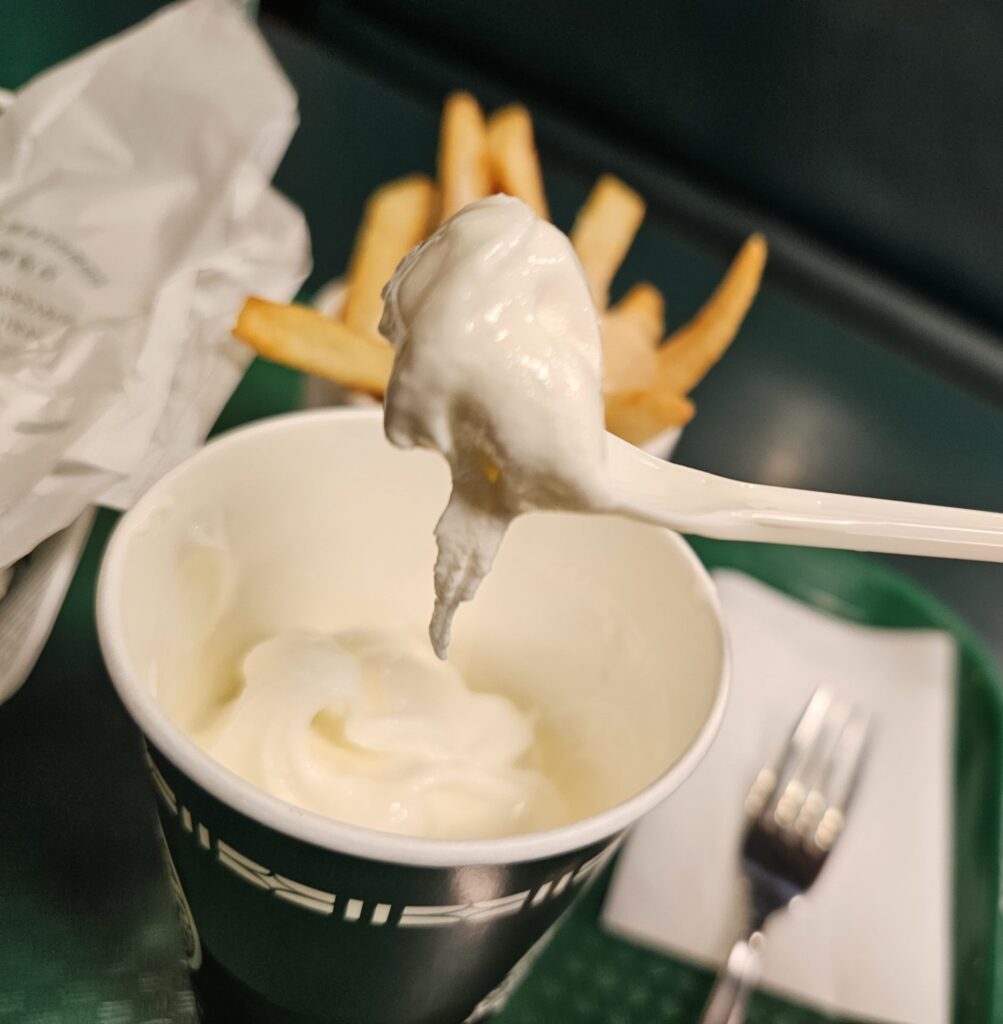
The Verdict
When visiting Hakodate Lucky Pierrot is a must visit. It’s pretty much like if you had never eaten In N Out, you 100% are going to to give it a try if you visit a state that has it. Lucky Pierrot is the In N Out of Hakodate. If you’re visiting Hakodate, you have to try it.
The food that I had was pretty good and very affordable. Nothing really stood out as something that was mind blowing good, but I only had the Chinese Chicken Sandwich and there’s a ton of other options to choose from. The ambience is fun and it’s just a fun to place to come in and grab a quick bite to eat. If you’re not a fan of clowns though, maybe skip it.
-
The Hakodate Morning Market Is A Top Destination When Visiting Hakodate
What is the Hakodate Morning Market?
The Hakodate Morning Market is open from 5 am to about 2 pm, but that can vary by stall / restuarant. The location is very convenient since it’s right across the street from the JR Station. This is a four block stretch in Hakodate that sells fresh seafood, vegetables, fruit, and snacks.
There’s a couple of additional, larger buildings in the area that houses more stalls and restaurants. There’s about 250 places total in this area but it never seems all that dense unlike the Tsukiji Outer Market in Tokyo. That has to do with Hakodate in general being less touristy, so there’s less people, which is quite nice actually.

The main drag of the Hakodate Morning Market 
The Seafood
The Steamed Crab Bun
The main draw of coming here is of course the food. Specifically the seafood and the fruit. There’s several types of crab, uni, squid, salmon eggs, scallops, other shell fish, and a whole lot more at this market. As you’d imagine, it’s all very, very good.
To start the morning off I decided to grab a steamed crab bun (450 yen, $3.06).
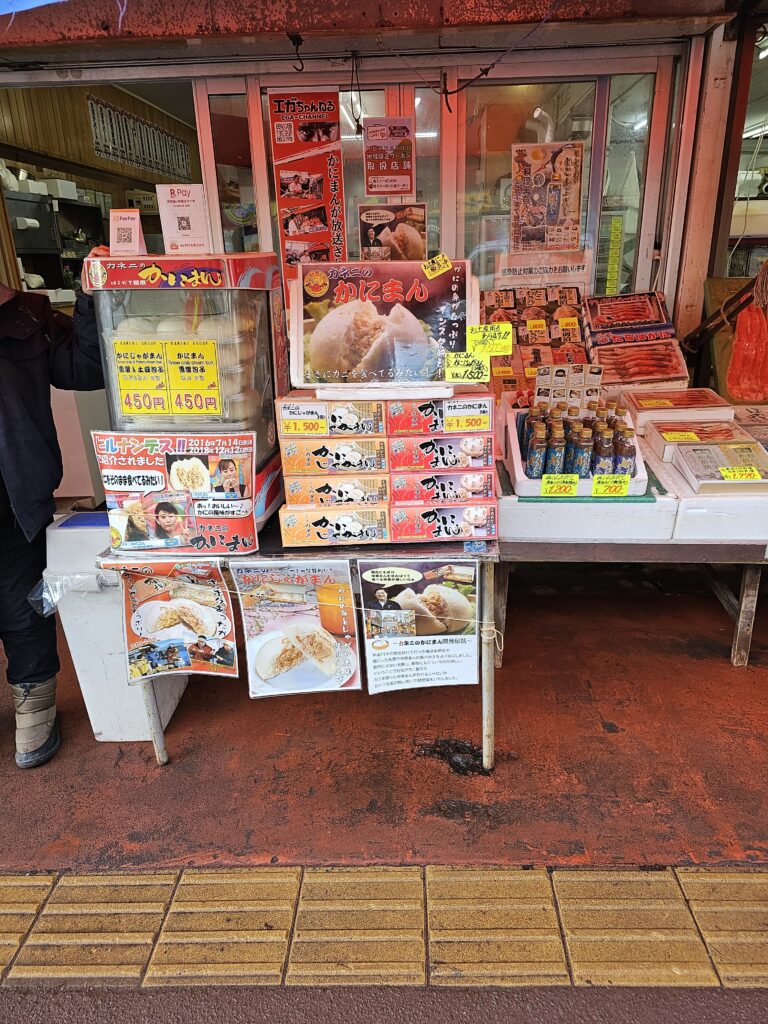
The stall that sells the crab buns 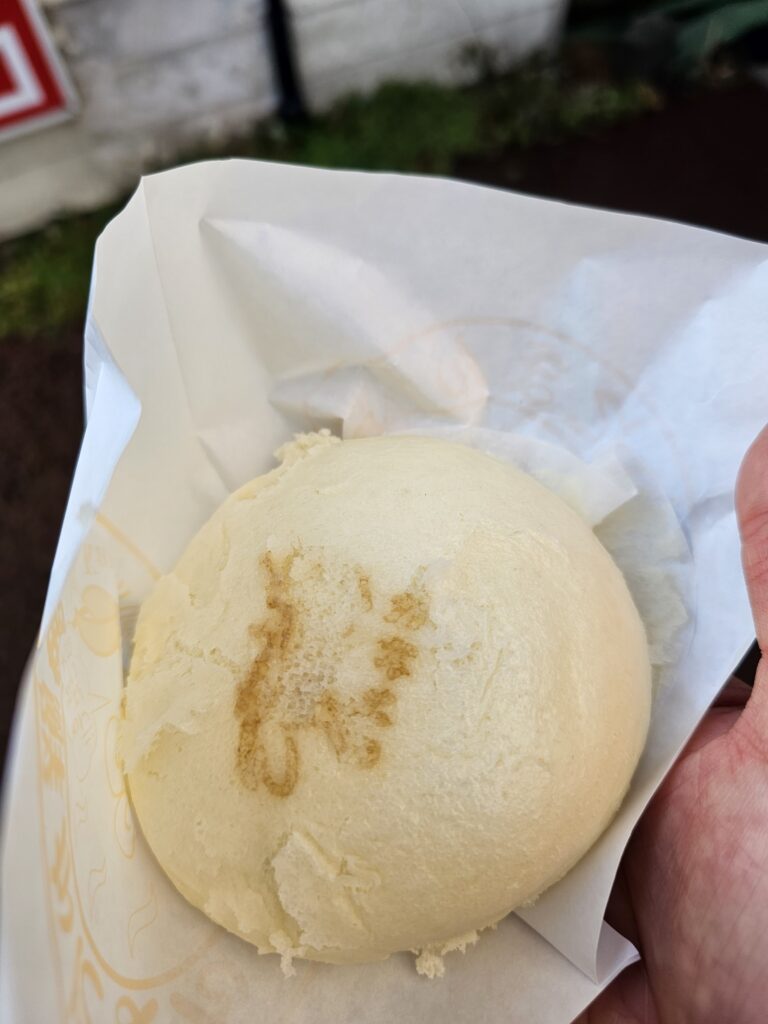
The steamed crab bun 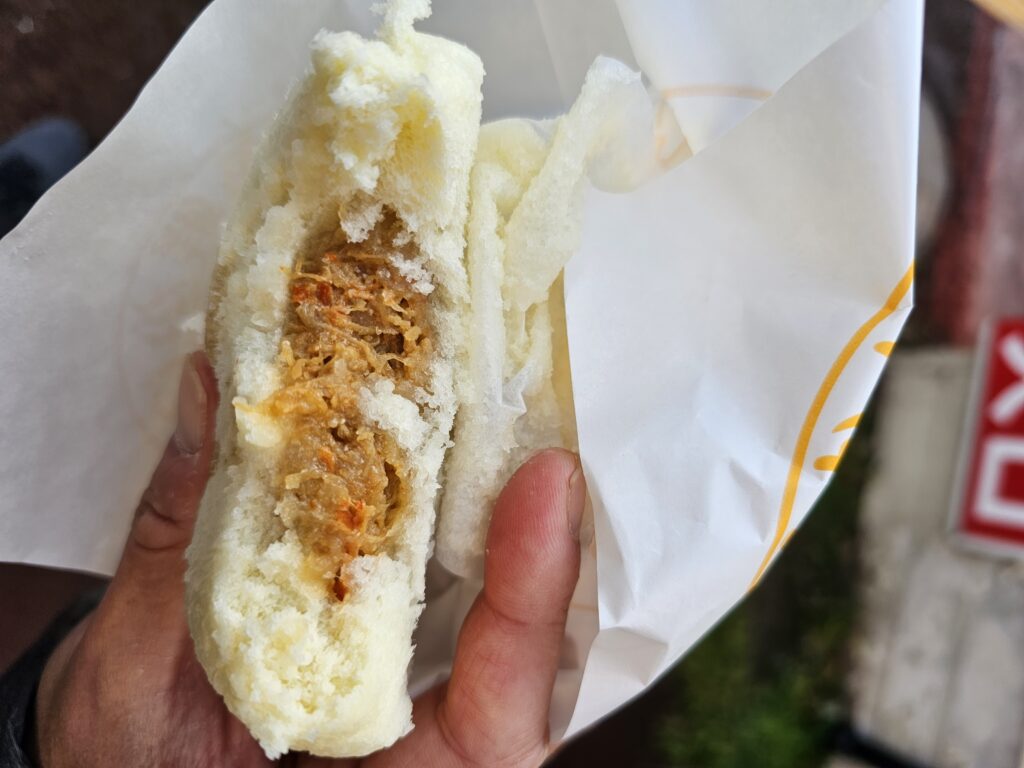
The filling of the crab bun The dough was very light and airy. The filling is a combination of snow crab mixed with some onion and bits of carrot in some kind of sweeter sauce. It’s a little salty and sweet at same time. Crab meat taste gets a little washed out due to all the other ingredients but pretty good.
Donburi
Ikuratei
Now this was something I was looking forward to the most. Donburi is rice-bowl dish that consists of fish, meat, vegetables, or other ingredients. It’s a very popular meal throughout Japan. In the Hakodate Morning Market there are TONs of places that offer donburi with some of the freshest seafood you can find.
There’s a building on the main strip of the market that houses a bunch of restaurants. They all serve pretty much the same type of foods with the same kinds of seafood donburi, with subtle differences. The displays, like the below, showcase all the different types of donburi that restaurant makes and these line the one hallway of the building.
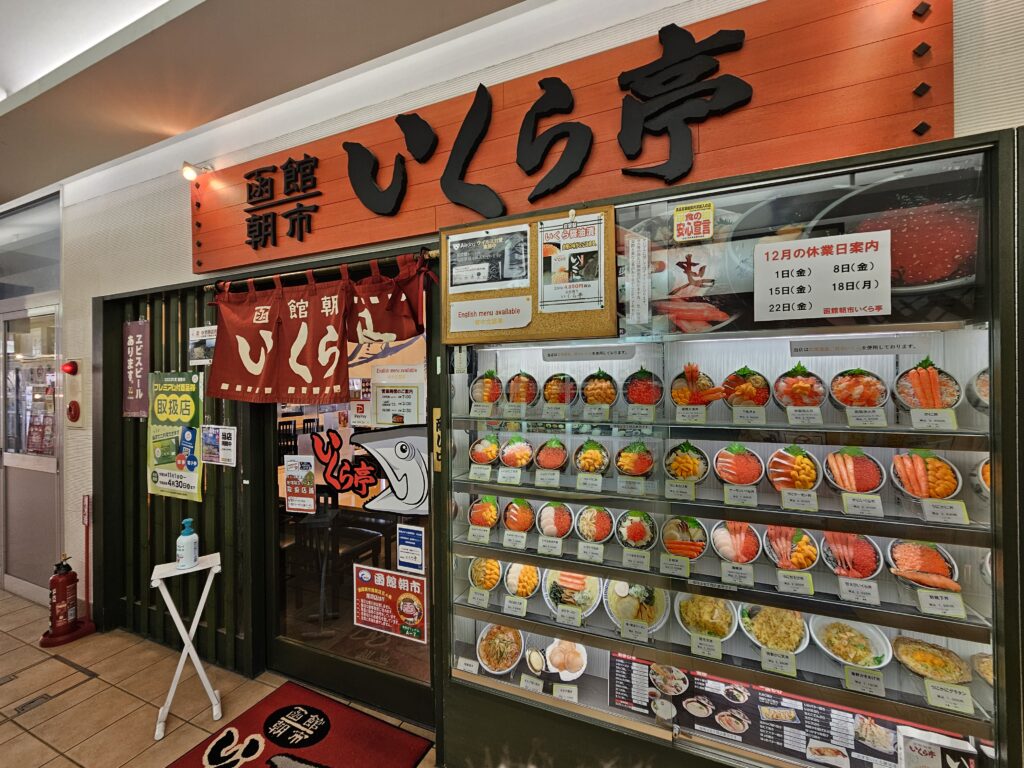
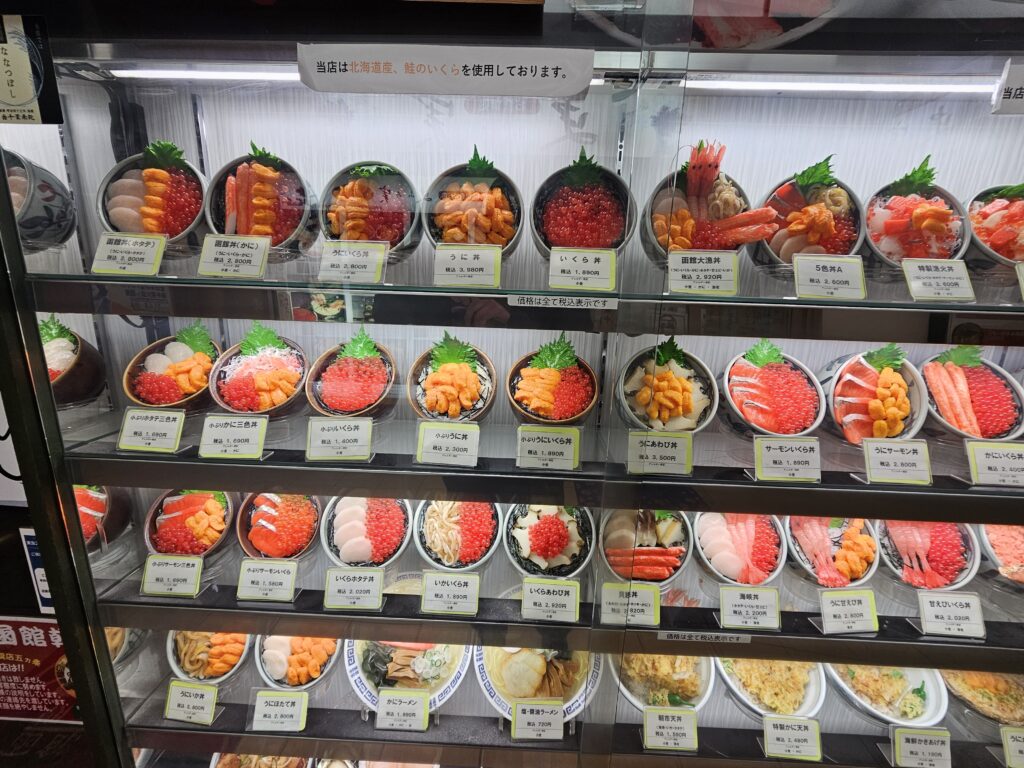
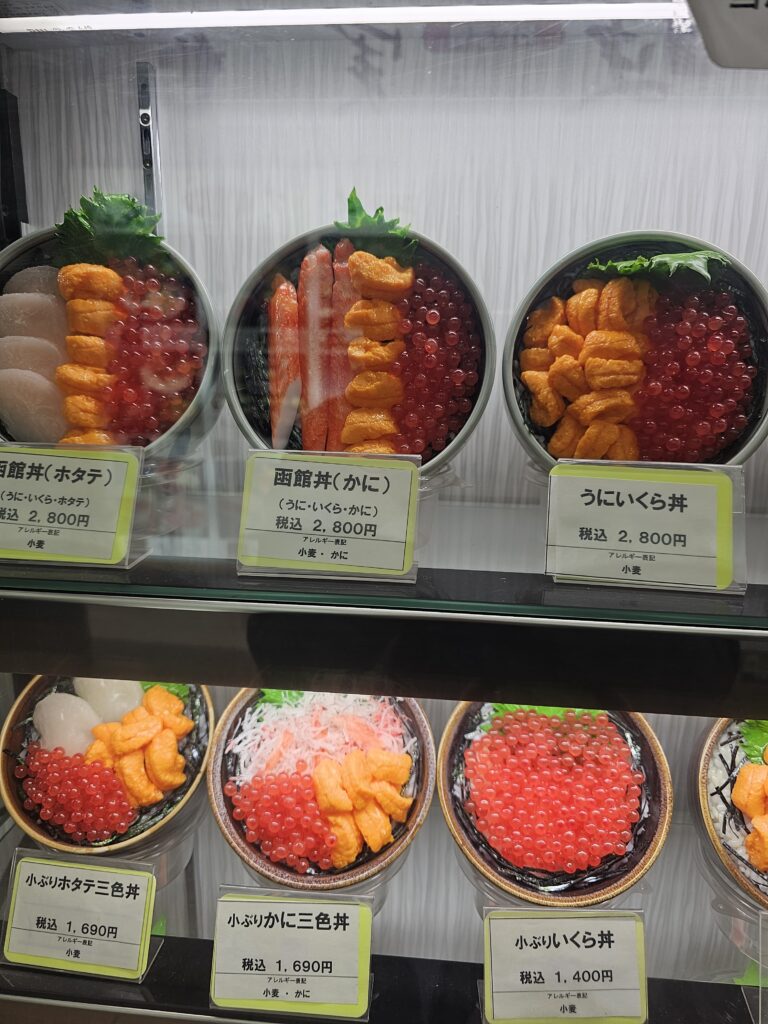
I ate at a couple of the places during my stay in Hakodate with the first being called Ikuratei. The menu is pretty extensive. There’s a lot of different types of donburi to choose from so it can be a tough choice sorting through all the options. It’s odd to be eating fresh fish at about 8 or 9 in the morning but you get used to it and it’s VERY good.
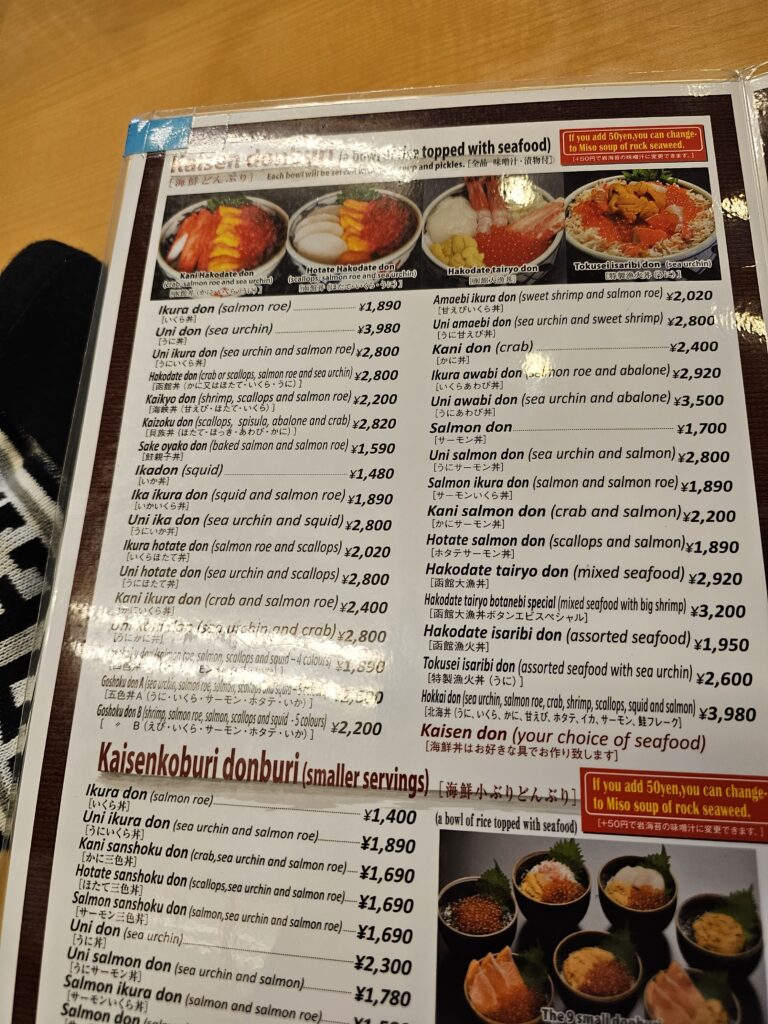
I went with the crab, salmon roe, and uni bowl (2800 yen, $19.03) which came with miso soup and pickled vegetables.
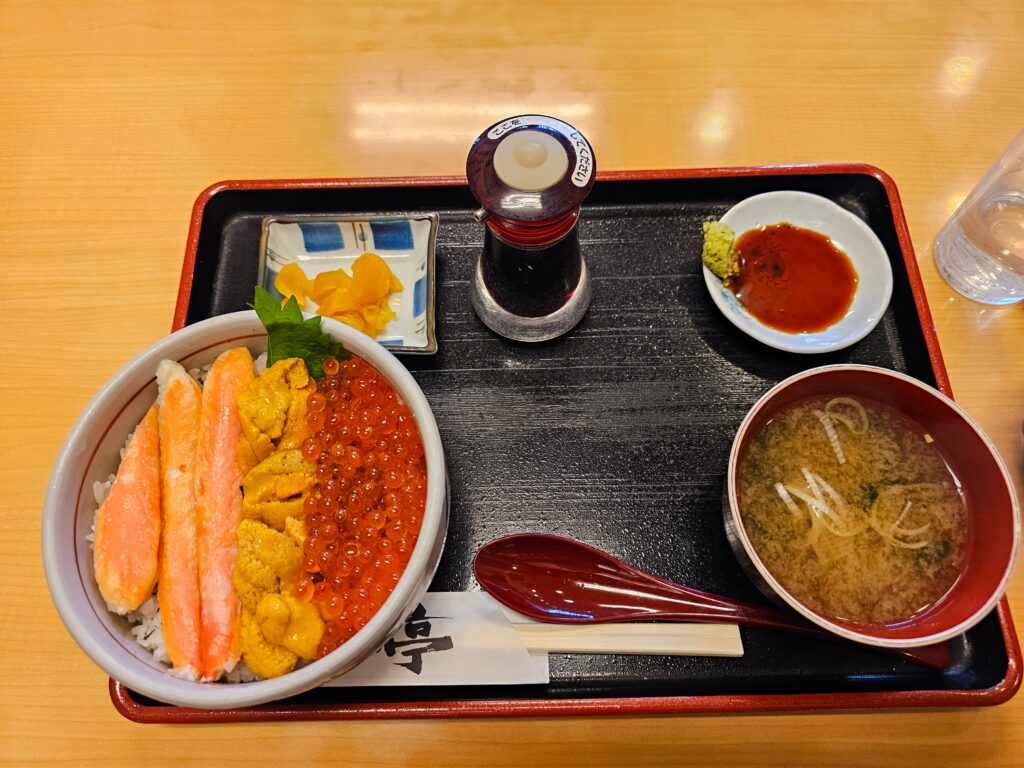
This definitely beats a bowl of cereal for breakfast The crab was insanely sweet and quite salty on its own. I didn’t need to add anything or dip it into any soy sauce. It was the best tasting crab I can ever remember having.
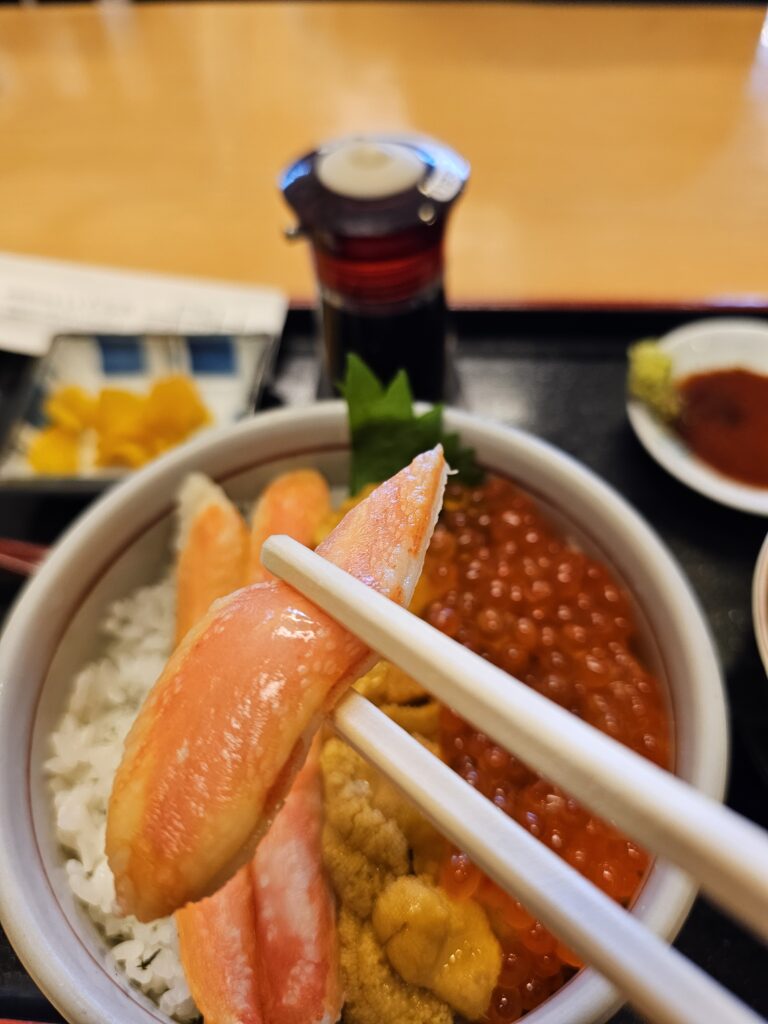
The uni just melted in my mouth. It has that real intense seafoody taste before dissolving. Extremely creamy adn the deep sea taste was quite memorable.
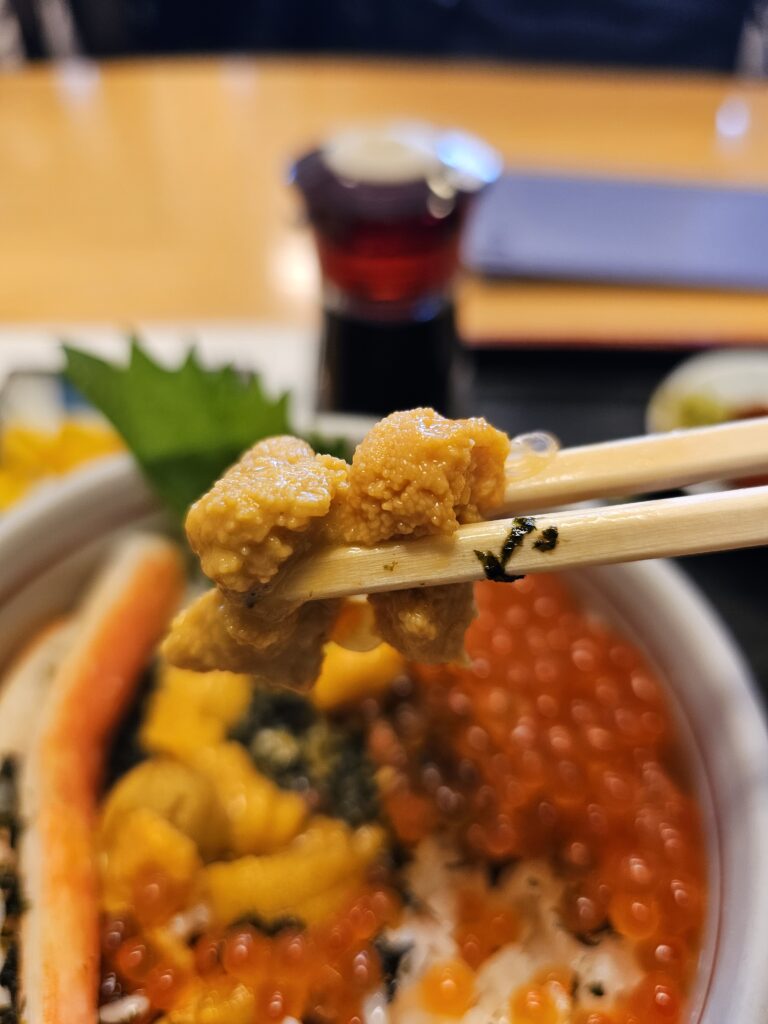
The salmon roe provided a totally different texture to the bowl with that nice popping, burst of flavor with each bite.
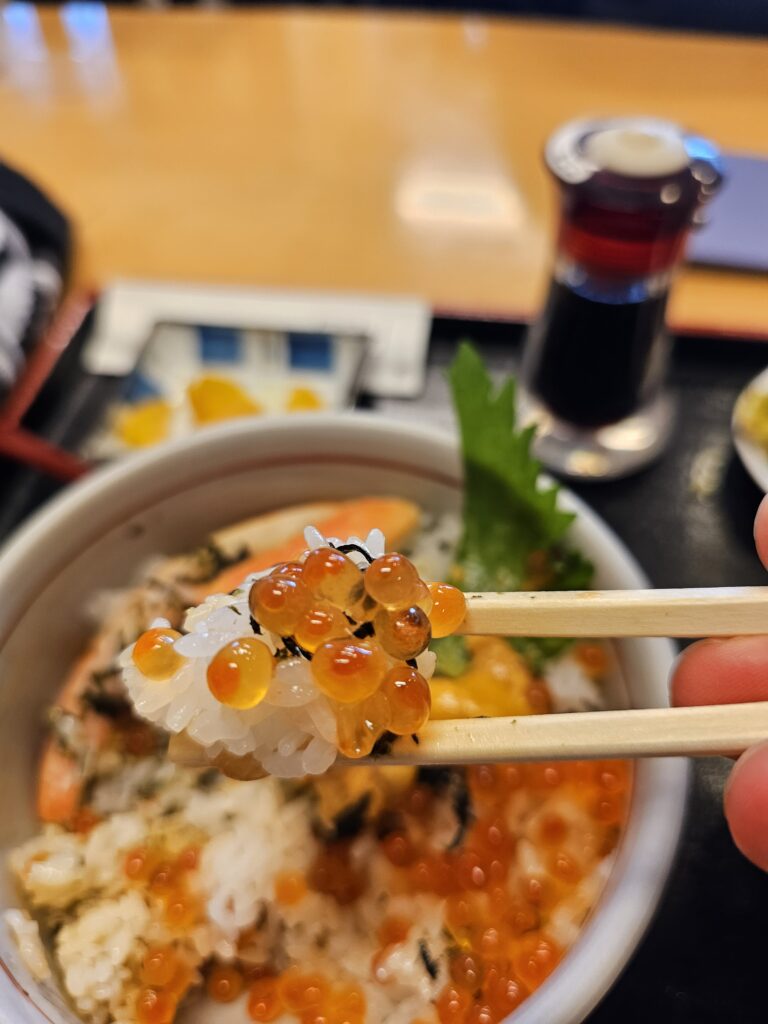
Everything blends together so well. Drizzling some soy sauce over the bowl enchances the flavor as well. The highlight for me was the crab. I couldn’t believe how naturally sweet and salty it was!
Maruishi Shokudo
The second restaurant I went to within the market was called Maruishi Shokudo which was located in the same building as Ikuratei. The menus were very similar. The combination of what kind of seafood was on top of the donburi would be somewhat different from restaurant to restaurant.
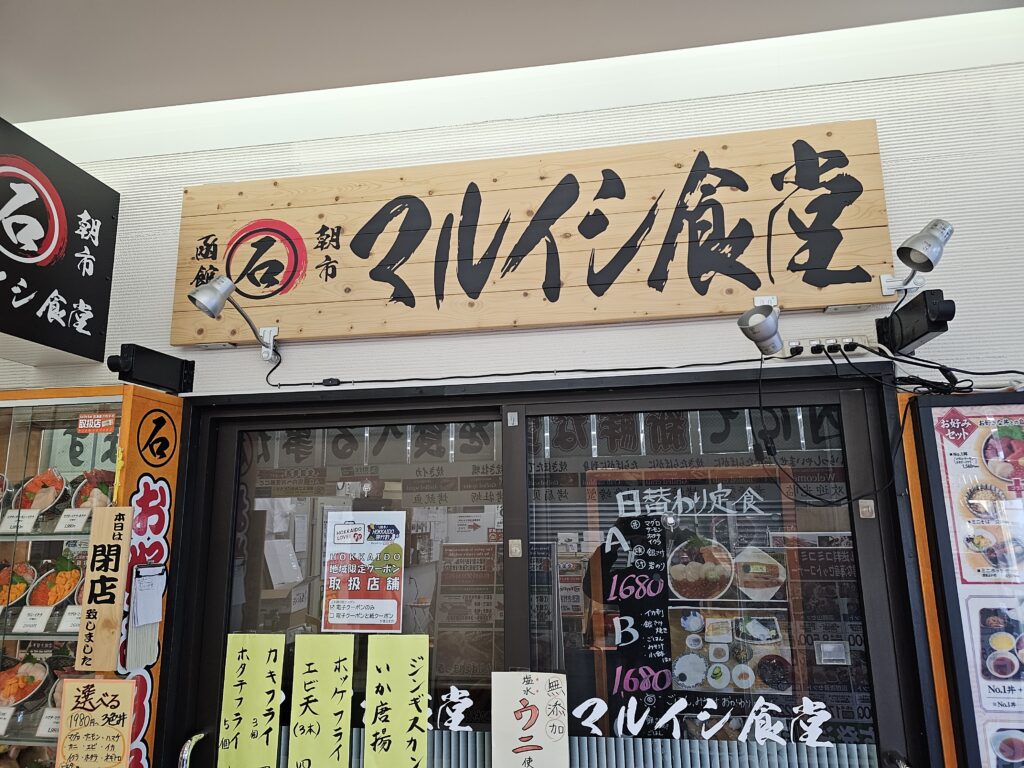
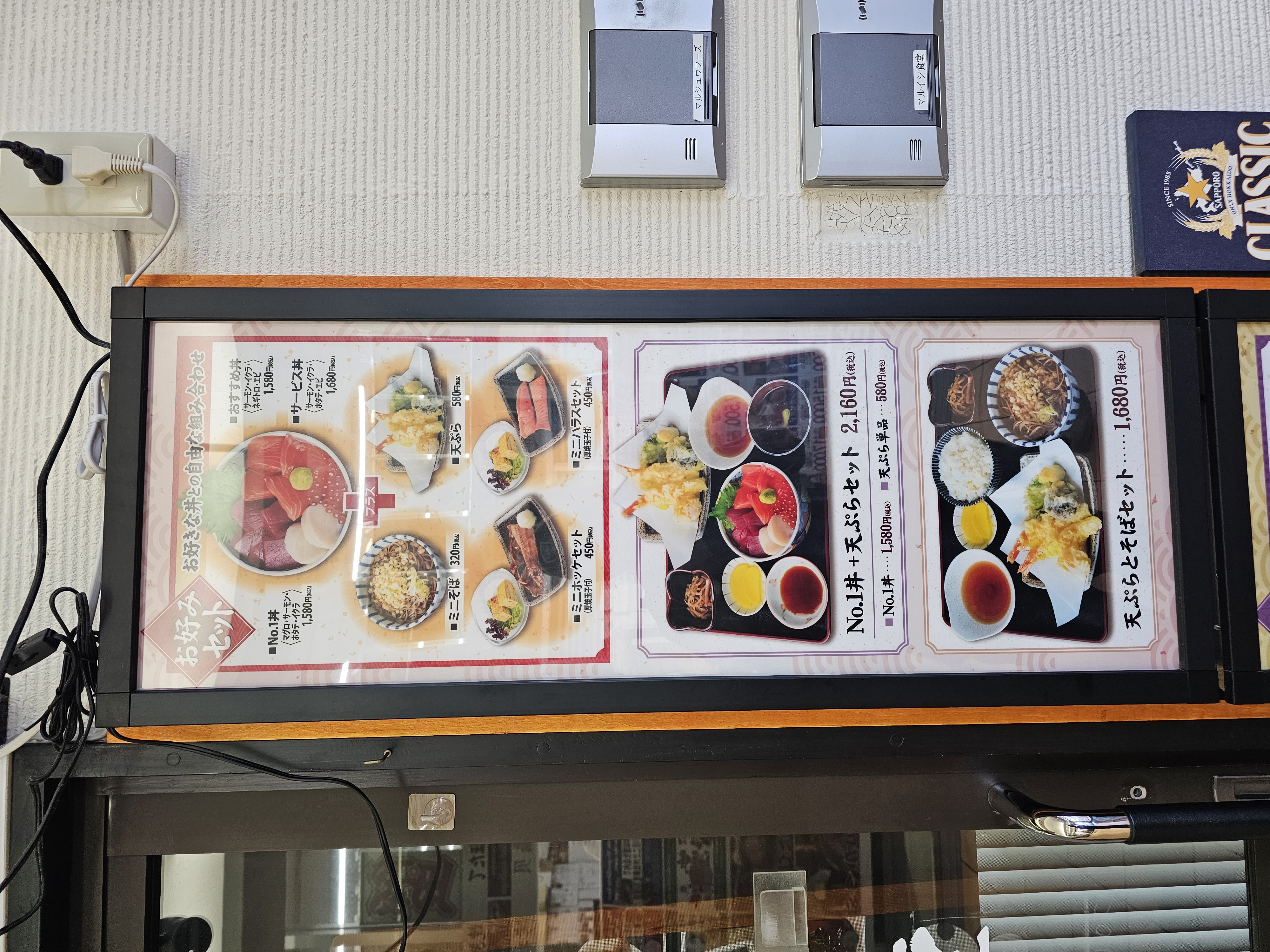
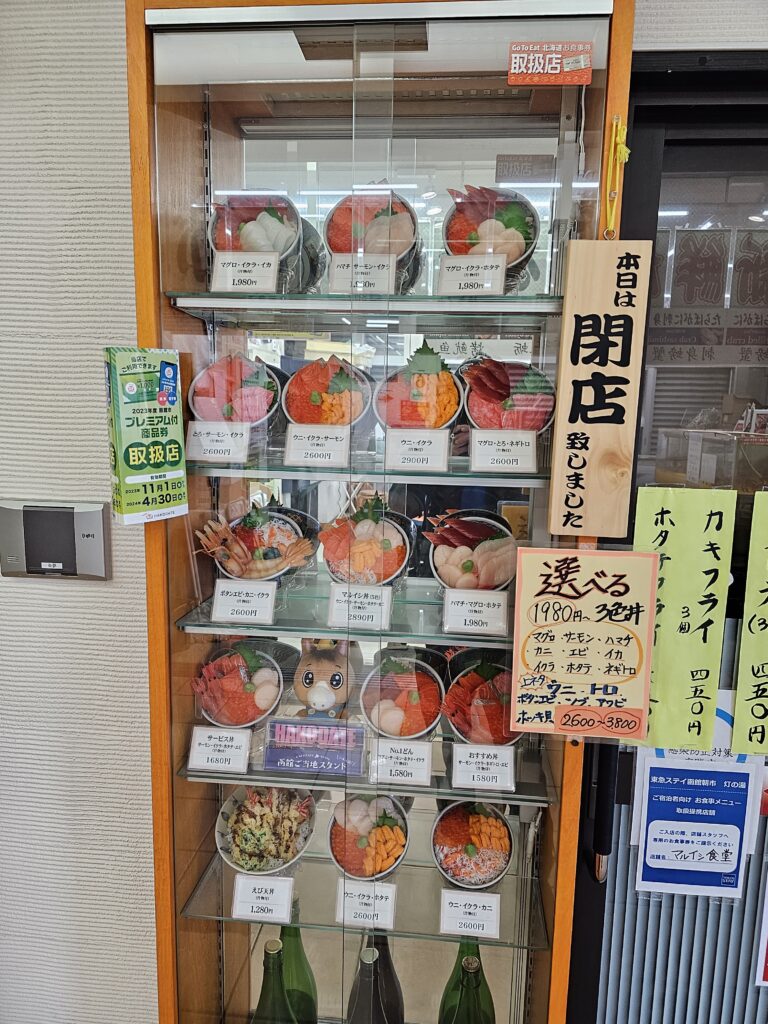
Maruishi Shokudo stood out to me because they had a bowl that included scallops, tuna, and yellowtail (1980 yen, $13.47). I had scallops the previous night for dinner at another restaurant and they were amazing, so I wanted to double down on them for breakfast.
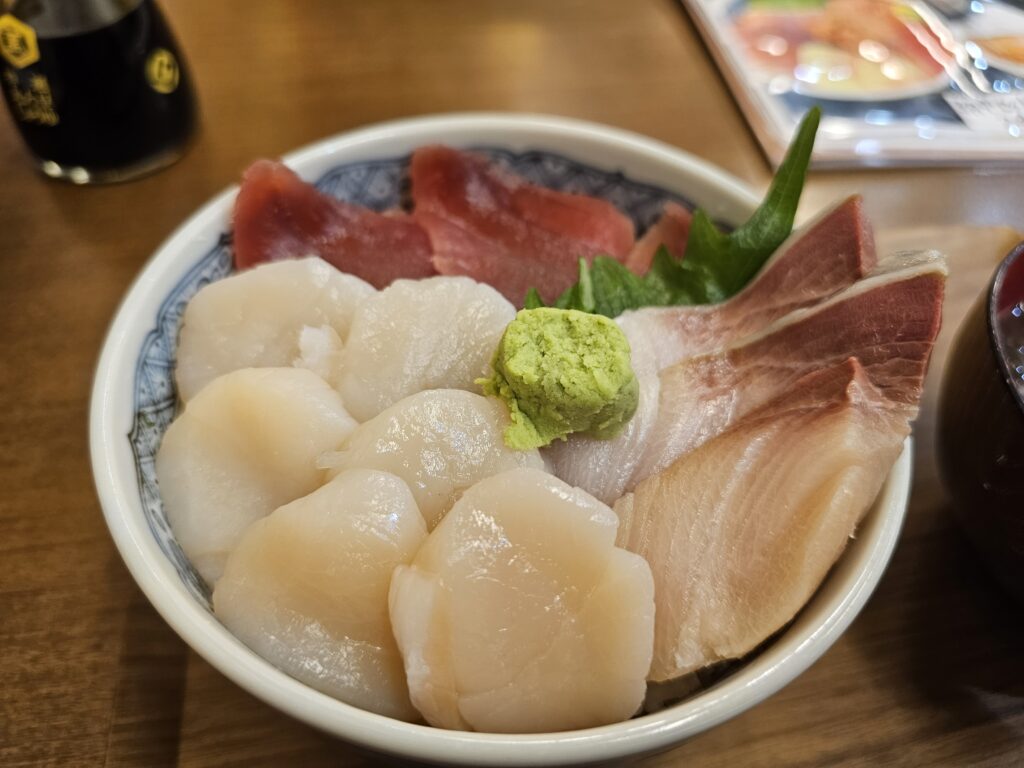
The scallops were tender and extremely sweet. So good!
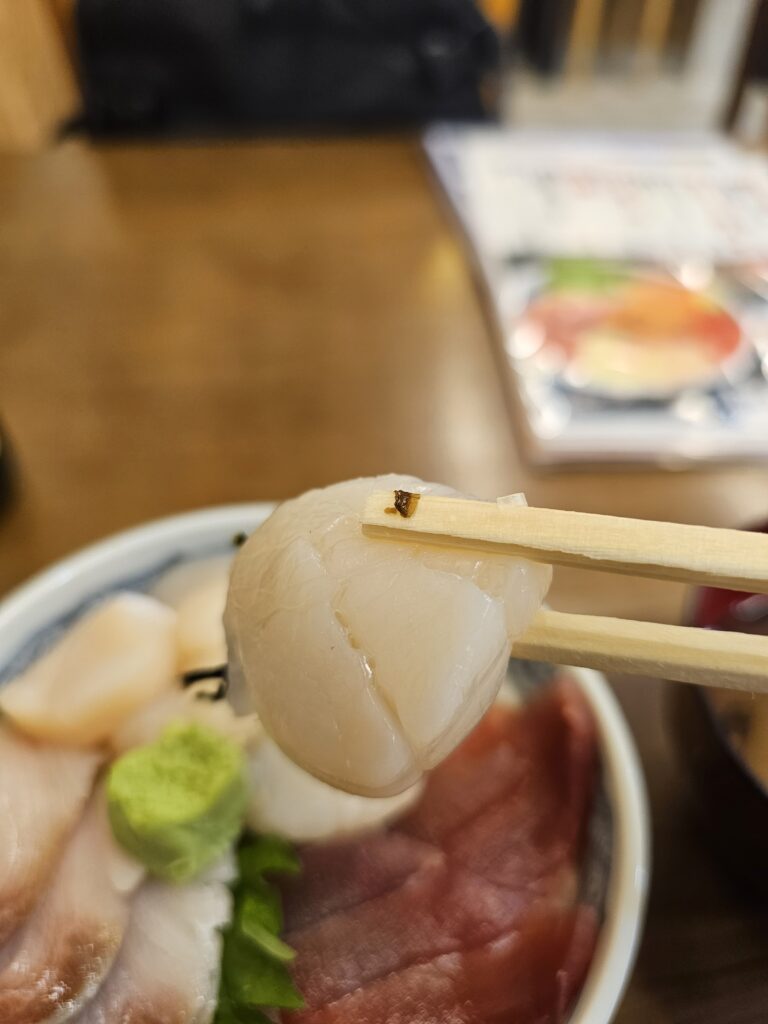
Both the tuna and yellowtail just melted in my mouth. No chewy parts at all.
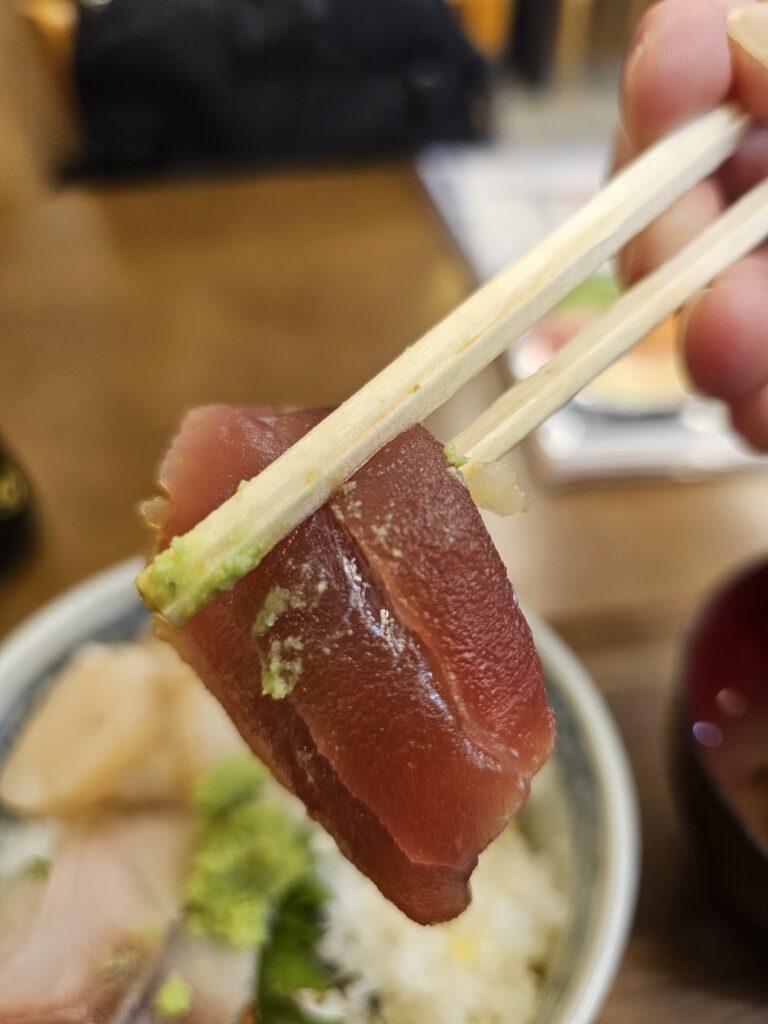
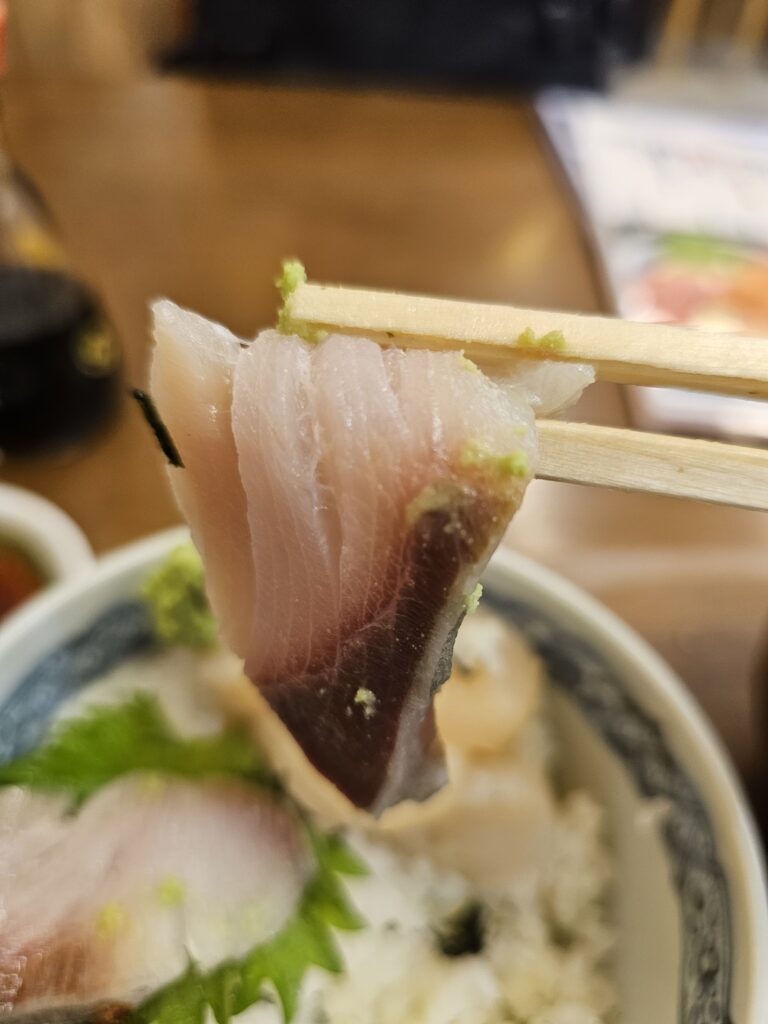
The scallops and fish were extremely fresh. Another outstanding donburi bowl. The seafood and donburi bowls are must gets when visiting the Hakodate Morning Market. Very affordable and just amazing seafood!
The Produce
Something that also warrants attention at the Hakodate Morning Market is the produce. Hokkaido is the largest agricultural area in Japan and produces many fruits and vegetables. The corn and melons are a couple of the notable products from Hokkaido so I had to try them!
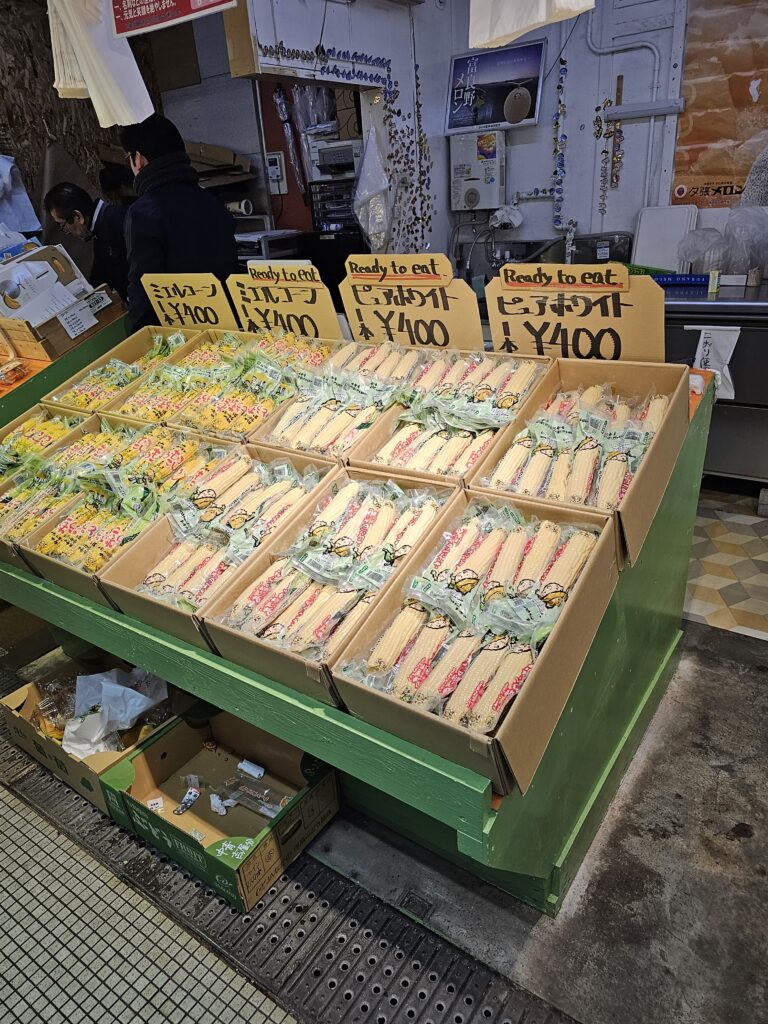
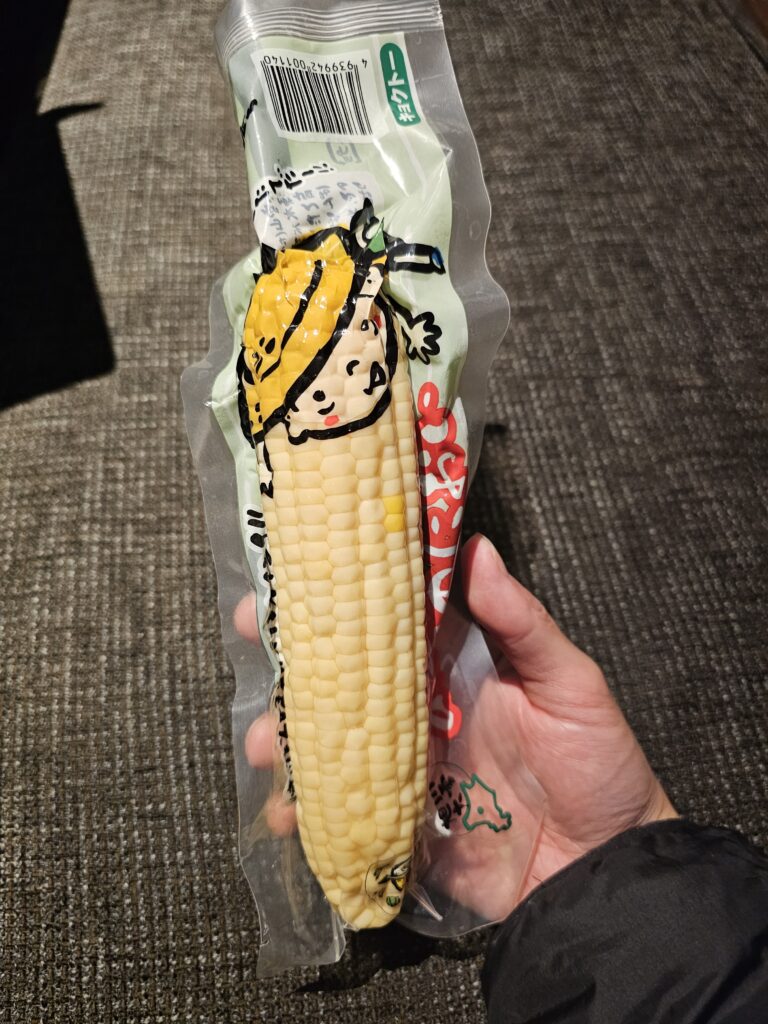
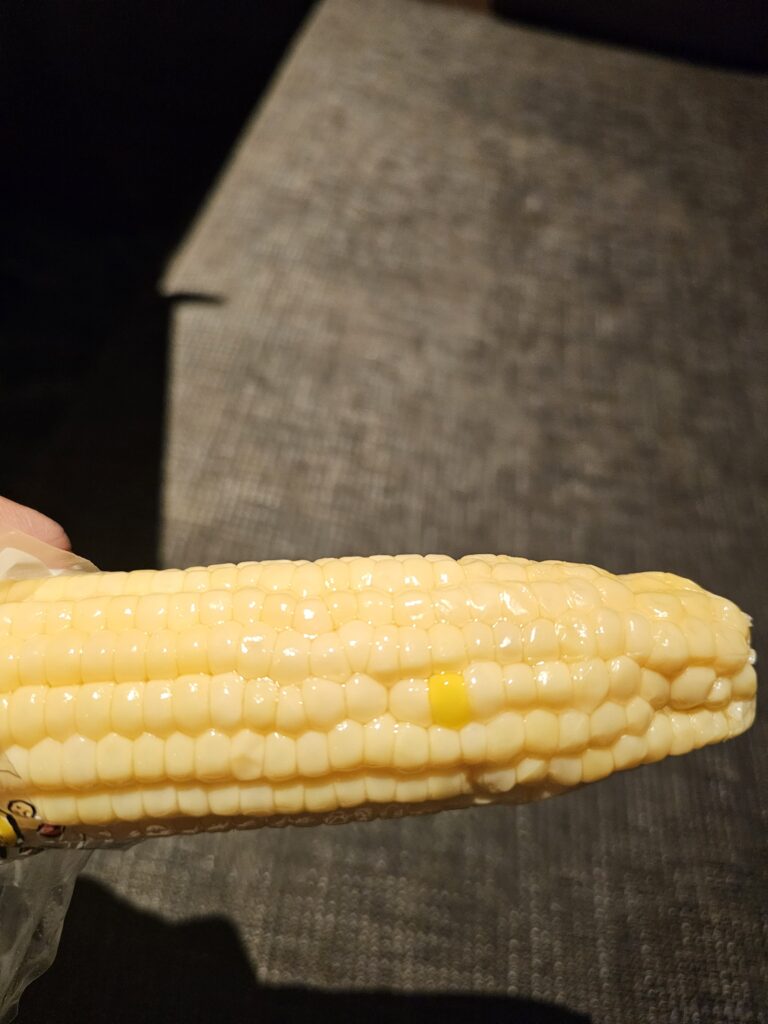
At hte morning market you’ll find stalls with vendors selling individually plastic wrapped corns like the above photos. They’re about (472 yen, $2.72) a piece. It’s well worth the price. Once you unwrap the corn it’s ready to eat. It’s hands down the sweetest corn I’ve ever eaten. It tasted like cream of corn. It’s pretty insane how sweet the corn was.
Many of these same stalls and vendors will sell slices of Hokkaido cantaloupe as well (500 yen, $3.40). They’re conveniently cut up so you can use a tooth pick to pick up pieces of the slices.
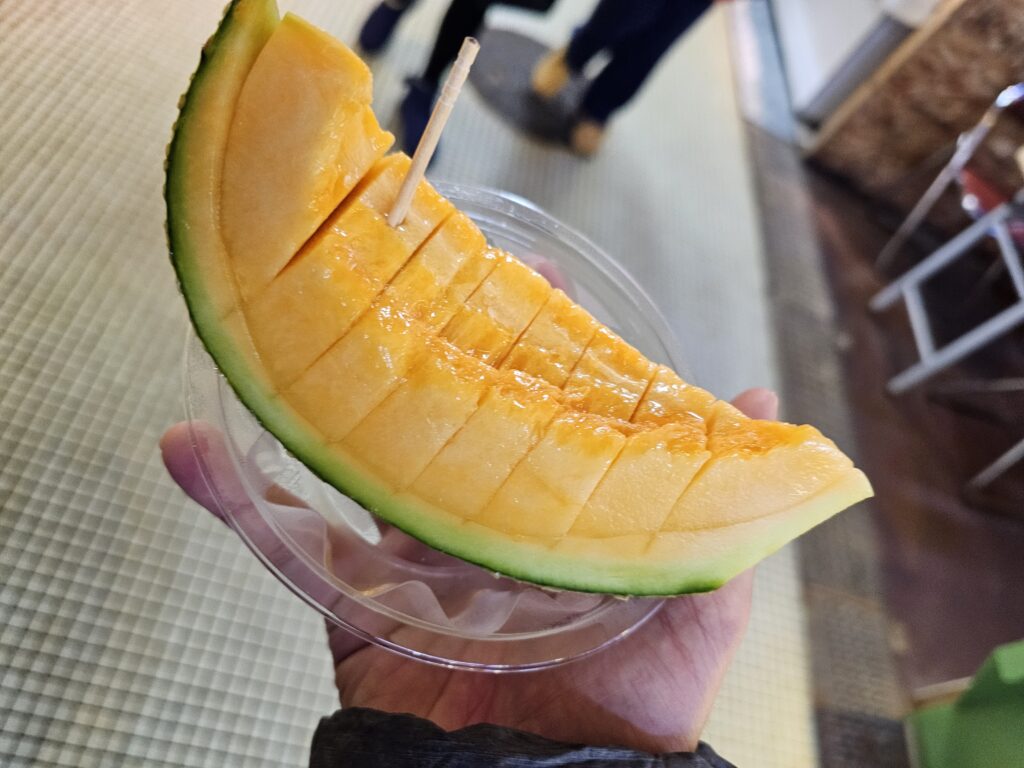
This wasn’t quite as sweet as I anticipated, although this was in December, not exactly prime melon season. The melon was still super juicy , it really explodes with a great cantaloupe flavor. This one was not super sweet though. Still pretty quality. I’m sure in the summer these would be insanely good.
The last bit of produce that I got were strawberries\ (861 yen, $5.86). These were very sweet and very juicy. Super tasty. I was surprised how sweet they were since I didn’t think they’d be in season.
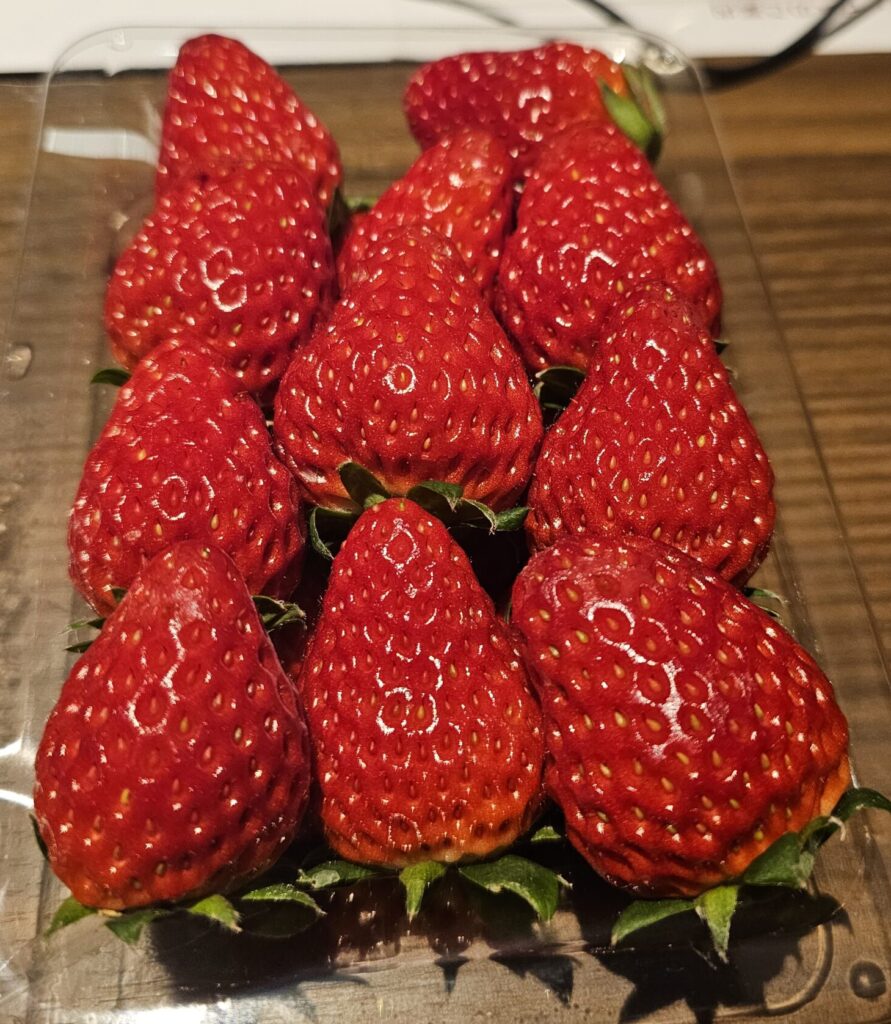
Perfect Place To Start Your Day
The Hakodate Morning Market is great place to kick off your day in Hakodate and grab some of the freshest seafood you can find in the country. It’s not a huge, robust market place, but that’s part of the charm. It won’t take you too long to walk through the entire Hakodate Morning Market but it might take some time to figure out what you want to eat exactly. There’s A LOT of seafood to try here and you certainly should try to fill yourself up with as much as your wallet will allow. I definitely recommend grabbing as much of the produce as you can too!
